SecuEasy Electronic SEWIFIIPCVW WiFi IP Camera User Manual
Shenzhen SecuEasy Electronic Co., Ltd. WiFi IP Camera
User Manual

IP Camera
User Munual
Important Safeguards and Warnings
Do not place heavy objects on the DVR.
Do not let any solid or liquid fall into or infiltrate the DVR.
Please brush printed circuit boards, connectors, fans, machine box and so on regularly. Before
the dust cleaning please switch off the power supply and unplug it.
WIFI
(DVR)

Do not disassemble or repair the DVR by yourself. Do not replace the components by yourself.
Environment:
Please place and use IP camera under temperature between-10℃~60℃and humidity less
than 9%;
Do not use IP camera in smoky or dusty environment;
Avoid collision or strong fall.
Please insure the IP Camera level installation in a stable workplace.
Please install in ventilated place. Keep the vent clean.
Use within the rating input and output scope.
Suitable products:
This manual is suitable for all series of IP Camera from our
company, including indoor box type, IR waterproof type, whelk type,
dome type, home-use robot type, etc.
Special announcement:
The content including in this manual is refer to the most updated information when
compilation, if there is something to be changed, will not further notice specially.
If got questions or requirement, please feel free to contact us at any time.

Catalogue
Chapter One:
Product introduction
1.1 Product summary
The series DVR is designed specially for security and defence field which is an outstanding
digital surveillance product. It introduces embedded LINUX operating system which is more stable. It
introduces standard H.264mp video compressed format and G.711A audio compressed format which
insures the high quality image, low error coding ratio and single frame playing. It introduces TCP/IP
network technology which achieves the strong network communication ability and telecommunication
ability.
The IPC can online applied as a part of a safety surveillance network. With the professional network
video surveillance software it achieves the strong network communication ability and telecommunication
ability. And IPC can individually work also.
It is applied to all kinds of occasion that need network remote monitoring, such as:
ATM, Bank counter, supermarket, factory, etc.
Foster care center, kingdom garden, school, etc.
Intelligent gate control system.
Intelligent building and residential manage system
Unattended system like: Generating plant, telecom base station
Outdoor device to monitor bridge, tunnel, block transportation status
Production line and warehouse control.
24-hour monitor for road transportation.
Remote monitor for forest, water source and river.
Airport, train station, bus stop, etc.

1.2 Porduct main function
Real-time surveillance
·with analog output interface can do surveillance through device of monitor or DVR, etc.
Compression format
· Audio and video signal is compressed by individual hardware, to make the image and voice
synchronously stable
Video playback function
·can do full real-time record, and search, net surveillance, video search and download, etc.
·support play back mode of fast-play, slow-play, etc.
·can do partial enlargement of any of the area
Network operation function
·can remote surveillance via network (including mobile)
·remote PTZ control
·remote video search and realtime playback
Alarm linkage function
·alarm link to record, snapshot, email sending, etc.
Telecom interface
·with RS485 interface for PTZ control
· with Ethernet port for remote access function , remote upgrade & maintaince function.
Intelligent operation
·for the same setting operation on menu can do copy & paste operation.

Chapter Two: Open case checking and cable connection
2.1 Open case checking
When you receive this product,
Firstly, check model No. on product is the same as what you ordered;
Then, check if there is obvious damage on packing, the protective material used for packing can
afford most unexpected strike during transportation;
Finally, please take out IPC and remove the protective covers to check if there is obvious damage.
2.2 Installation on brace
The IPC is using the standard case, so it can be installed to a standard brace.
Installation steps and attentions:
1、make sure the temperature is between -10℃~60℃ ,humidity is less than 90%;
2、brace installed stable and firmly;
3、outdoor installation please pay attention to the severe weather;
4、when installing multi-device on the same line, please take protective measure to avoid over load
of the line.
2.4 Video output connection
2.4.1 choose and connect video output device
1.BNC output:
BNC video output is divided into: PAL/NTSC BNC(1.0VP-P ,75Ω),can be connected to monitor or
surveillance integrated equipment such as DVR, etc.
BNC output can support preview of the monitor image only.
Make sure the stable and reliable of transmission link:
The video transmission line should adopt high quality coaxial pair which is chosen by the
transmission distance. If the transmission distance is too far, it should adopt shielded twisted pair, video
compensation equipment and transmit by fiber to insure the signal quality.

The video signal line should be away from the electro magnetic Interference and other equipments
signal lines. The high voltage current should be avoided especially.
Insure the connection stable and credible
The signal and shield lines should be firm and connected credible which avoid false and joint
welding and oxidation.
2. Network output:
Connect to LAN and WAN via common standard, using the PC that is in the same LAN line with IPC by
software or IE browser to set parameters, real-time preview, remote playback and download, etc.
When replace the monitor by the computer display, there are some issues to notice.:
1、do not make it running for a long time, in order to extend the using life of device.
2、regularly degauss to keep monitor normally work.
3、Keep away from device with severe electromagnetic interface.
TV is not a credible replacement as a video output. It demands reducing the use time and
control the power supply and the interference introduced by the nearby equipments strictly. The
creepage of low quality TV can lead to the damage of other equipments.
Chapter Three: IE log-in basic operation
Remark: keys in grey means do not support
3.1 Boot
Connect to power, then IPC is auto boot.
Remark:1. Make sure that the input voltage corresponds with the switch of the DVR power supply.
2. Power supply demands: 220V±10% /50Hz.
Suggest using the UPS to protect the power supply under allowable conditions.
3.2 Reboot
Reboot IPC is divided into soft reboot and hard reboot. Soft switch please enter【Devicecfg】>
【Advanced】choose【reboot】;Hard reboot, to cut off power and reconnect it to reboot device
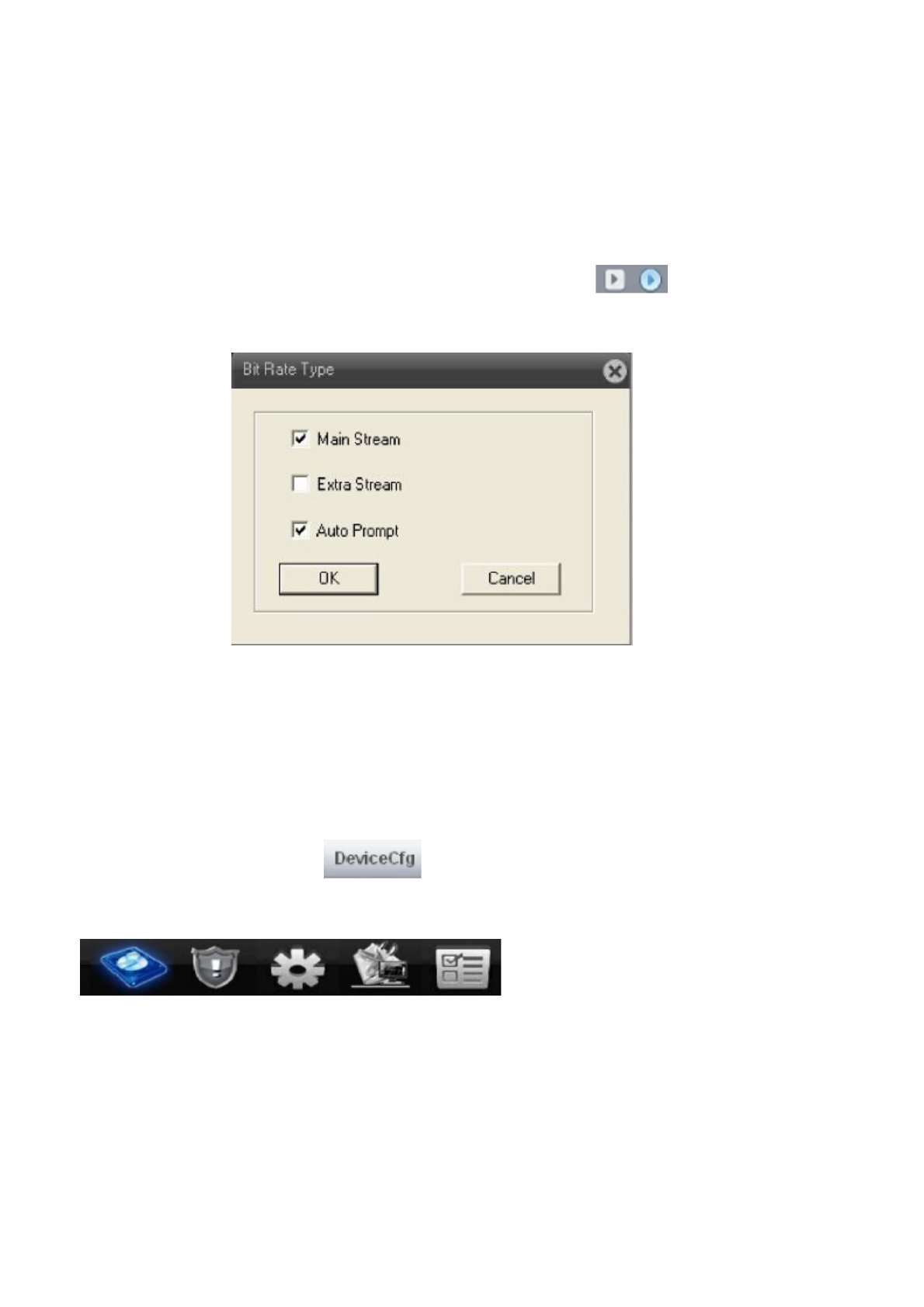
Pic : 3.1 Log-in
For safty sake, when firstly log-in, please go to “Account” to modify user name and
password, see chapter 4.5.2 account manage).
3.4 Preview
After log-in successfully, will come out window of bit rate type as pic 3.2, can choose
the main stream or extra stream u want for preview, and also can click at left side of
preview page to set it.
Pic: 3.2 bit rate type
At preview page, can shows date, time and channel titile.
3.5 Setting menu
On preview mode, click at top side ,,will come out window as pic:3.3.setting
menu function including: Record, Alarm, System, Advanced, Info. Click icon at bottom side
will enter related next menu of this function.
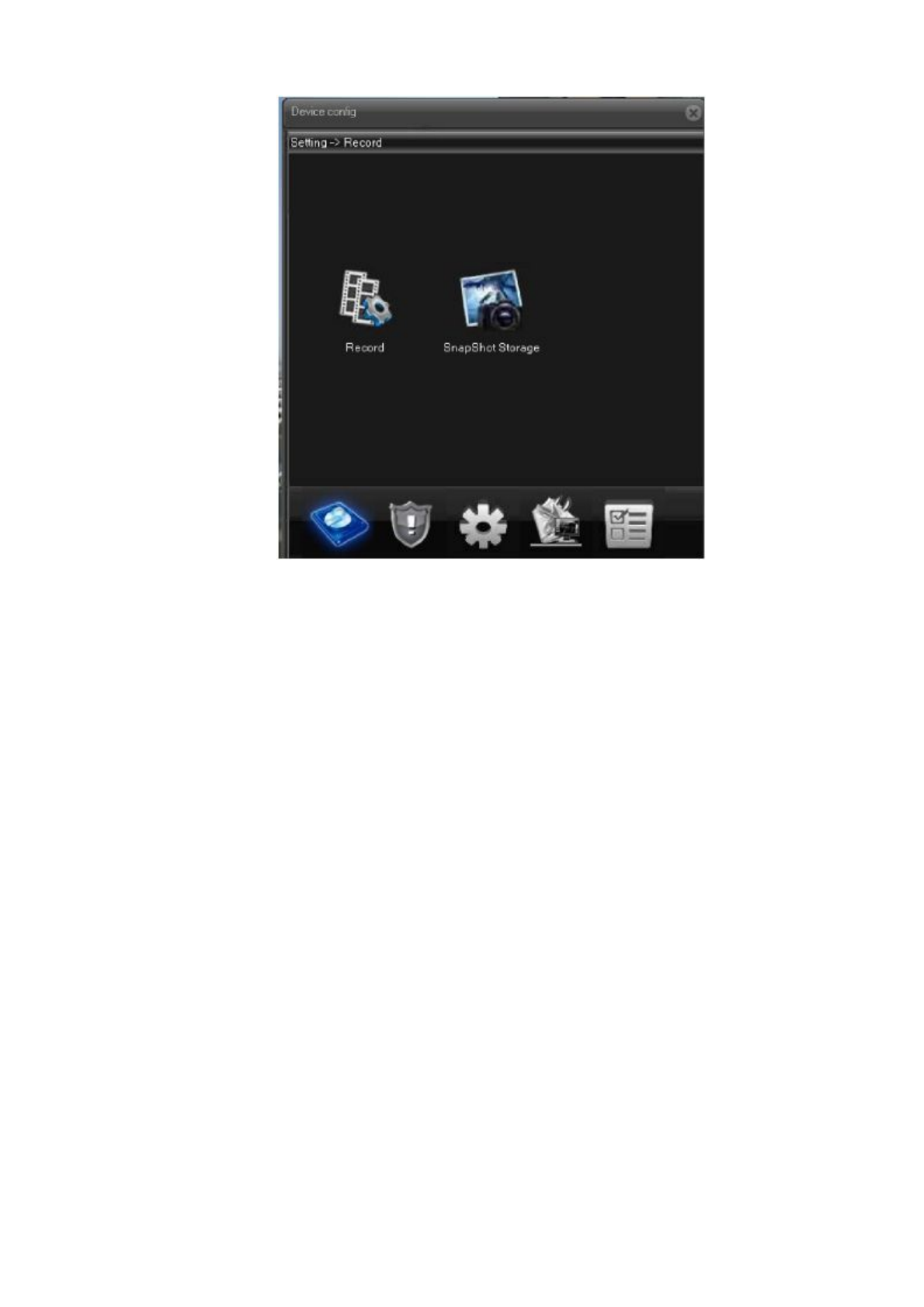
Pic: 3.3 shortcut menu
3.5.1 Record
Record function including: device record and snapshot settings.
1. Record setting
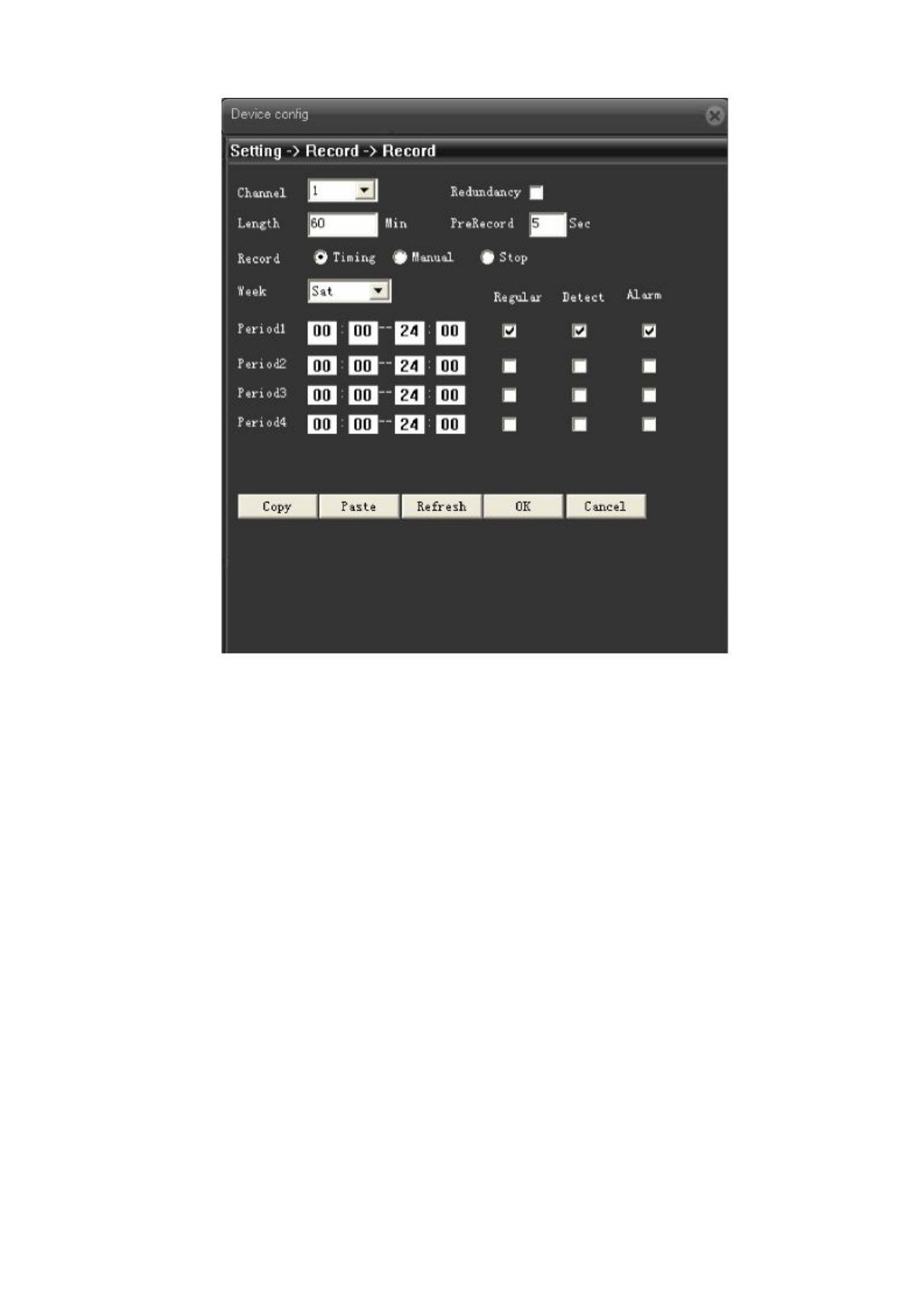
Pic: 3.4 Record setting
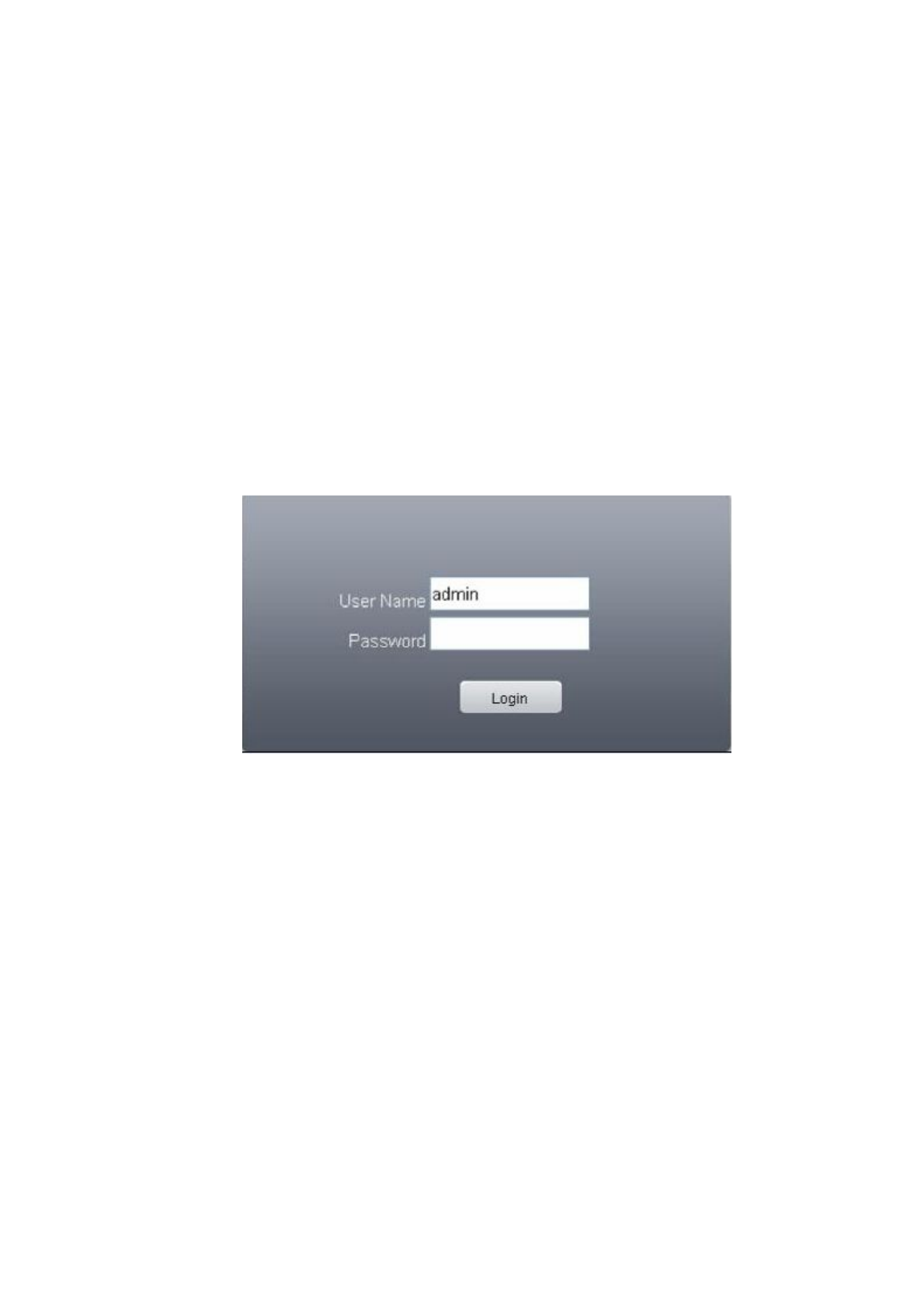
3.3 Log-in
When device turns on normally, need to log-in before operation, system will base on the authority
of
log-in user to provide related function.
Default IP address:192.168.1.10,subnet mask:255.255.255.0,gateway:192.168.1.1
When device ex-fty, there are 3 preset users : admin、guest、default,default password is none,
admin is preset as super authority user, guest and default is preset with authority of preview and
playback, admin and guest user can modify password but not authority, default is the user default
log-in,
can modify authority but not password
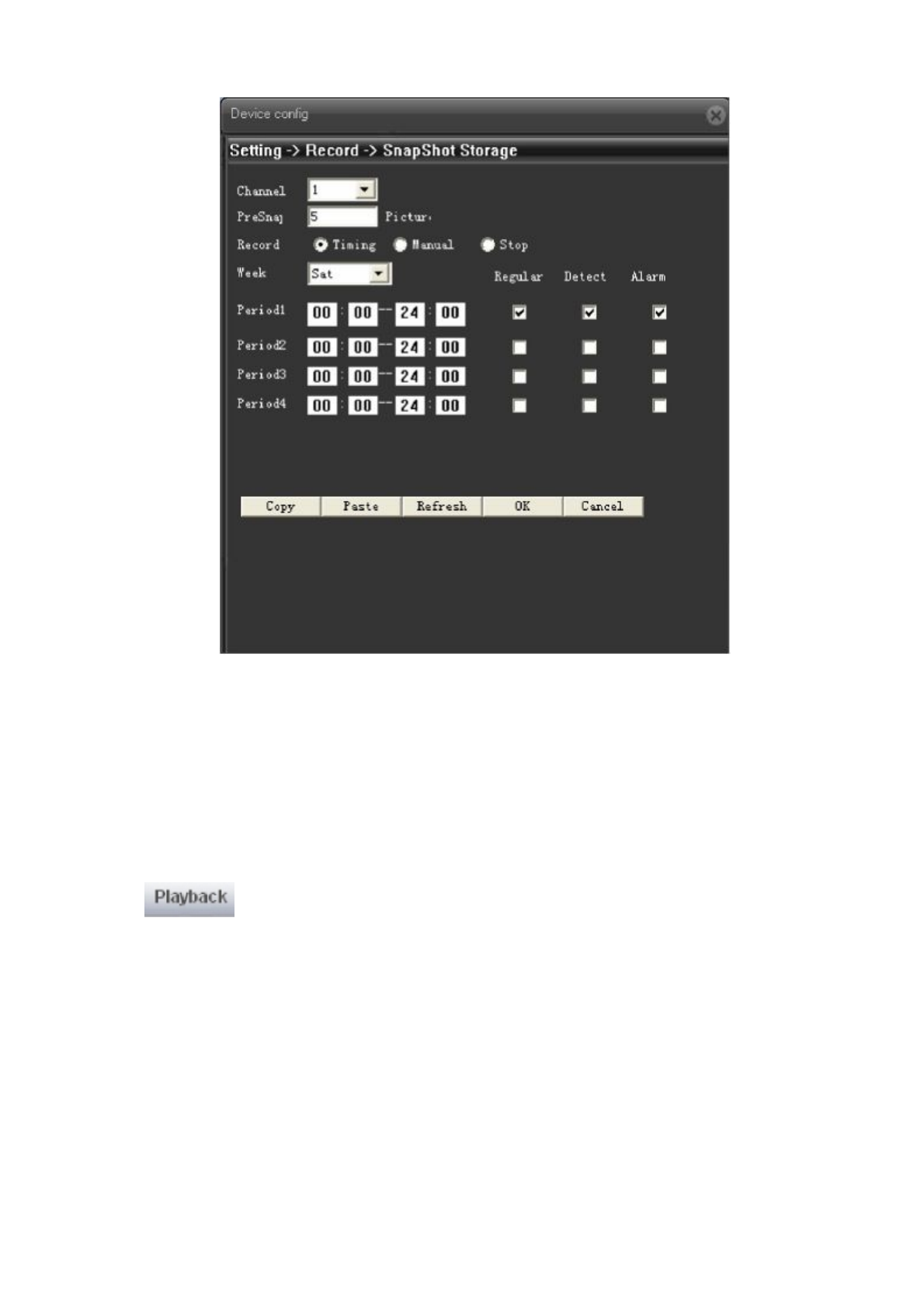
Pic: 3.5 Snapshot setting
3.5.2 Playback
click
at upper left side on monitor page, to enter video
playback page.
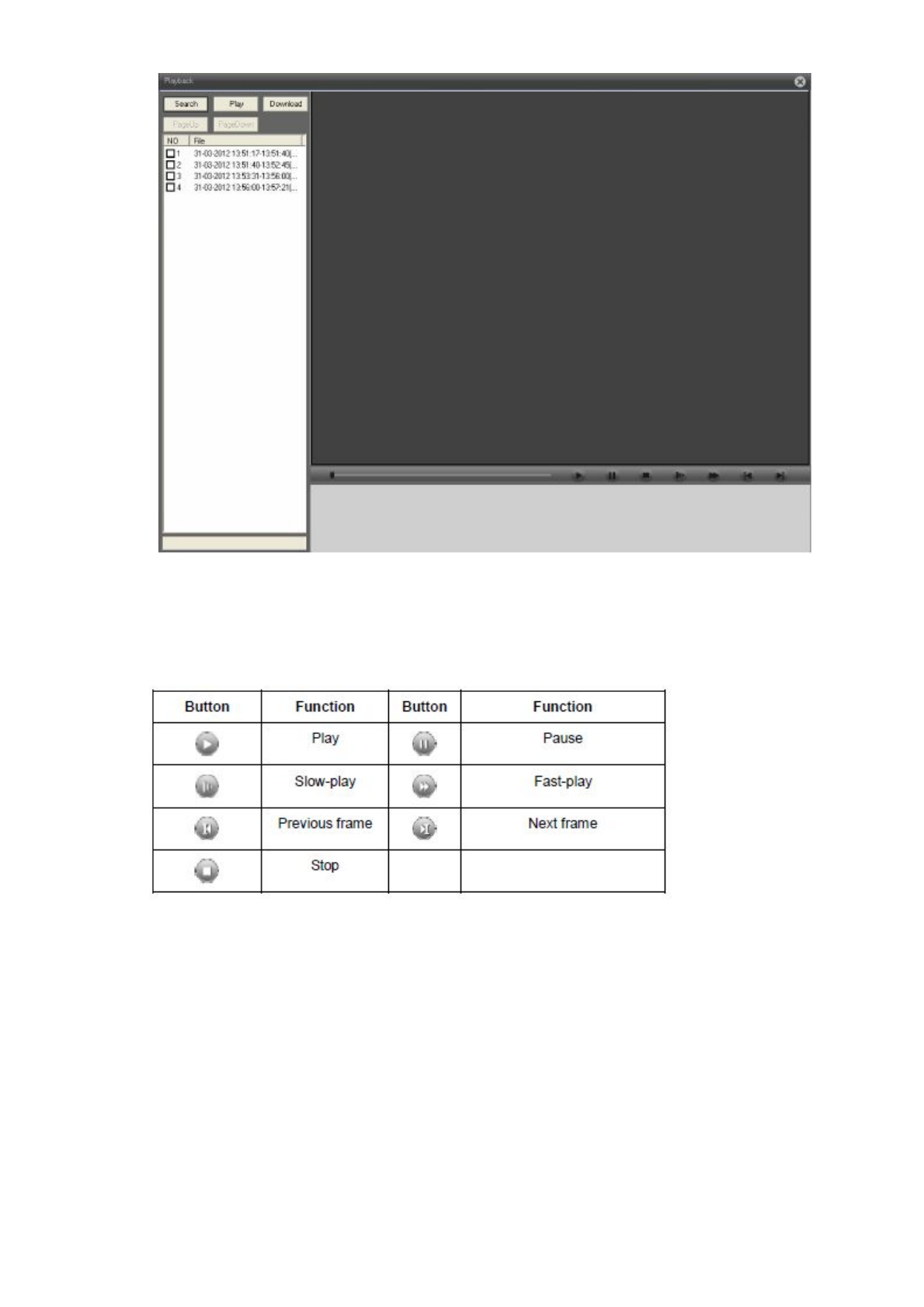
Pic 3.6 Playback
【Playback control button】see detail in below chart;
Chart 3.1 playback control button list
Remark:Playback by frame should under the status of playback pause.
【Operate tips】to show the button function when cursor point it
Special feature:
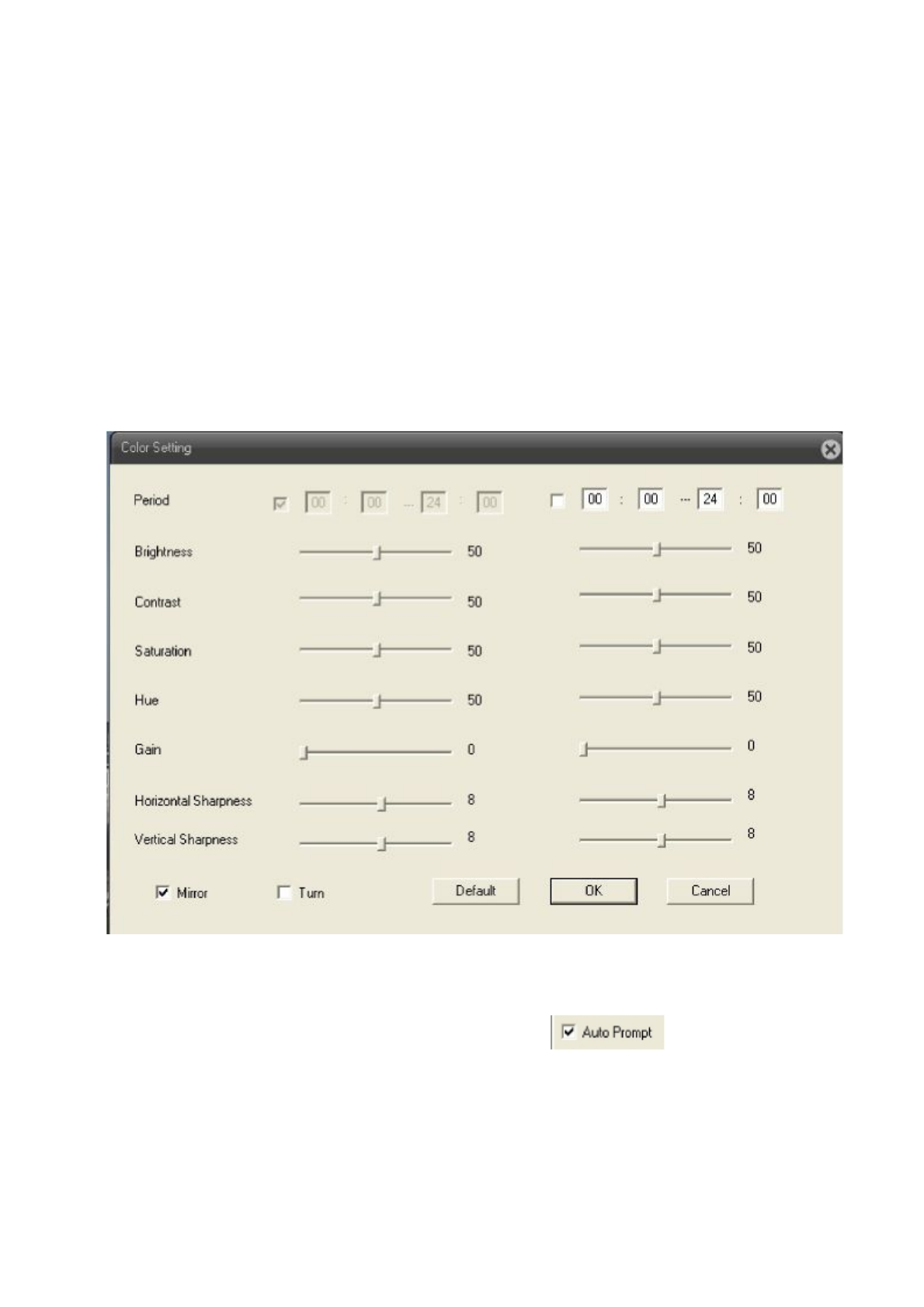
Partial enlargement:when single view full screen playback, can use right button to choose any
size of area from the image, click left button in the chosen area, can enlarge this area to
playback, double click left button will exit.
3.5.3 Image color
Set image parameter of chosen channel (when single view preview, it should be current channel,
when multi-view preview, it should be the channel where the cursor stay), you can enter the page by
shortcut menu. Image parameters including: brightness, contrast, saturation, hue, gain, horizontal and
vertical sharpness. Also can base on requirement to set different image parameter in different period.
Pic: 3.7 Color setting
3.6 Log
Show alarm information and operation record, if u tick
alarm happens, window tip will auto come out.
at lower left side, when
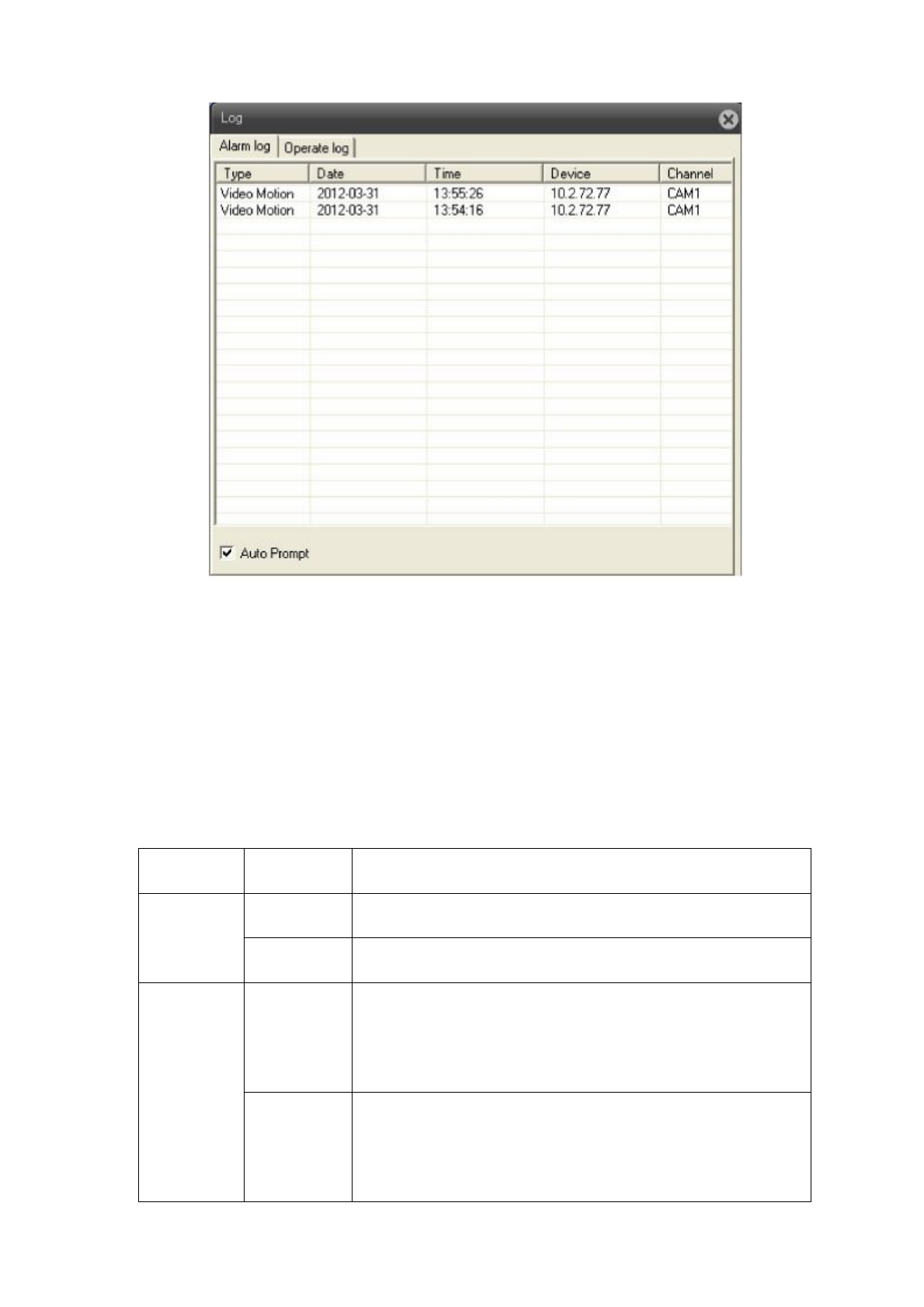
Main Menu
Submenu
Function summary
Record
Record
Set record config, record type, record period, etc.
Snapshot
Set snapshot period, type , etc.
Alarm
Video
motion
Set motion detect alarm channel, sensitivity, area, linkage
parameters: alarm output, snapshot, recording, PTZ, email
sending, ftp upload, etc.
Video blind
Set video blind alarm channel, sensitivity, linkage parameters,
alarm output, snapshot, recording, PTZ, email sending and
ftp upload, etc.
Pic: 3.8 Log information
Chaper Four: Main Menu
4.1 Main menu guideline

Video lost
Set video lost alarm channel and linkage parameters: alarm
output, recording, snapshot, PTZ, Email sending, FTP
upload, etc.
Alarm input
Set alarm input channel and linkage parameters: alarm
output, recording, snapshot, PTZ, email sending, FTP upload,
etc.
Alarm
output
Set alarm mode: configuration, manual, stop
Abnormal
Storage device not exist, not enough space, access storage
device fail, IP conflict, network abnormal alarm
System
General
Set system time, data format, language, hard disk full time
operation, machine number, video format, output mode,
summertime, stay time
Encode
Set encode mode: encode mode, resolution, frame rate, bit
rate, image quality, code stream value, I frame interval
parameter, video/audio enable.
Network
Set basic net parameter, and DHCP、DNS parameter,
auto-gain IP address, network high-speed download, net
transmission tactics
Net service
ARSP
、
Mobile monitor
、
UPNP
、
FTP
、
WiFi
、
3G
、
alarm center
、
RTSP
、
PPPOE
、
NTP
、
Email
、
IP authority
、
DDNS parameter,
etc.
GUI display
Set channel title, cover area, time title, channel time overlap
and position
PTZ Config
Set channel, PTZ protocol, address, baud rate, data bit, stop
bit, parity
RS485
Set protocol, address, baud rate, data bit, stop bit, parity
RS232
Set serial port function, baud rate, data bit, stop bit, parity

Camera
parameter
Exposure mode, Day/Night mode, Backlight compensation,
Auto iris, profile, AE reference, AGC, slow shutter, IR_CUT,
Image、Over-turn、anti-flicker etc
Advanced
HDD
Manage
redundant, format disk, recover, partition, etc.
Account
Modify user, group or password. Add user or group. Delete
user or group.
Auto
maintain
Set auto reboot system, time to auto delete file
Default
Restore setting status of : regular, encode, record, alarm,
network, net service, GUI display, serial settings, account
manage
Import &
Export
Config import, Config export, Log export
Upgrade
To do net upgrade via IE or client software
Reboot
IPC soft reboot
Info
HDD info
Show ttl space of HDD, type, space left, record time, etc
Log
Can base on record type and time to search log, can clear the
log information
Version
Show alarm input output, system version, build date, etc
4.2 Record
Device do operation regarding record, including: record & snapshot.
4.2.1 Record setting
Set IPC parameter, when firstly turn on, system is default with record for 24hours. You can go to
【Device config】>【Record】>【Record】to do related setting.
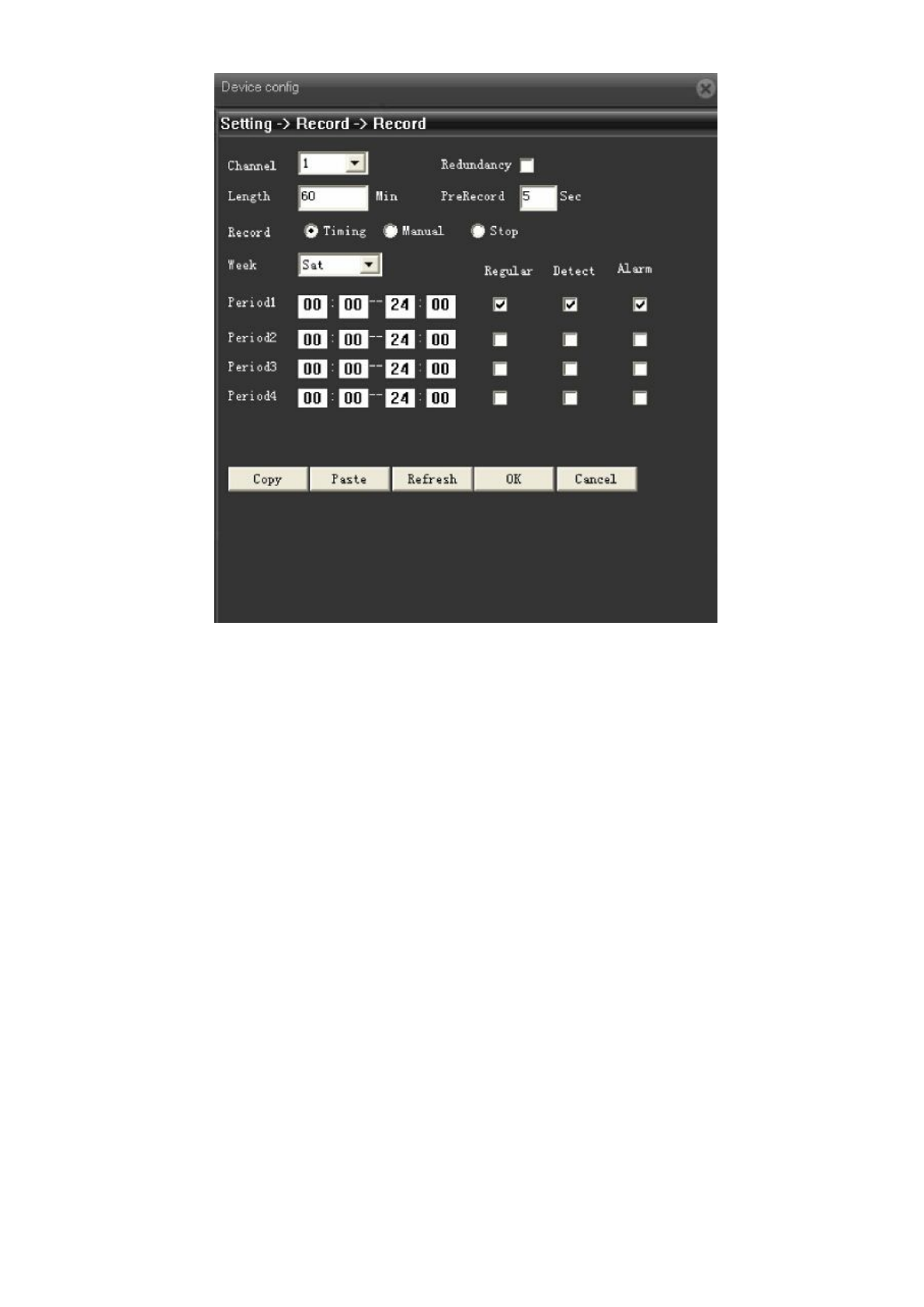
Pic: 4.1 Record setting
【Length】to set the length of each recording file between 1-120min, default is 60min;
【PreRecord】to record 1-30s before motion happens (time length may slight different due to bit rate)
【Record control】set recode type: timing, manual & stop
Timing: Record according to the set video type (regular, detect and alarm)and time period.
Manual:Click the button and the according channel is recording no matter the channel in
any state;
Stop:Click the stop button and the according channel stops recording no matter the
channel in any state.
【Period】Set the time section of common recording, The recording will start only in the set range;
【Record type】Set recording type: regular, detect or alarm.
Regular:Perform the regular recording in the set time section. The video file type is “R”.
Detect:Trigger the “motion detect”, “camera mask” or “video loss” signal. When above
alarm is set as opening recording, the “detection recording” state is on. The video
file type is “M”.
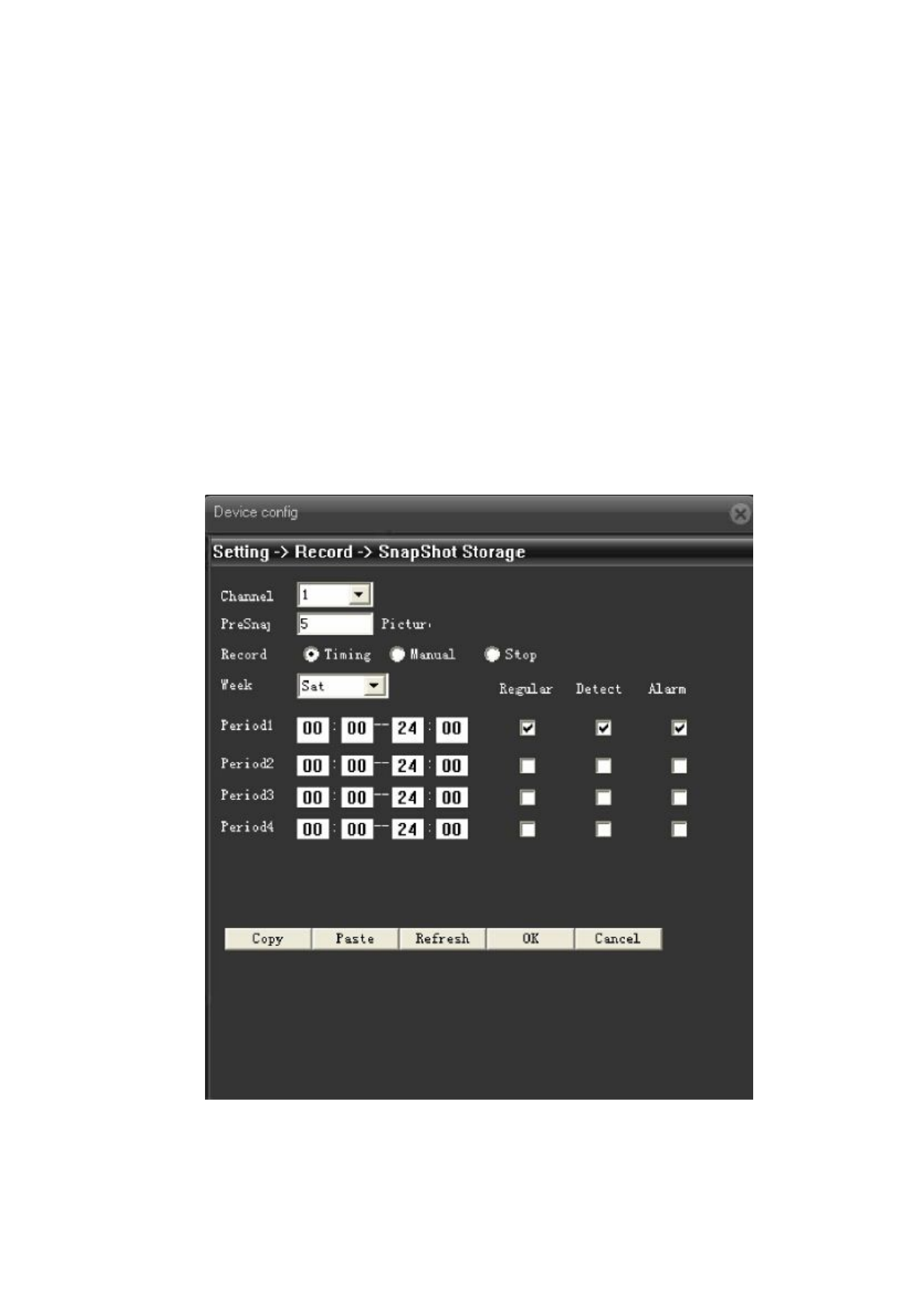
Alarm:Trigger the external alarm signal in the set time section. When above alarm is set as
opening recording, the “detection recording” state is on. The video file type is “A”.
Remark:related alarm setting, please refer to chapter 4.3 alarm part.
4.2.2 Snapshot storage
Setup snapshot parameters for different channels.At first time it's set for 24hours snapshot
continuously, pls go to Main Menu->Record->Snapshot Storage for appropriate settings.
Pic: 4.2 Snapshot setting
【PreSnapshot】to take picture of 1-30 pcs before recording happens, default is 5 pcs
【Record】Set record type, "Timing" ,"Manual" and "Stop"
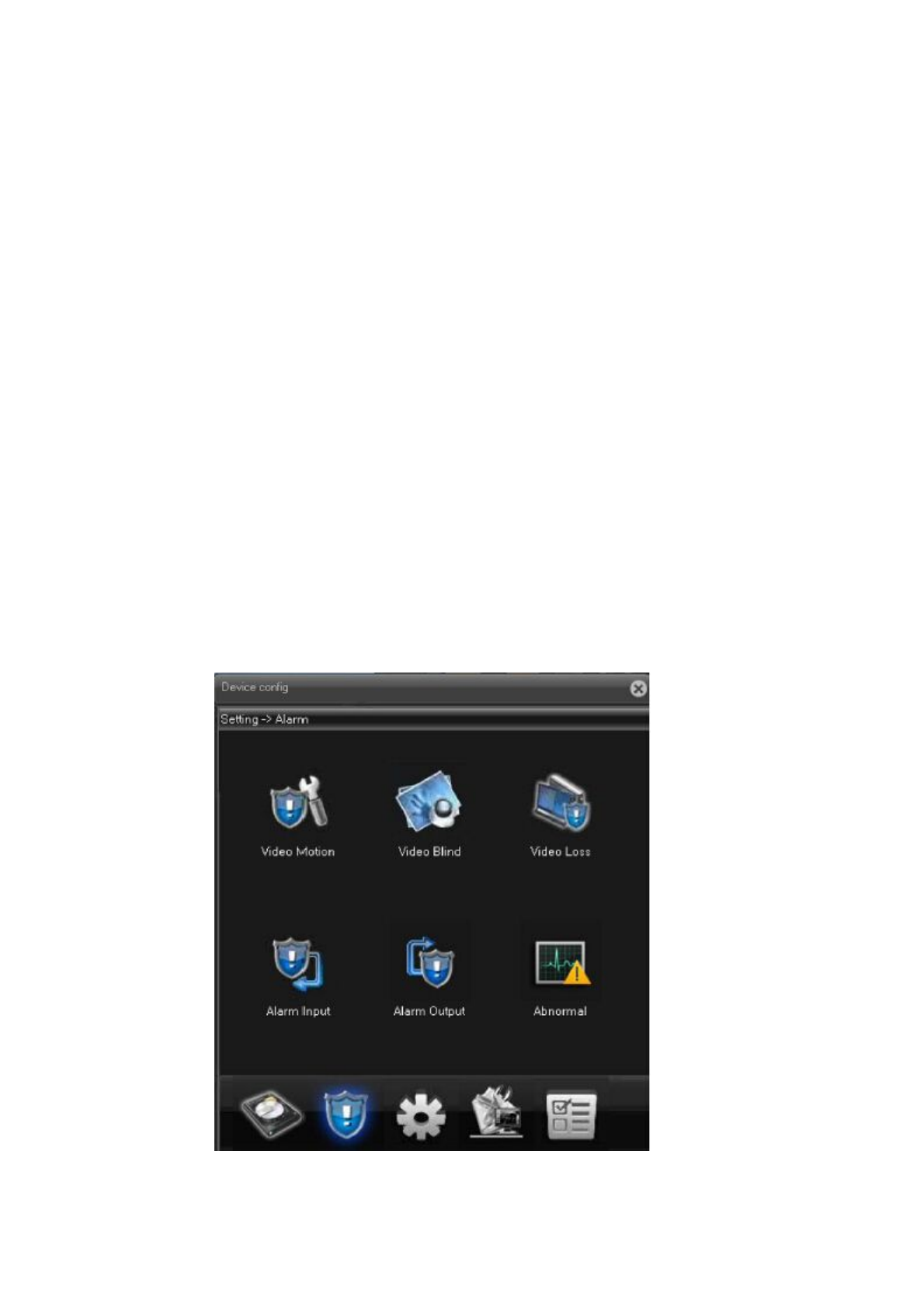
Timing: Realise snapshot according to record type(regular,detect and alarm) and period.
Manual: No matter what is the current status, once choose "manual"
snapshot at related channels.
Stop: No matter what is the current status, once choose "stop",it will stop
snapshot at related channels.
【Period】Set normal record period, it only startup Snapshot Storage at set period.
【Type】Three types: regular, detect and alarm
【Record type】Three types: regular, detect and alarm
Regular: snapshot at set period
Detect: snapshot at set period when motion detect, video blind and video loss
which are preset for snapshot enable.
Alarm: snapshot at set period when alarm in which is preset for snapshot enable.
Note: for related alarm function, pls refer to chapter 4.3.
4.3 Alarm function
Alarm functions include: motion detect,video blind, video loss, alarm input and alarm output,
abnormal dealing.
Pic 4.3 Alarm function
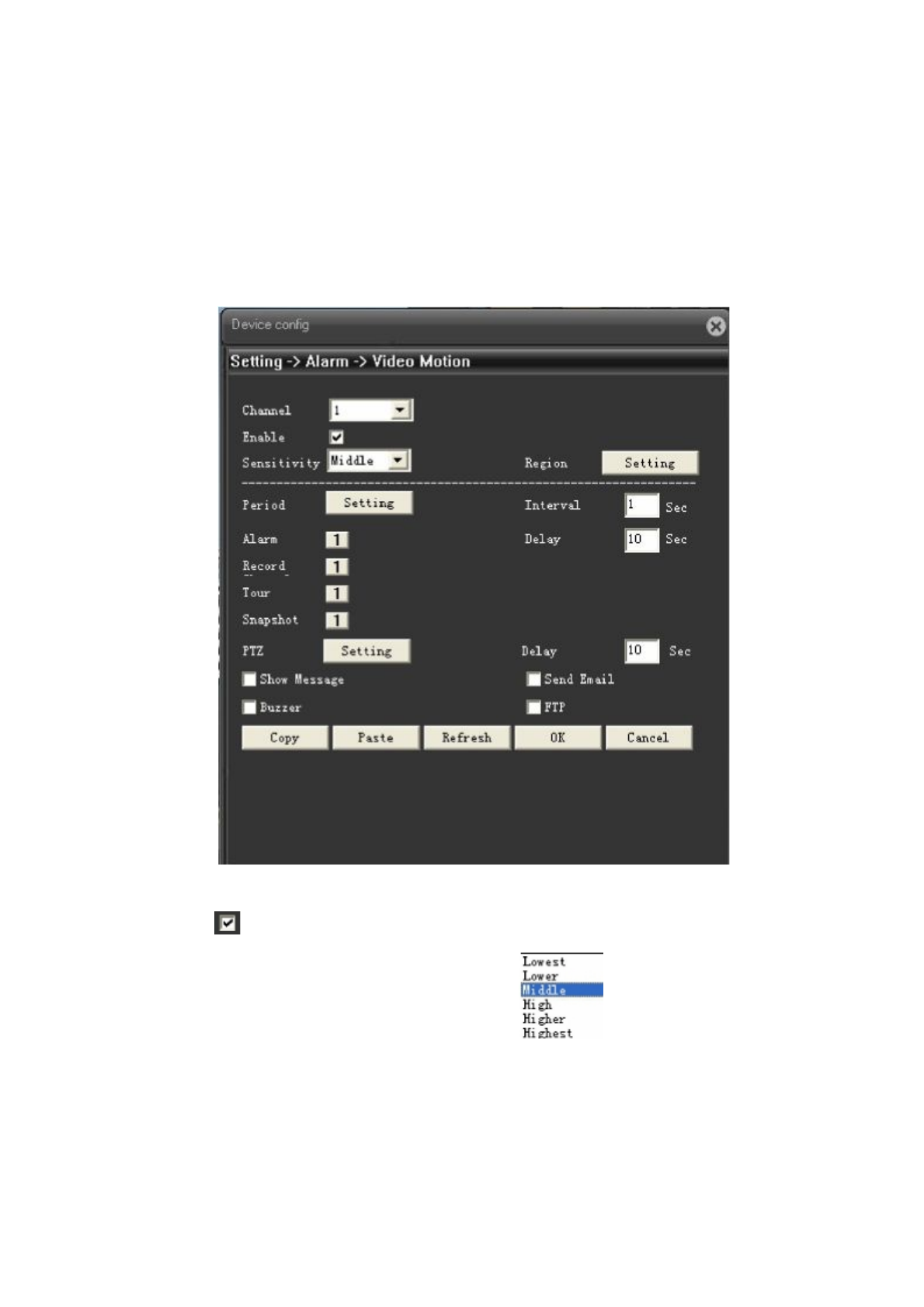
4.3.1 Motion detect
When system detects the motion signal that reaches the set sensitivity, the motion detect alarm and
the linkage function is enable.
Pic: 4.4 motion detect setting interface
【Enable】
means enable motion detect function, enable it firstly then can do related setting.
【Sensitivity】base on sensitivity, can set 6 grades:
,the higher of sensitivity to the moving
objects, the easier to sense the motion happens;
【Region】ClickSetting,enter the setting region of PAL22X18,light blue region is the guard area of
motion detect, dark blue region is the unguard area (show the monitor page), see pic 4.5. press
left button of mouse, pull it to set region. (default whole region chosen is monitor area)
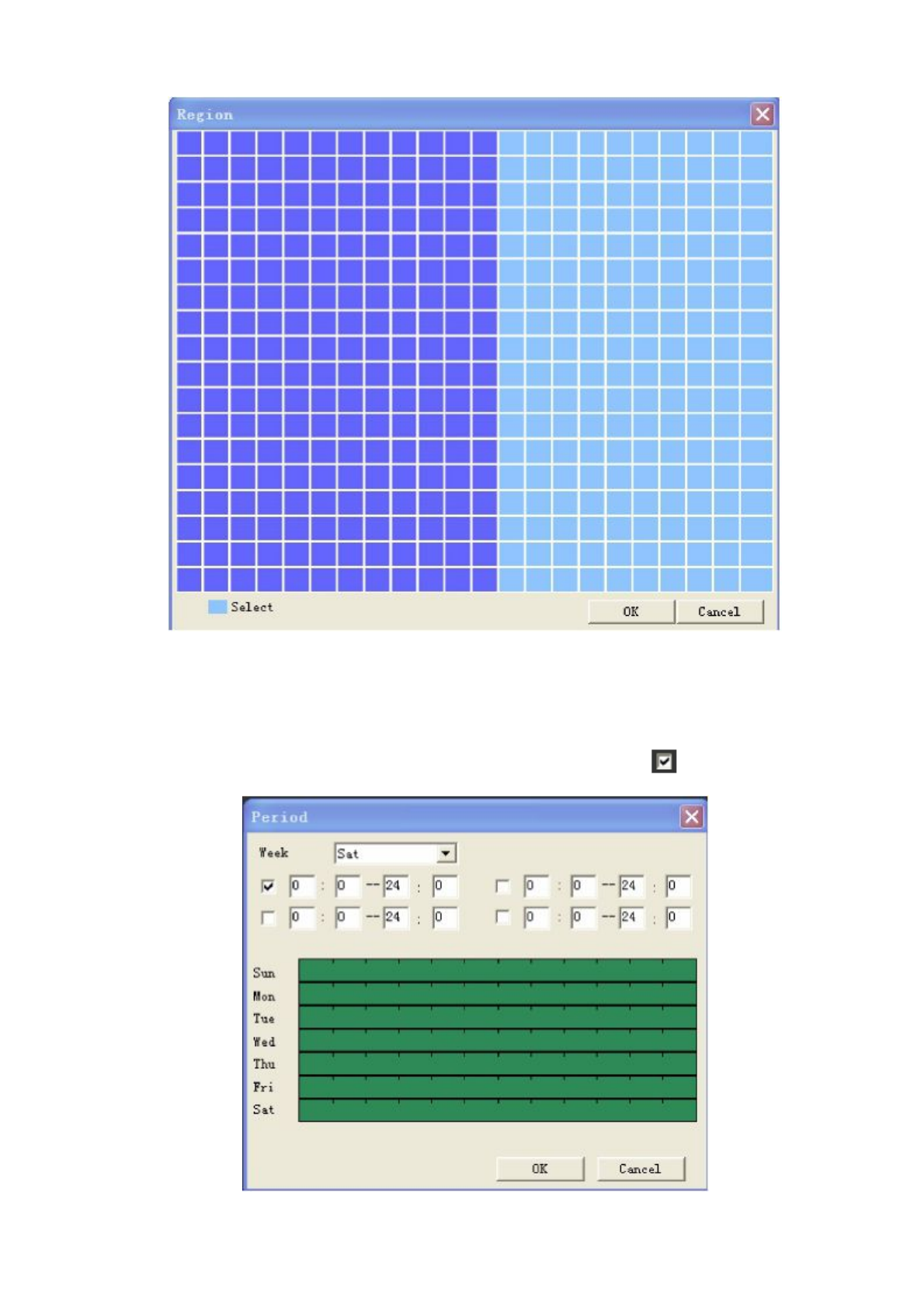
Pic: 4.5 region setting
【Period】Trigger the motion detect signal in the set time section, see pic:4.6. You can set according
to week or set uniformly. Each day is divided into four time sections.tick
, mean setting is valid.
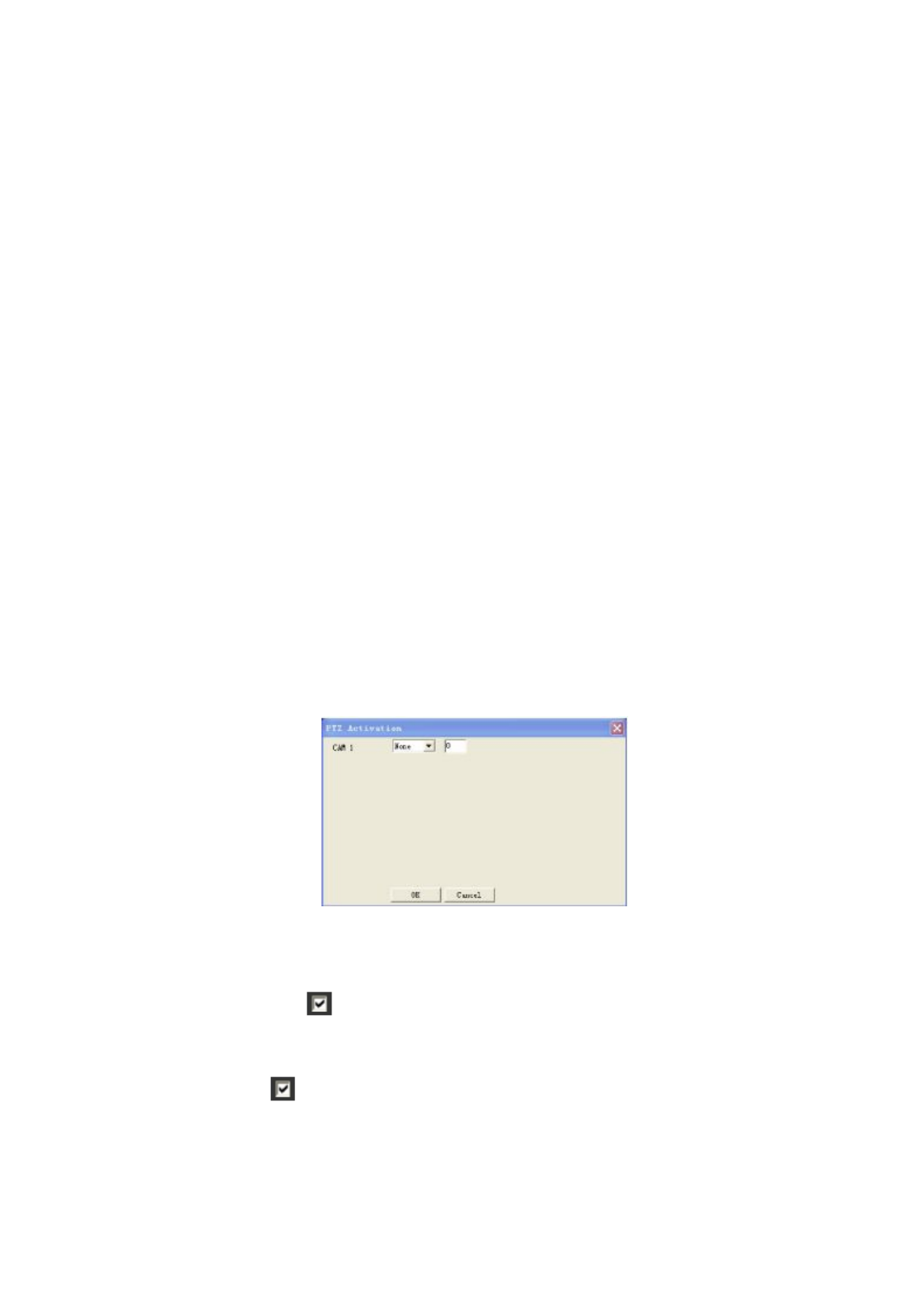
Pic: 4.6 Period Setting
【Interval】Only one alarm signal is turned on even there are several motion detect signals in the set
interval 0-600s.
【Alarm output】Start the external equipment of corresponding linkage alarm when the motion detect
alarm is turned on.;
【Delay】Delay a few moments and stop when the alarm state is turned off. The range is 10~300
seconds.
【Record channel】choose record, when alarm happens, system will trigger record signal of this
channel;
Remark:to link record, need to enable motion detect of related period at【record setting】
【Snapshot】choose snapshot, when alarm happens, system will trigger snapshot signal of this
channe;
Remark:to link snapshot, need to enable motion detect of related period at【record setting】
【record setting】
【PTZ Linkage】when alarm happens, link the PTZ of related setting channel, see pic:4.7;
Remark:to link PTZ, need to set related parameter at【System】>【PTZ control】,set preset
point, cruise between points, interval, etc.
Pic: 4.7 PTZ linkage
【Delay】When alarm is over,recording will last some seconds(10~300sec),then stop.;
【EMAIL sending】tick
,means when alarm happens link email sending to inform user.
Remark:sending email, need to do related setting at【Net service】.
【FTP upload】tick
,means when alarm happens, if record or snapshot channel was chosen, the
record file and snapshot image will be uploaded to the appointed position.
Remark:FTP upload, need to do related setting at【Net service】.
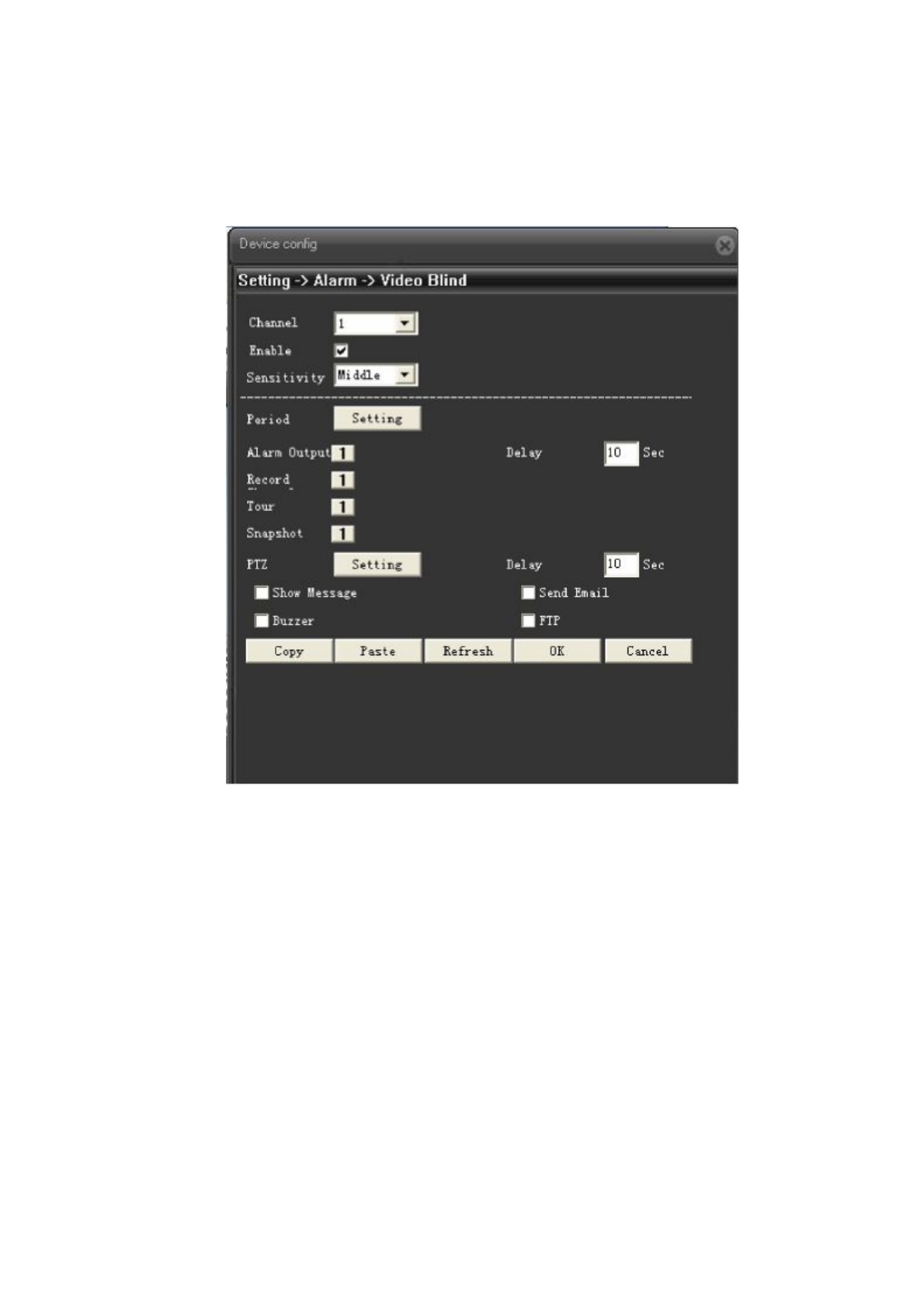
4.3.2 Video blind
When the video image is influenced by the environment such as bad brightness or reaching the set
sensitivy parameter, the camera mask function is turned on and the linkage function is enable.
Pic: 4.8 video blind
Setting detail : refer to chapter 4.3.1 motion detect.
4.3.3 Video lost
When the equipment can not obtain the channel video signal, the video loss alarm is turned on and the
linkage function is enable.
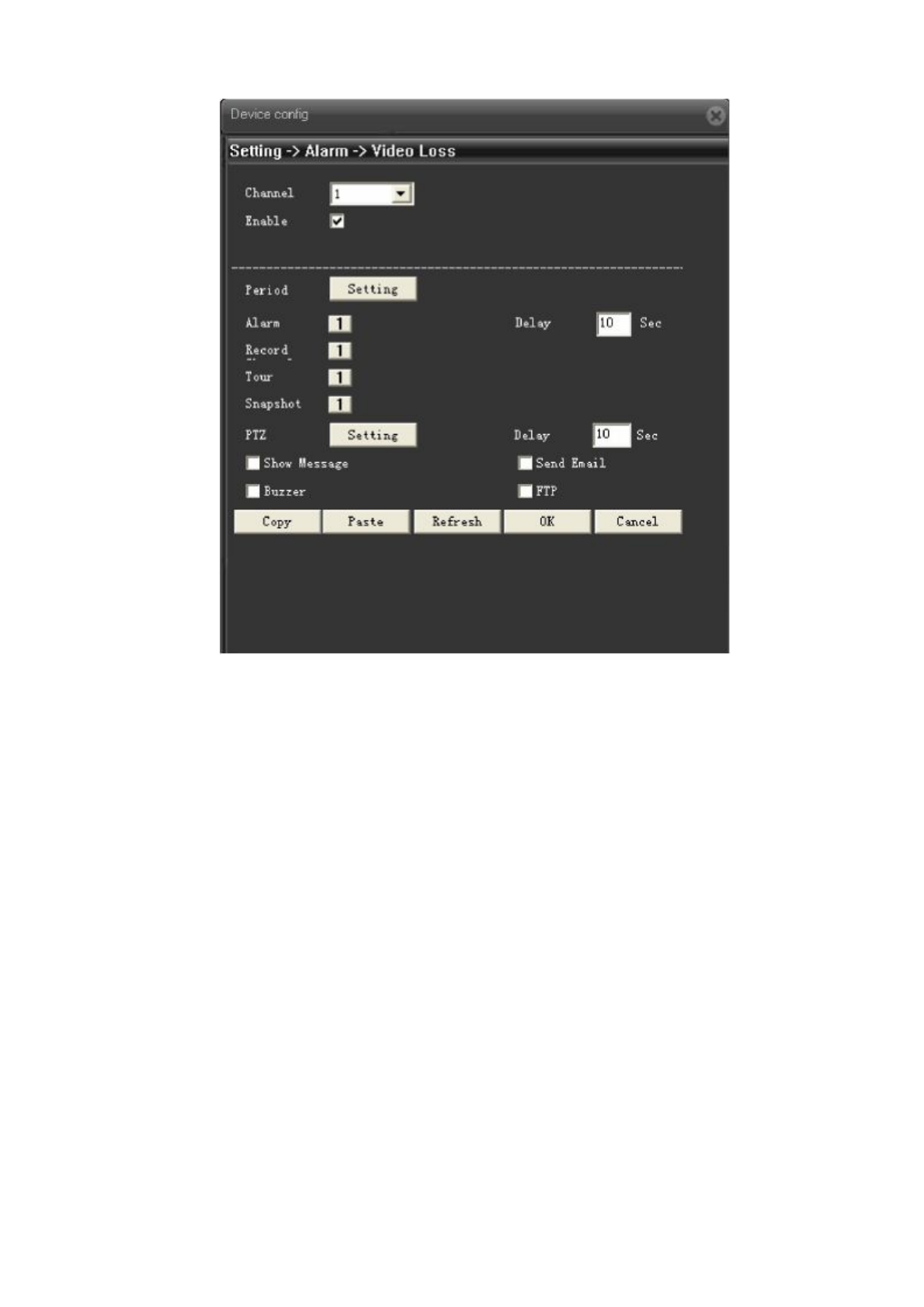
Pic: 4.9 Video lost
Setting detail: refer to chapter 4.3.1 motion detect.
4.3.4 Abnormal
Analyze and detect the software and hardware of current device, when abnormal issue was
detected, device will make related respondence.
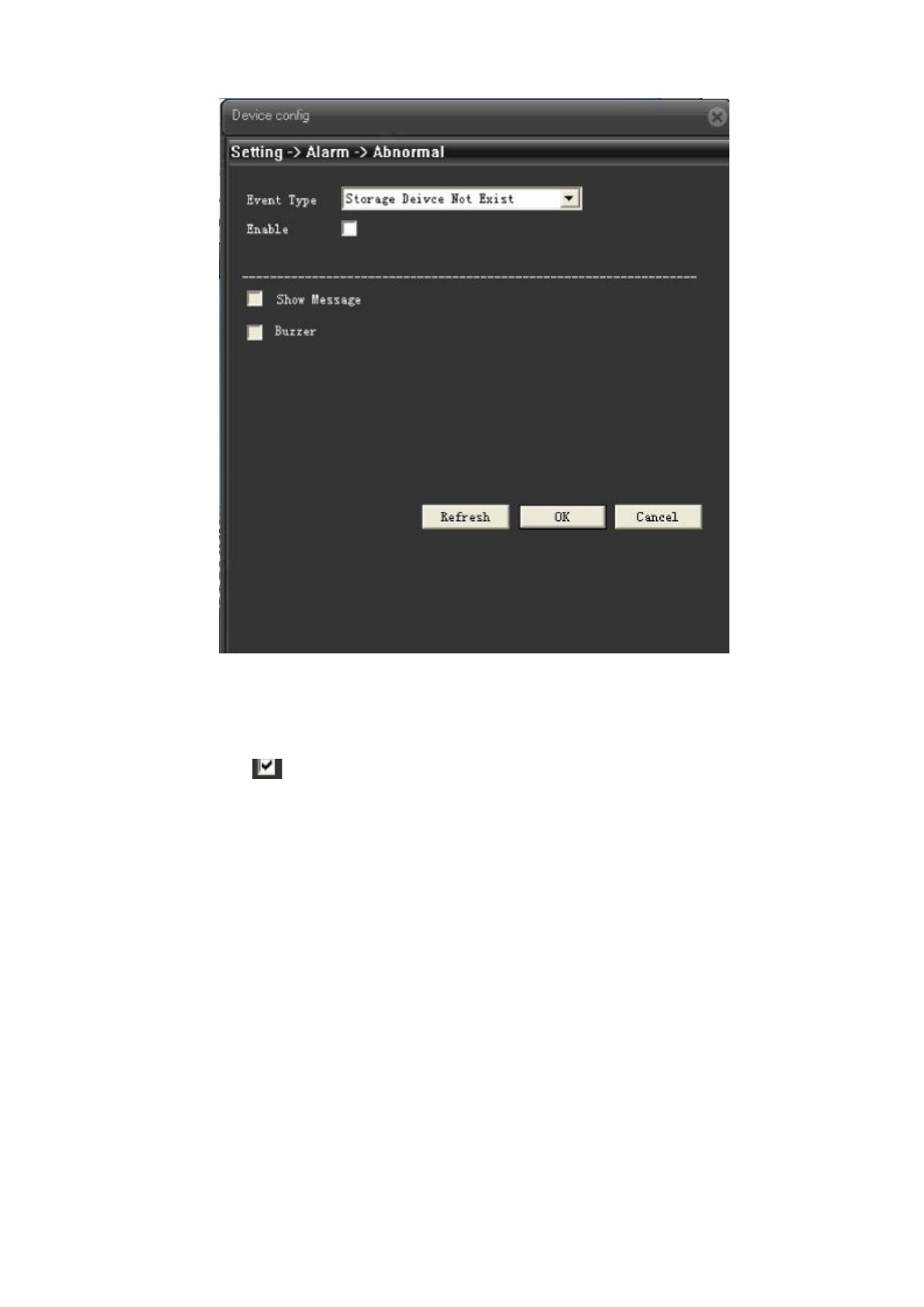
Pic: 4.10 abnormal
【Event type】choose event type at drop-down box
【Enable】tick to enable,open abnormal deal function, setting is valid only if it is enable.
4.4 System setting
To set parameter of all kinds of functions, setting including: General、Encode、Network、Net
service、GUI display、PTZ config/RS485、RS232、Camera parameter.
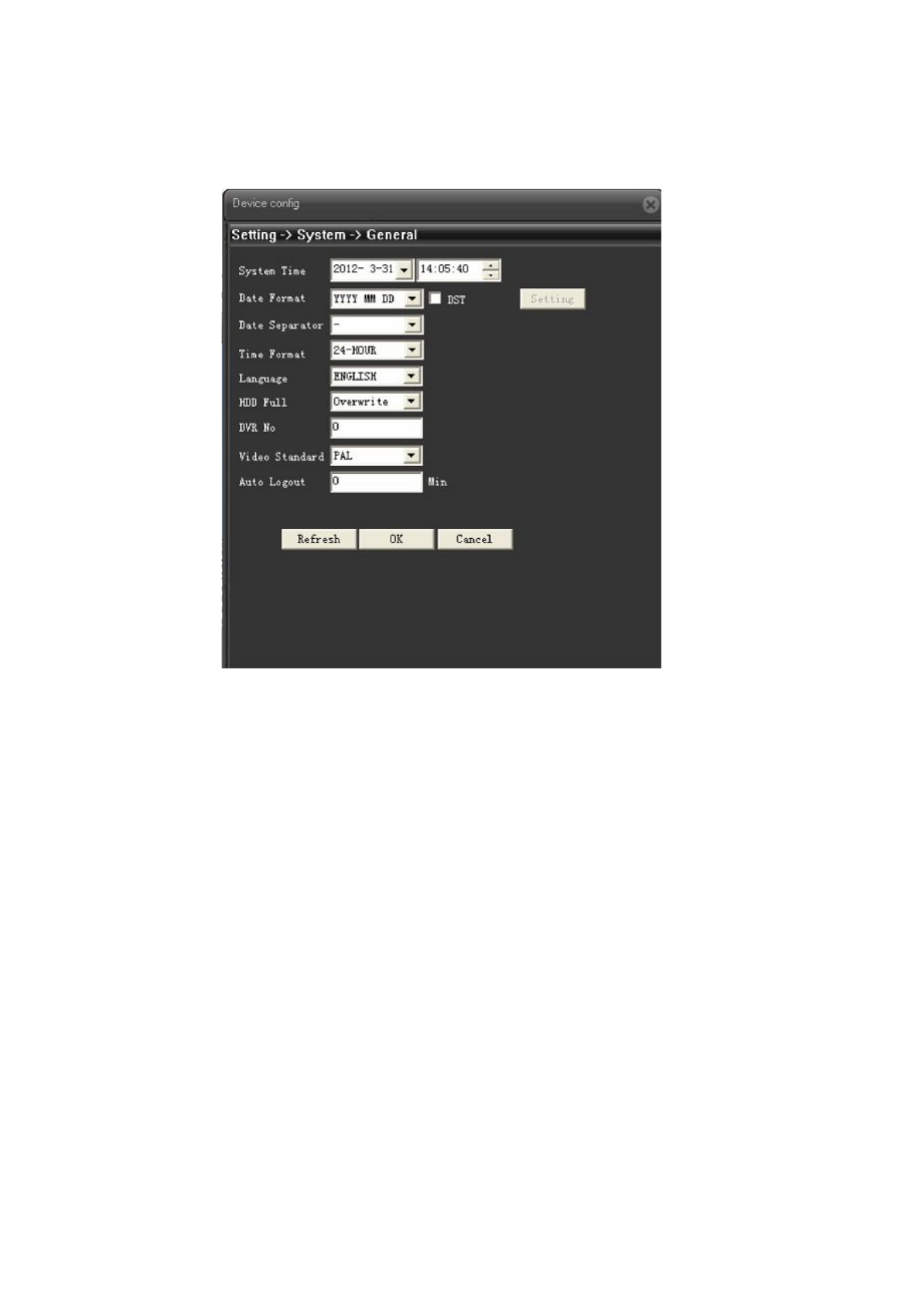
4.4.1 General setting
Pic: 4.11 General setting
【System time】set current date and time of IP Camera.
【Date format 】choose date showing format, including :year/month/date 、month/date/year,
date/month/year,
【Date separator】Choose list separator of the data format,
【Time format】choose time format, including: 24-hour and 12 hour;
【Language】at present support 29 kinds of language: simplified Chinese, Tradition Chinese,
English, Bosnian, Finnish, French, Greek, Hungarian, Italian, Japanese, Germany,
Polish, Portuguese, Russian, Spanish, Thai, Turkish, Vietnamese, Romanian,
Brazilian, Indonesian, Swedish, Arabic, Bulgarian, Czech, Hebrew, etc.
【HDD full】choose Stop record:means when the TF card is full, stop recording.
Choose Over write:means when the TF card is full, keep on recording, but the most
previous file will be replaced.
【Video standard】support PAL or NTSC;
【DST】Tick DST, then click 【setting】, will come out window as pic: 4.12 & pic:4.13, to set the start
time and end time of summertime via week or date.
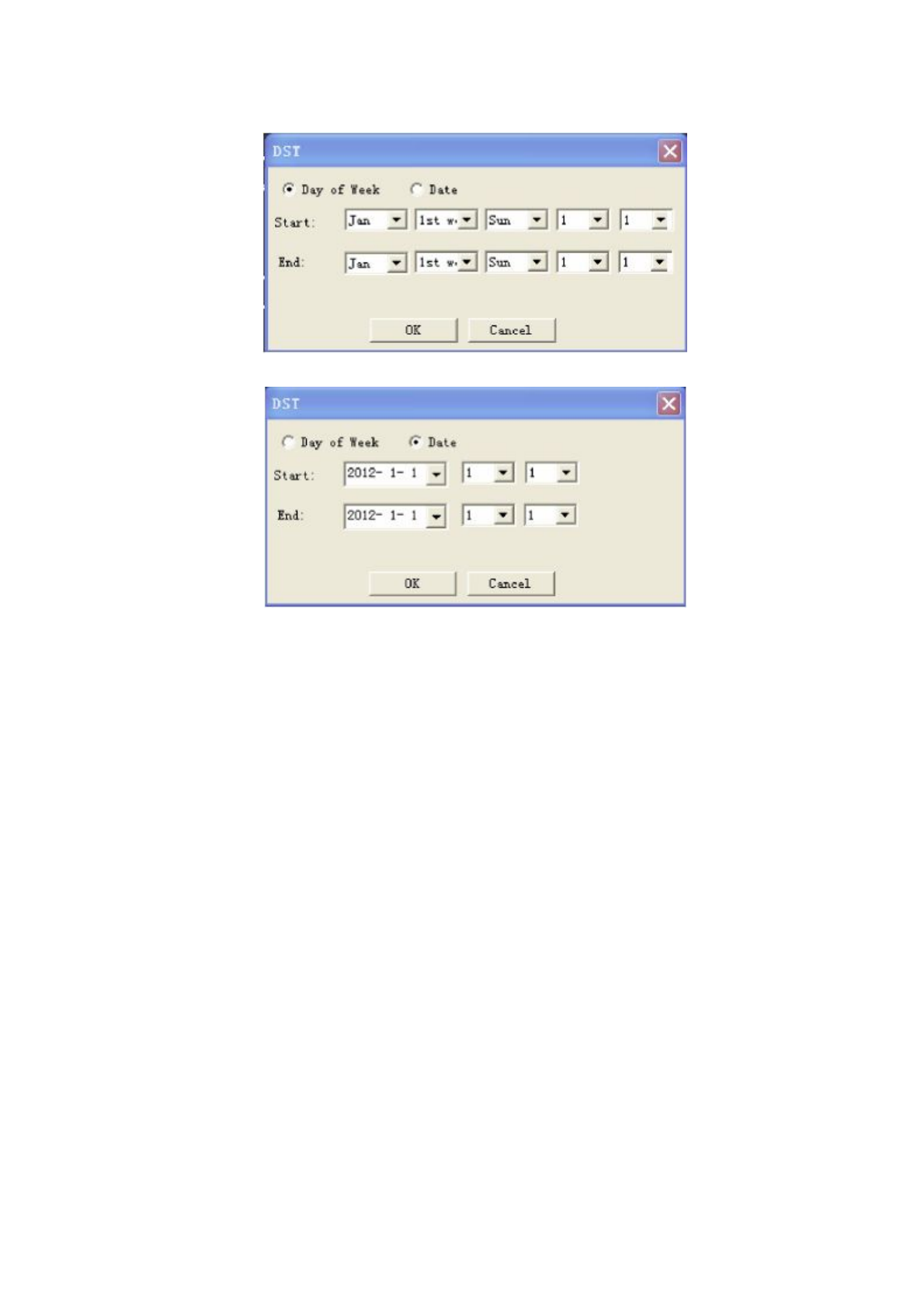
Pic:4.12 DST (Week) setting
Pic:4.13 DST(Date) setting
4.4.2 Encode Seting
Set video/audio encode parameters, including image parameters of record file, remote monitor, etc.
Left part is to set the encode parameter of each separated channel, right part is to set encode parameter
of extra stream, dual stream is using one high bit rate stream for local high definition storage, support
D1/HD1/CIF/QCIF encode, one low bit rate stream(QCIF encode) for net transmission, in order to
maintain local storage and remote net transfer. Dual stream both considering to image quality and
transmission quality under the current band bottleneck, and can breakthrough it, base on the bandwidth
to flexibly choose stream format, to reach local high definition storage and low stream for net
transmission back end.
Remark:Main application of extra stream: to do multi-channel real-time monitor, and mobile monitor
when the network if poor.
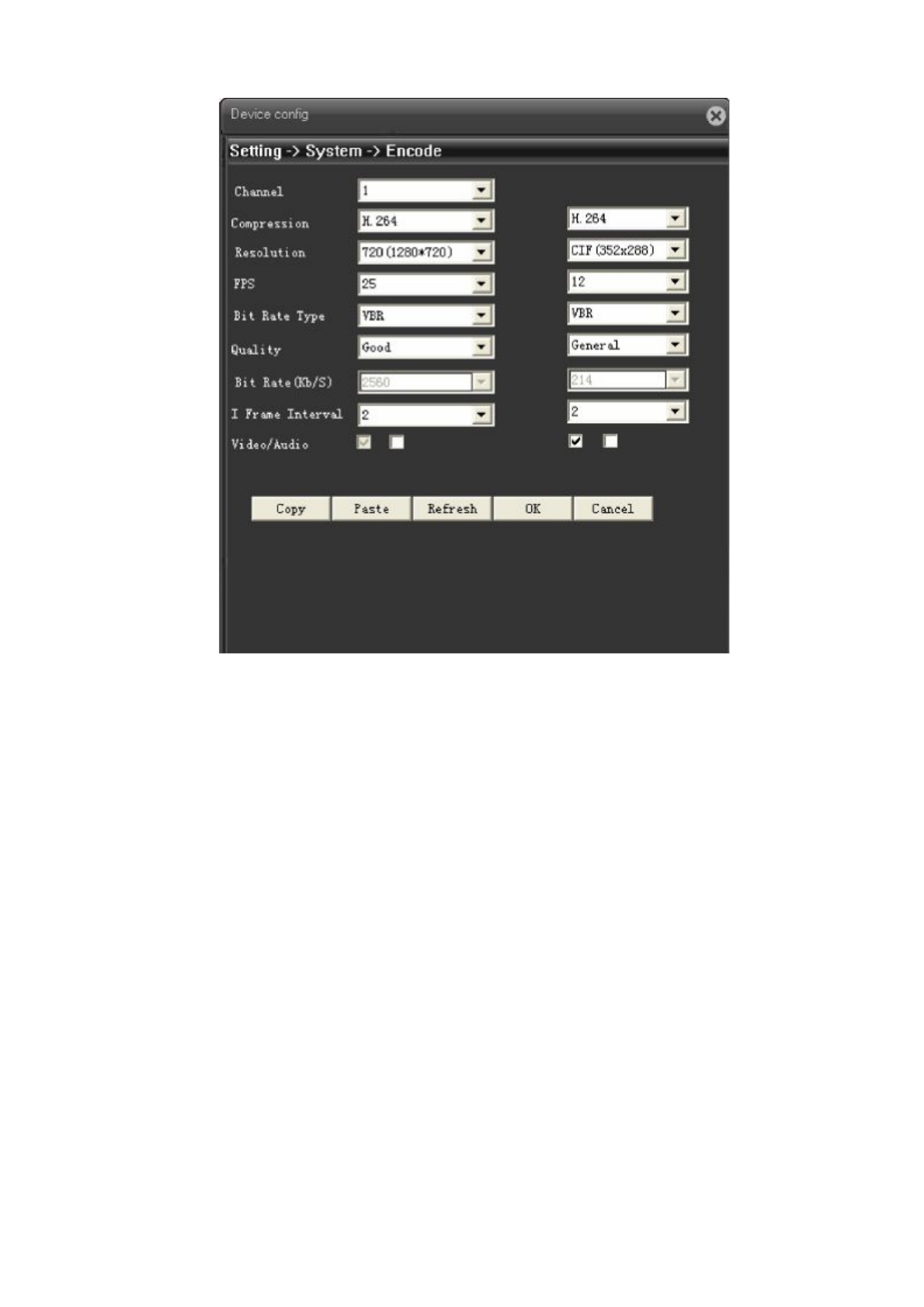
Pic: 4.14 Encode setting
Encode setting
【Compression】Standard H.264MP;
【Resolution】show types of resolution: D1/HD1/CIF/QCIF;
【Frame rate】adjustable, real-time standard is:PAL,25 fps
NTSC,30 fps;
【Bit rate type】you can choose CBR or VBR, image quality have 6 grades to choose under VBR
type, then you can manual choose the bit rate value under CBR type.
【Image quality】set bit rate value to change the image quality, if supporting facility is available, the
larger of bit rate value, the better of image quality.
Bit rate reference span :D1 (512~2560kbps )HD1 (384~2048kbps )CIF (64~1024kbps ),
QCIF(64~512kbps)
【Frame interval】you can choose between 2~12s;
【audio/video】the icon was all ticked, means audio & video combine stream
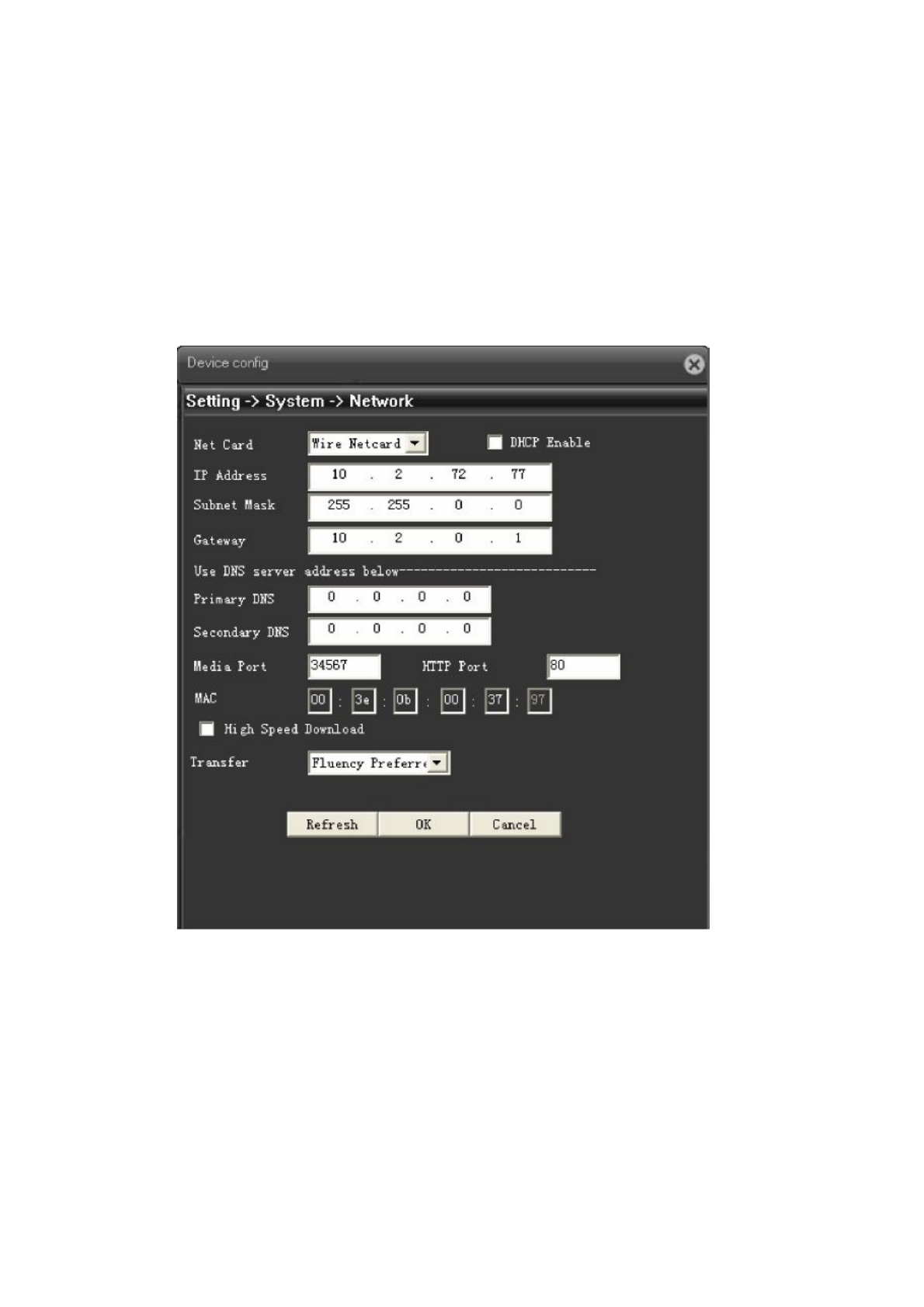
Extra stream setting
Extra stream is used for client side monitor and mobile monitor.
The parameter setting of resolution, frame rate, stream control, bit rate value is the same as
individual channel
4.4.3 Network setting
Pic: 4.15 Network setting
【Net card】you can choose wired net card;
【DHCP enable】to auto get IP address(not suggested);
Remark:need to set up DHCP server in advanced.。
【IP address】set IP address of device, default IP address is:192.168.1.10;
【subnet mask】set subnet mask of device, default subnet mask is:255.255.255.0;
【default gateway】set default gateway of device, default gateway is:192.168.1.1;
【DNS setting】Domain Name Server. It translates the domain name into IP address. The IP address
is offered by network provider. The address must be set and reboot then it works.;

【TCP port】default is 34567;
【HTTP port】default is 80;
【high speed download】Network high speed download;
【Transfer policy】there are 3 policies, adaptive, quality preferred, fluency preferred. Base on
different setting, code stream is auto-adjusted, adaptive is eclectic between quality and fluency, also considers
fluency when the quality is not greatly influenced. Fluency preferred and adaptive is valid only when the extra
stream is enable, if extra stream is not enable, it will base on network status to adjust quality preferred.
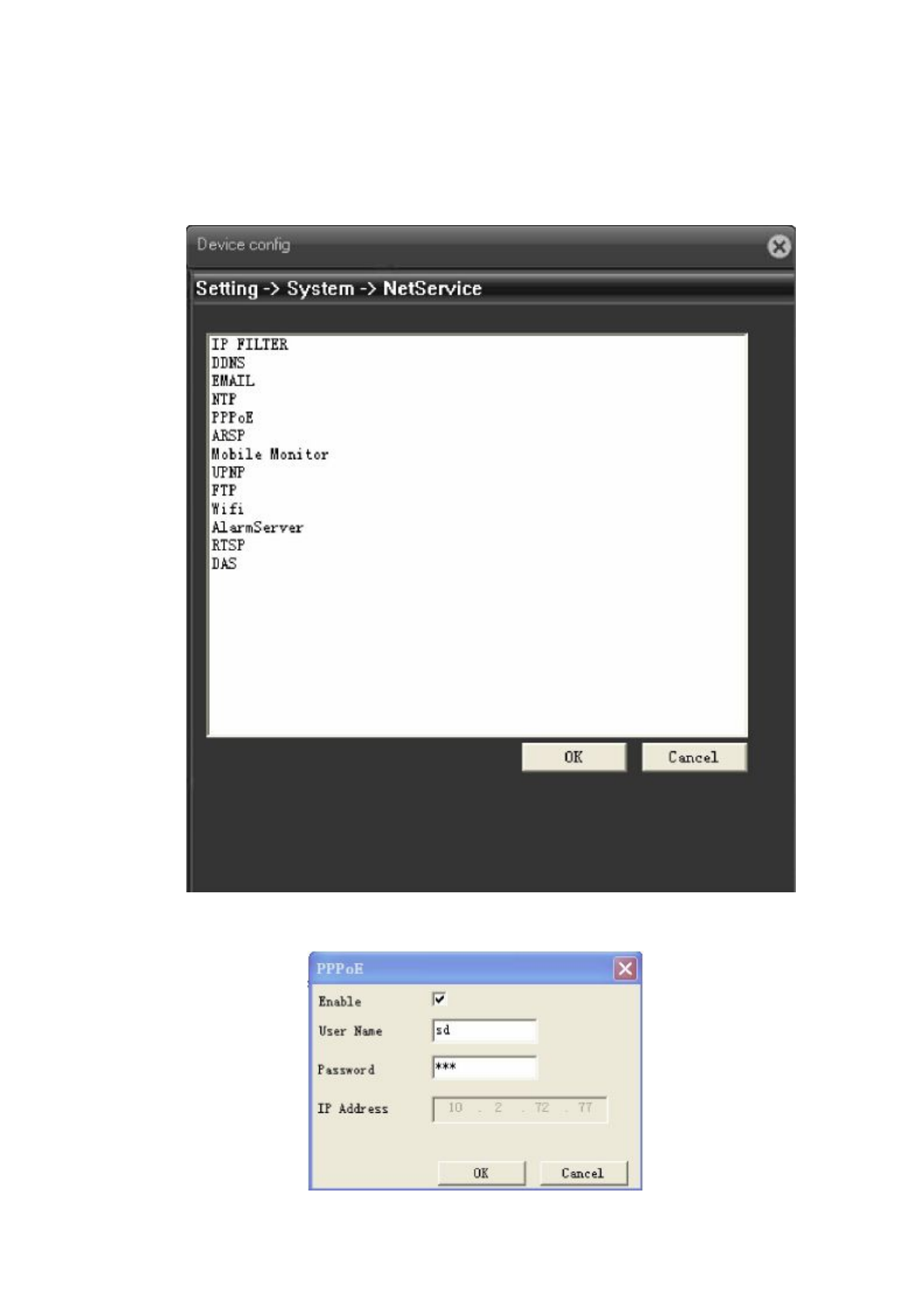
4.4.4 Net service
To config advanced network function, choose any item and double click it to config the parameters.
4.16 Net service
【PPPoE setting】
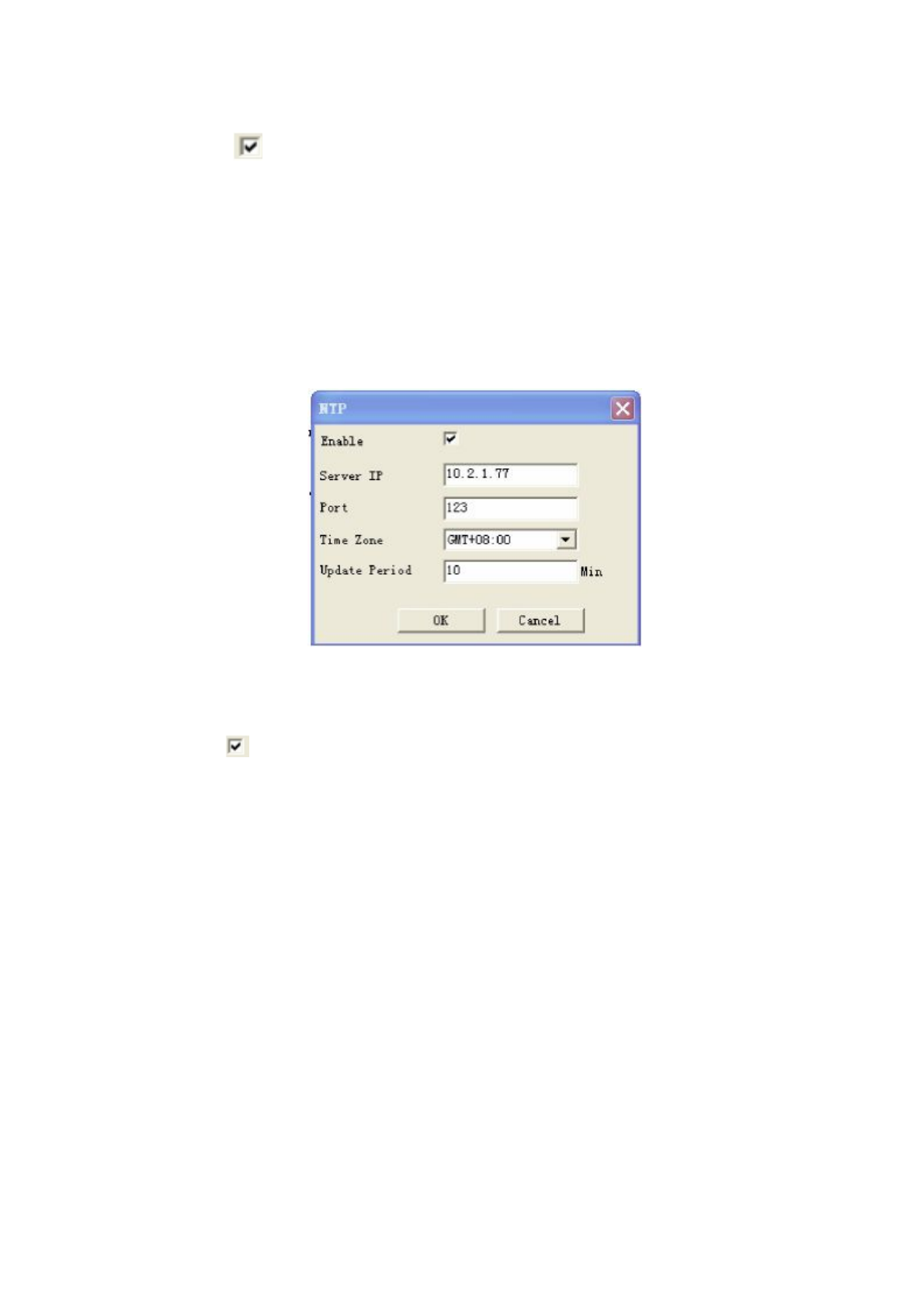
Pic: 4.17 PPPOE
Enabe:Tick
means chosen, enable it firstly, then the setting is valid.
Input user name and password that provided by ISP(Internet server provider), save it and reboot
device, after reboot, IPC will auto connect to network by the way of PPPoE, if it is successful【IP
address】will be changed to the dynamic WAN IP that just get.
Operation:PPPoE dial up successfully,check【IP address】,to get current IP of device, then access
this device by this IP from client side.
【NTP setting】
Pic: 4.18 NTP setting
Need to install NTP service at PC
Enable:tick
means chosen, setting is valid only when it is enable.
Server IP:input IP of PC that installed with NTP server
Port:default NTP port is 123,can base on the actural NTP server to set port no
Time zone:London GMT+0 Berlin GMT +1 Cairo GMT +2 Moscow GMT +3 New Delhi GMT
+5
Bangkok GMT +7
Hongkong/Beijing GMT +8
Tokyo GMT +9
Sydney GMT +10
Hawaii
GMT-10 Alaska GMT-9 Pacific time GMT-8 US mountain time GMT-7 US central time GMT-6 US
eastern time GMT-5 Atlantic time GMT-4 Brazil GMT-3 Atlantic central GMT-2;
Update period:The same with the NTP server check interval. Default: 10minutes
【EMAIL setting】
EMAIL sending is used for sending alarm information and snapshot picture to appointed mailbox
when alarm link to snapshot.
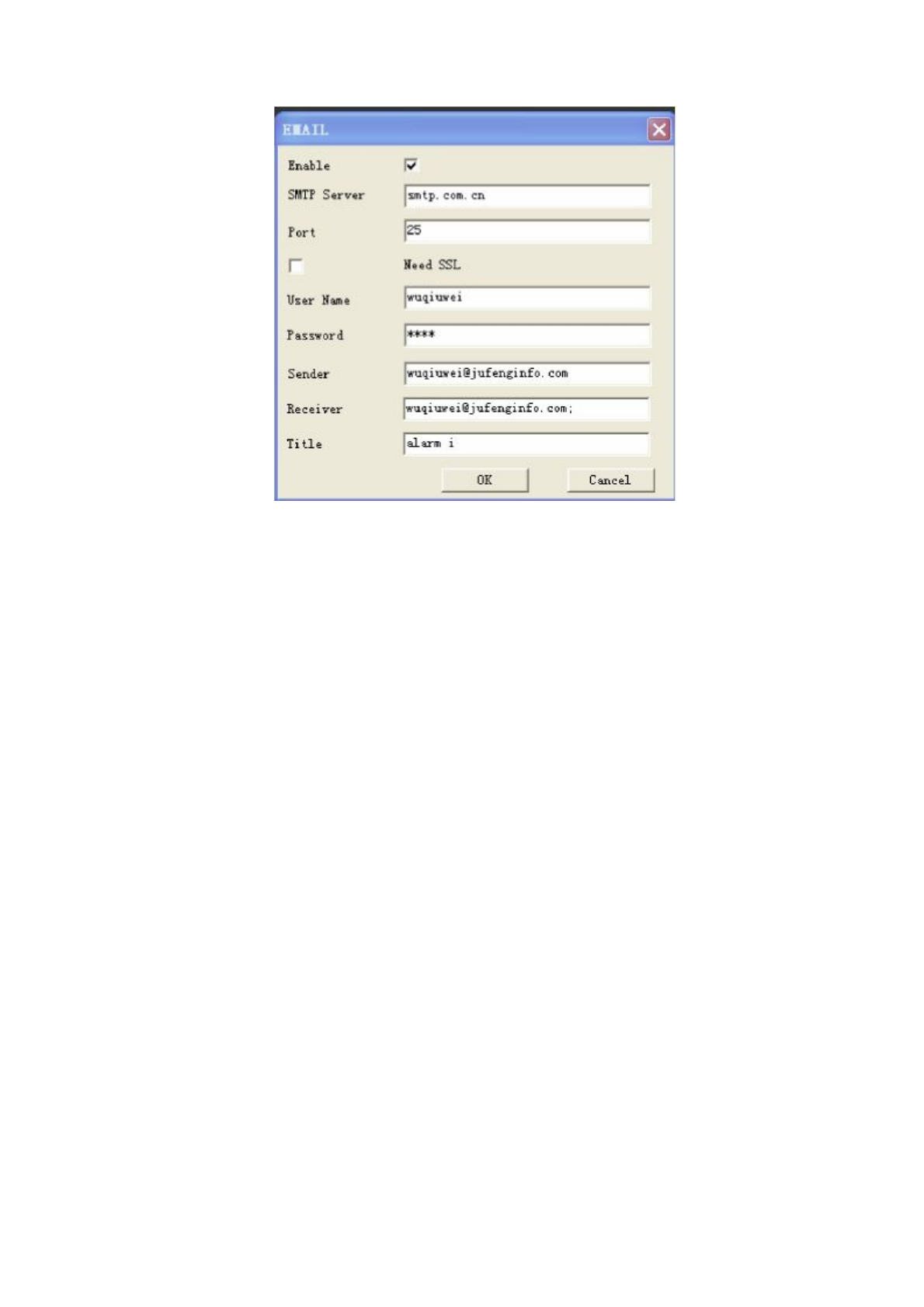
4.19 EMAIL setting
SMTP server:address of email server,can be IP address or domain name(if it is domain name,
need to make sure the DNS is correct, then domain name can be correctly analyzed)
Port: Email server port number.;
SSL: Decide whether using Secure Socket Layer protocol to login;
User Name: Apply the email server user name.
Password: Input the password corresponding to the user.
Sender: Set the email sender address.
Receiver: Send the email to appointed receivers when the alarm is turned on. You can set three
receivers at most.
Title: You can set as you like.
【IP authority setting】
When choose the white list, only the IP in the list can connect to IP camera, list can support 64 IP
setting;
When choose the black list, mean the IP in the list can not access IP camera via net, list can support
64 IP setting.
Can tick to choose and delete the set IP.
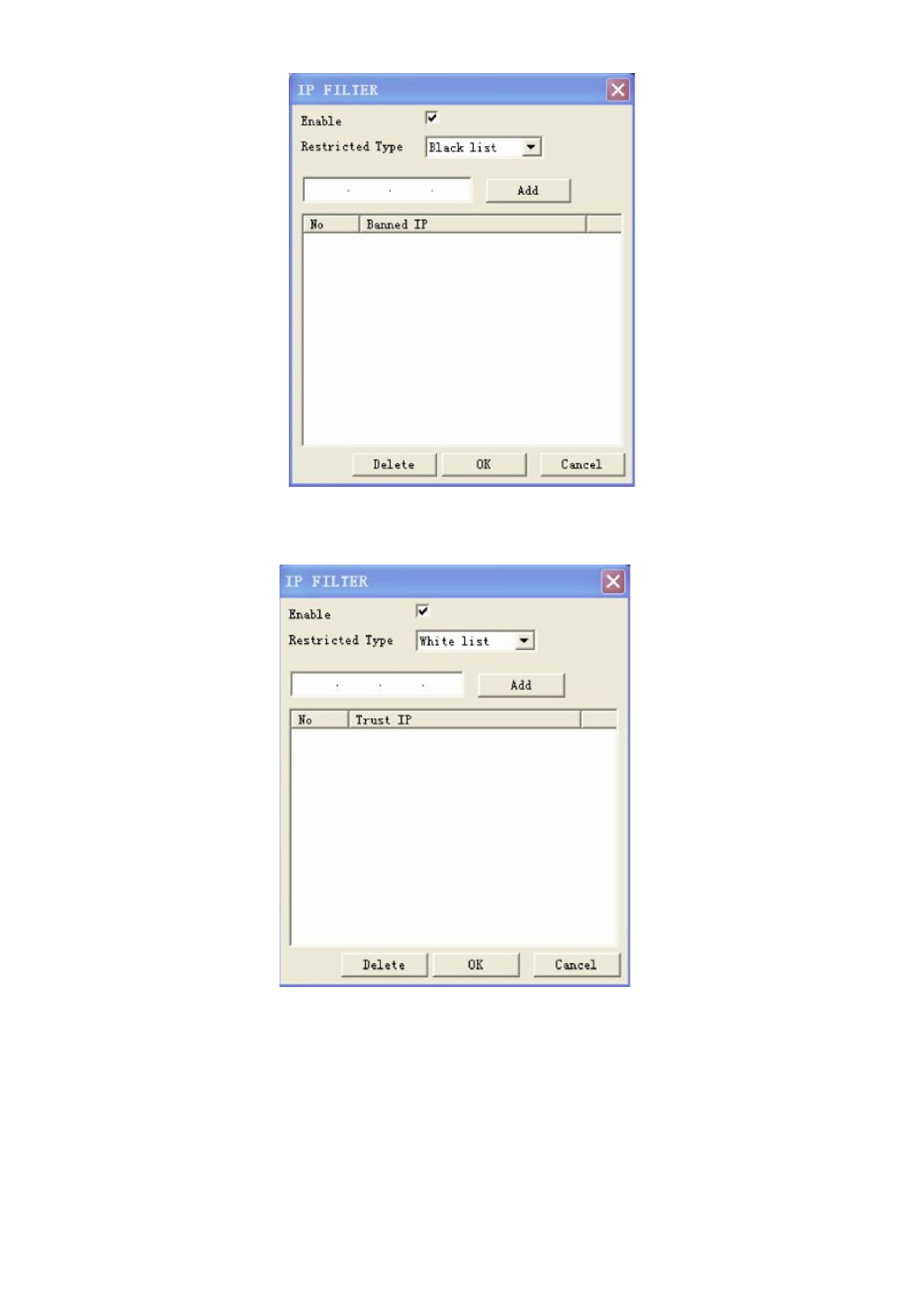
Pic: 4.20 IP authority setting(black list)
Pic: 4.21 IP authority setting(white list)
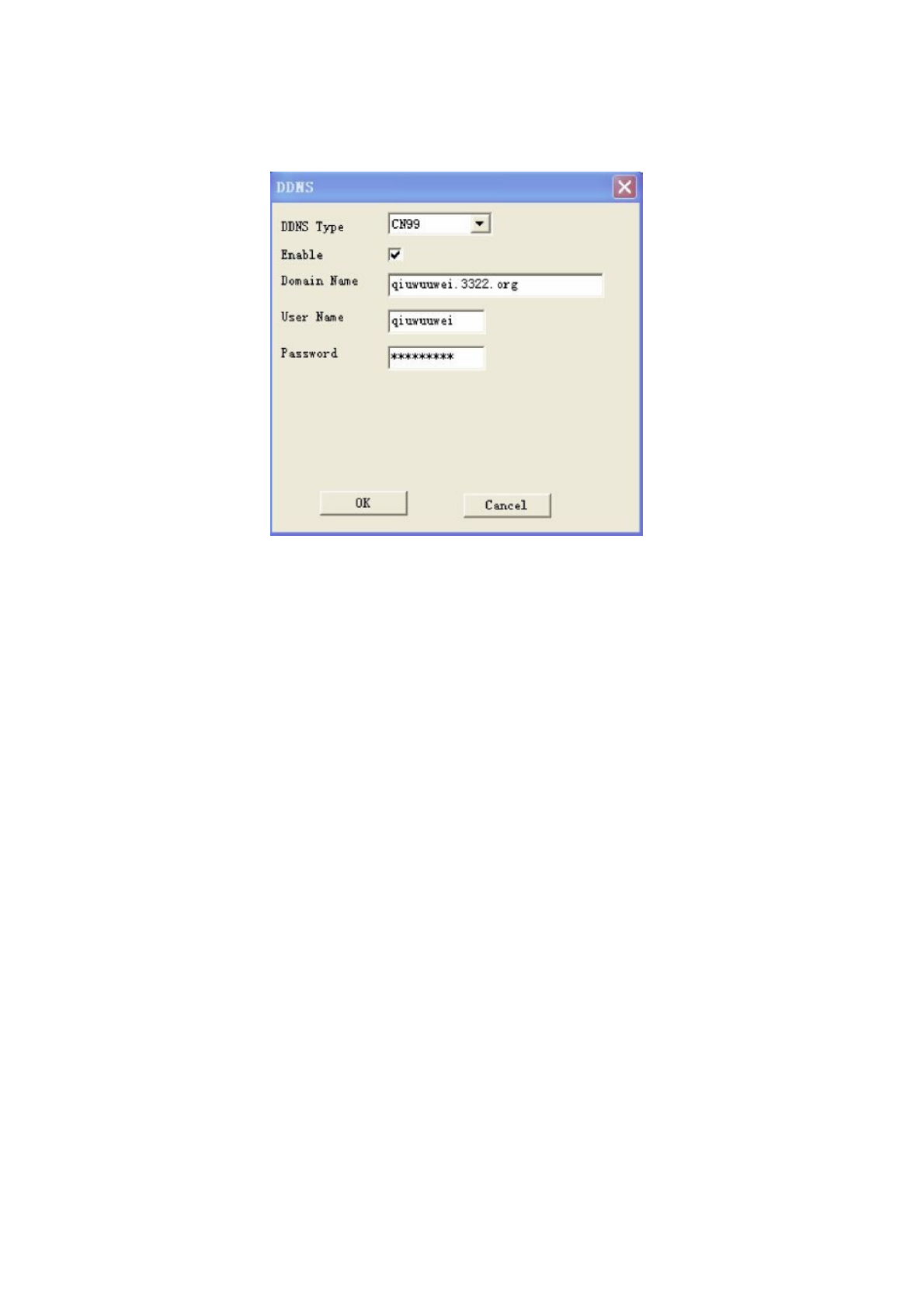
【DDNS】
Pic: 4.22 DDNS setting
To analyze server via dynamic domain name, choose DDNS type
Host domain name:Provide the domain name registered by DDNS;
Server domain name:the domain name that analyze server;
User name:Provide the account registered by DDNS.
Password:Provide the password registered by DDNS.;
When the DDNS is successfully configured and start, you can connect the domain name in the IE
address column to visit.
【FTP setting】
FTP is available only when alarm happens,or alarm activates record and snapshot,it will upload related
record and snapshot pictures to FTP server.
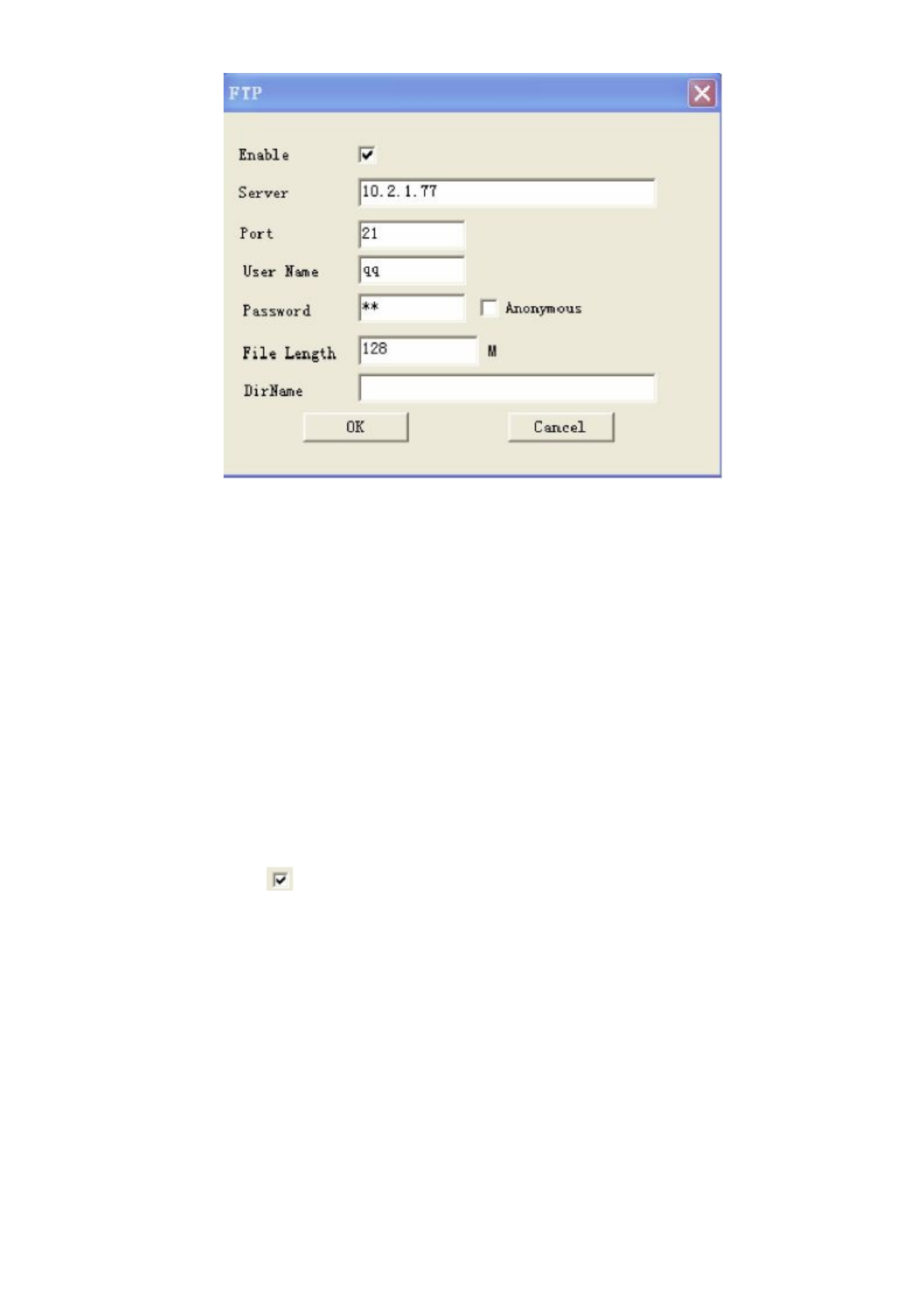
Pic: 4.23 FTP setting
【Enable】Click Enable,then all settings will be available
【Host IP】:IP address of FTP server;
【Port】Domain Port of FTP,default 21
【User Name】User name of FTP
【Password】Password of user
【Cryptonym】:tick
means chosen, choose this, there is no need to set user name and password.
【Max File Length】Max length for upload files at every packed,default 128M
【Remote path】:the directory to upload file
Remark:the user should have the authority to upload file to server firstly.
【ARSP】
Startup DDNS server to add devices and manage it in the DDNS server
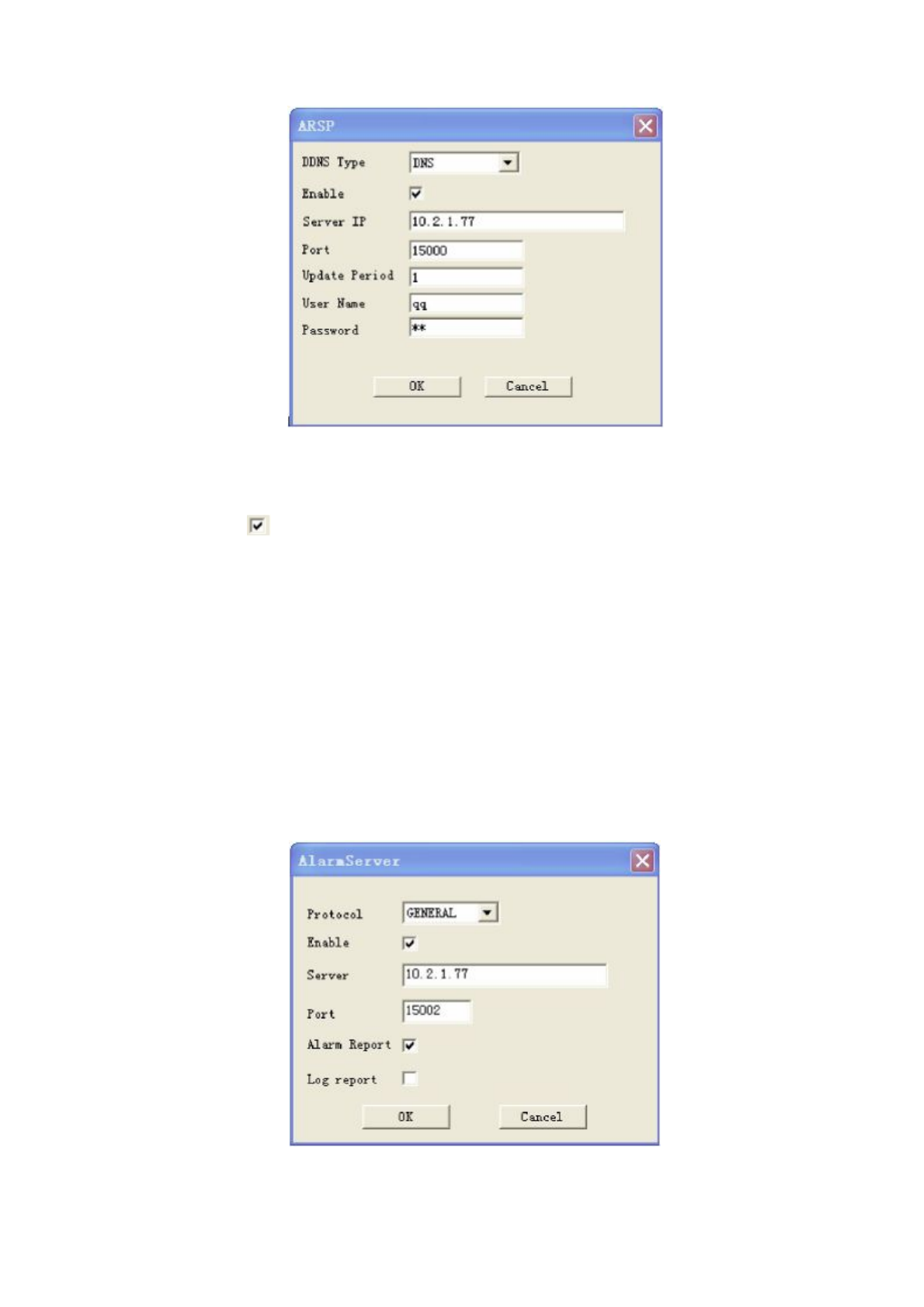
Pic: 4.24 ARSP setting
【type】:choose DNS
【Enable】:tick
means chosen, setting is valid only when it is enable.
【server IP】:IP address of DDNS server
【Port No】:port No of device, corresponding to the listen port of DDNS;
【User name】:the user name that for device to log-in DDNS;
【Password】:password for above user name
【upgrade period】:Time interval of device synchronously to DDNS.
Remark:need to set up DDNS server before using
【Alarm center】
When alarm happens, report alarm information to alarm server
Pic: 4.25 Alarm center setting
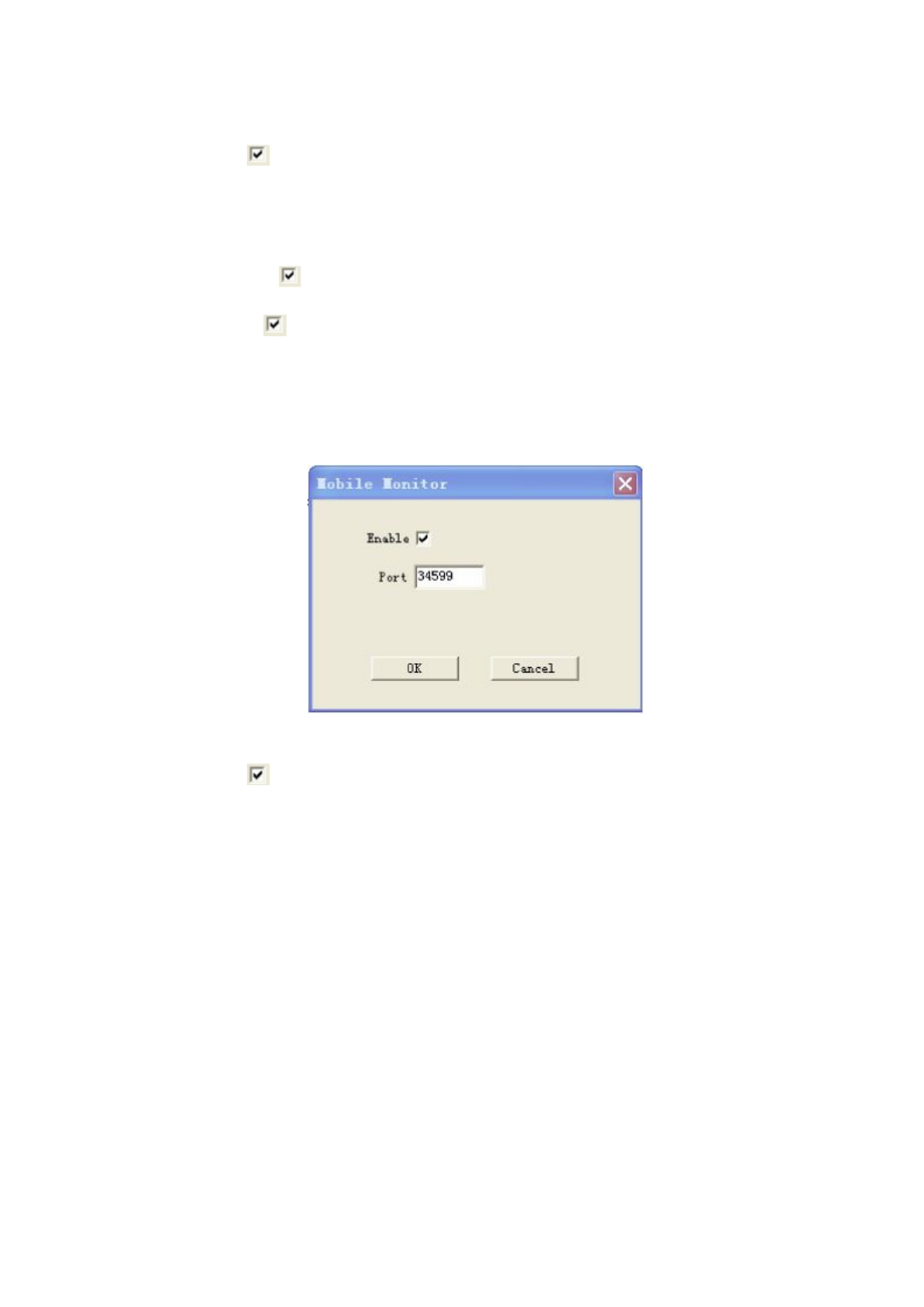
【Protocol】protocol type is GENERAL;
【Enable】tick
means chosen, setting is valid only when it is enalbe
【Server IP】IP address of Alarm Server;
【Port No】Port No. of device
【
Alarm report
】
tick
【Log report】tick
means chosen, report alarm information to server
means chosen, report log information to server
【Mobile monitor setting】
To visit the device by mobile,pls make a router mapping of this port and use CMS to monitor and
operate it by protocol.
Pic: 4.26 Mobile monitor setting
【Enable】tick
means chosen, open mobile monitor function, setting is valid only when it is enable.
【Port】port no for mobile monitor, which you need to make a router mapping of if want to visit it by
mobile
【UPNP】
UPNP protocol can auto port forwarding on router,make sure UPNP is enable on router before use
it.
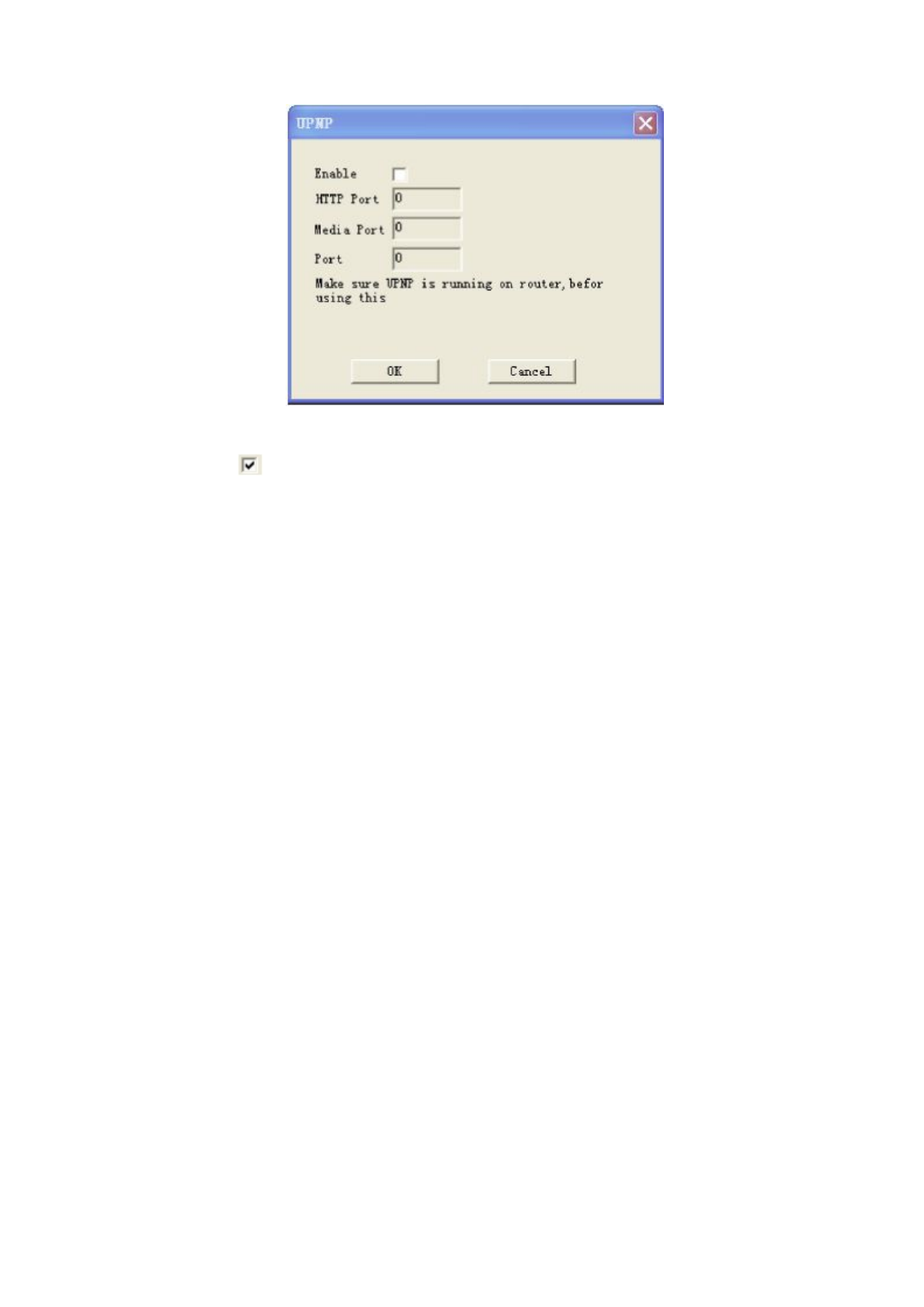
Pic 4.27 UPNP setting
【Enable】tick
means chosen,open UPNP function,setting is valid only when it is enable
【HTTP】:Route will automatically distribute HTTP port for the device, when IE viewing, it need this
port;
【TCP】:Router will automatically distribute TCP port for the device, when monitoring via CMS, it
need this port.
【MobilePort】Router will automatically distribute Mobile Port for the device, when mobile monitor, it
need this port.
4.4.5 GUI display
At local preview inteface, including:Channel name, Time title, Channe title, Region cover
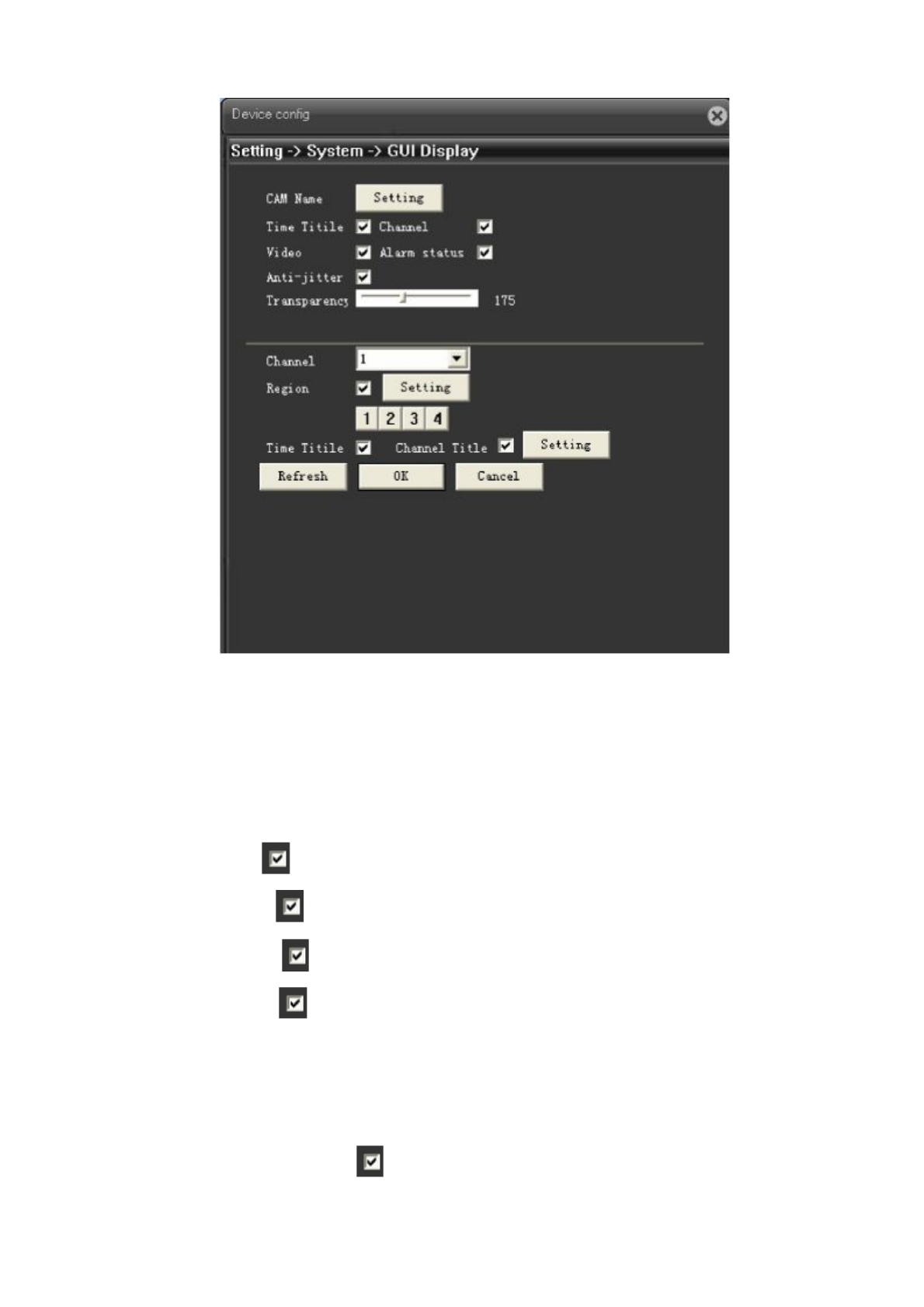
Pic: 4.28 GUI display
【Channel Name】Click the channel name modify button and enter the channel name menu. Modify
the channel name. The 16 Chinese characters and 25 letters are supportive.
【Time title】tick
【channel title】tick
【record status】tick
【Alarm status】tick
means chosen, to shows the system time on monitoring page;
means chosen, show channel No at monitoring page.
means chosen, show the record status on monitoring page
means chosen, show the alarm status on monitoring page.
【Transparency】choose the transparency of background image, span within: 128~255;
【Resolution】set resolution of monitor;
【Channel】choose channel No that set for encode output.
【Region
Cover 】tick
,choose
region
cover
quantity,
then
click
setting
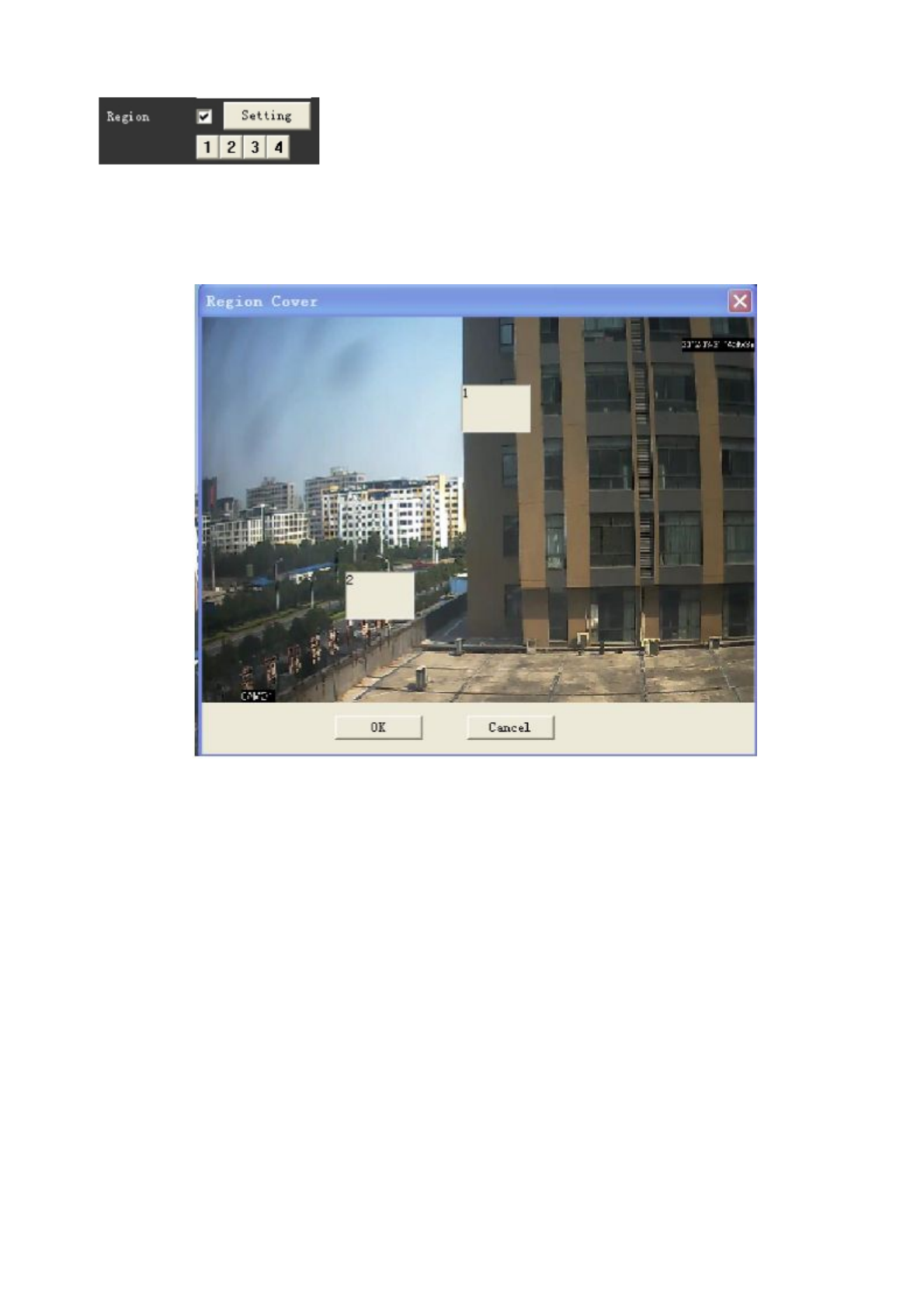
,enter related channel, user can use mouse to choose any size of cover
region, (the covered region, video output should be in black)
【Time title】与【Channel title】set time title and channel title whether need be show out and the
position to show.
Pic: 4.29 region cover setting
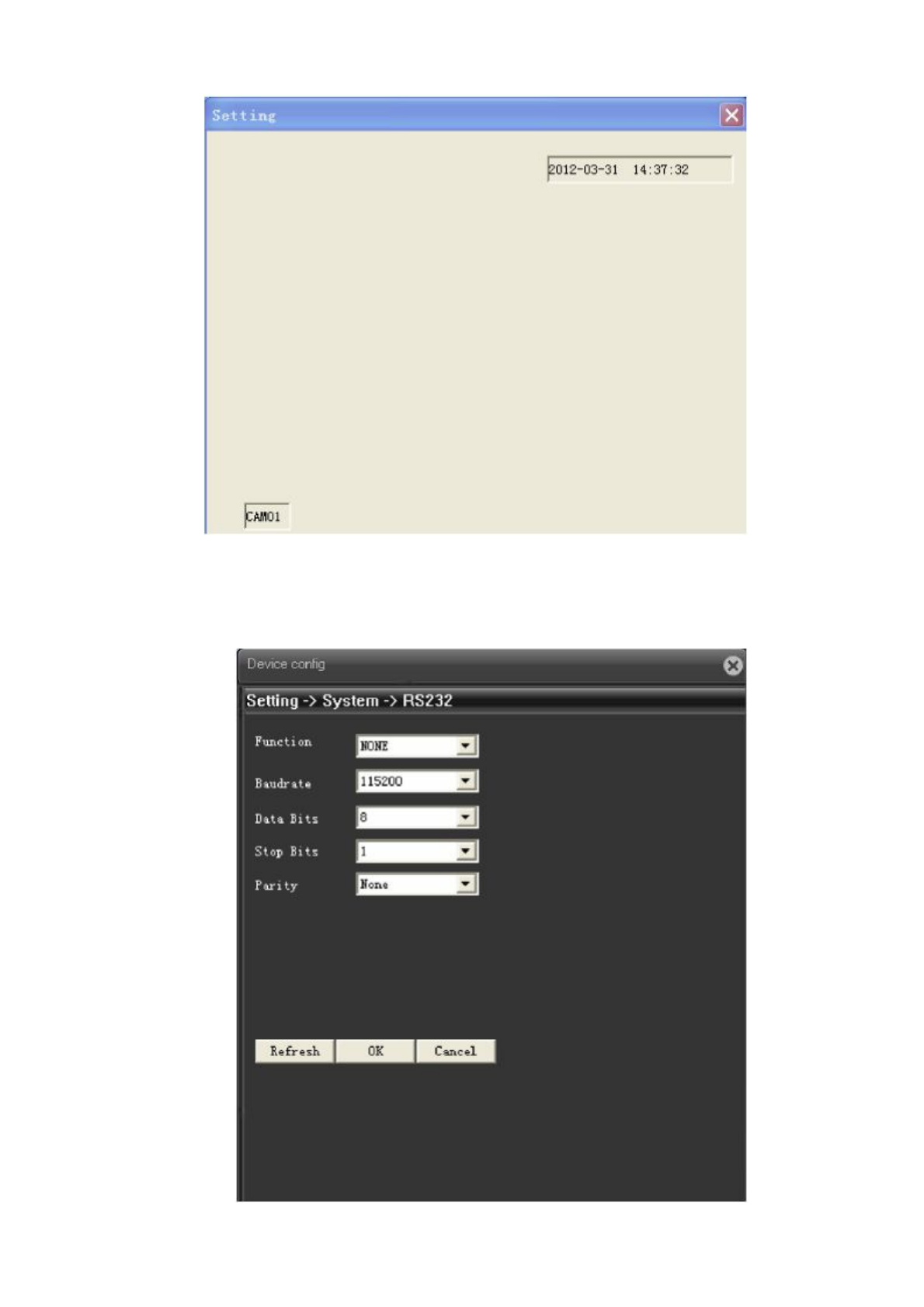
Pic: 4.30 Channel and time title setting
4.4.6 RS232
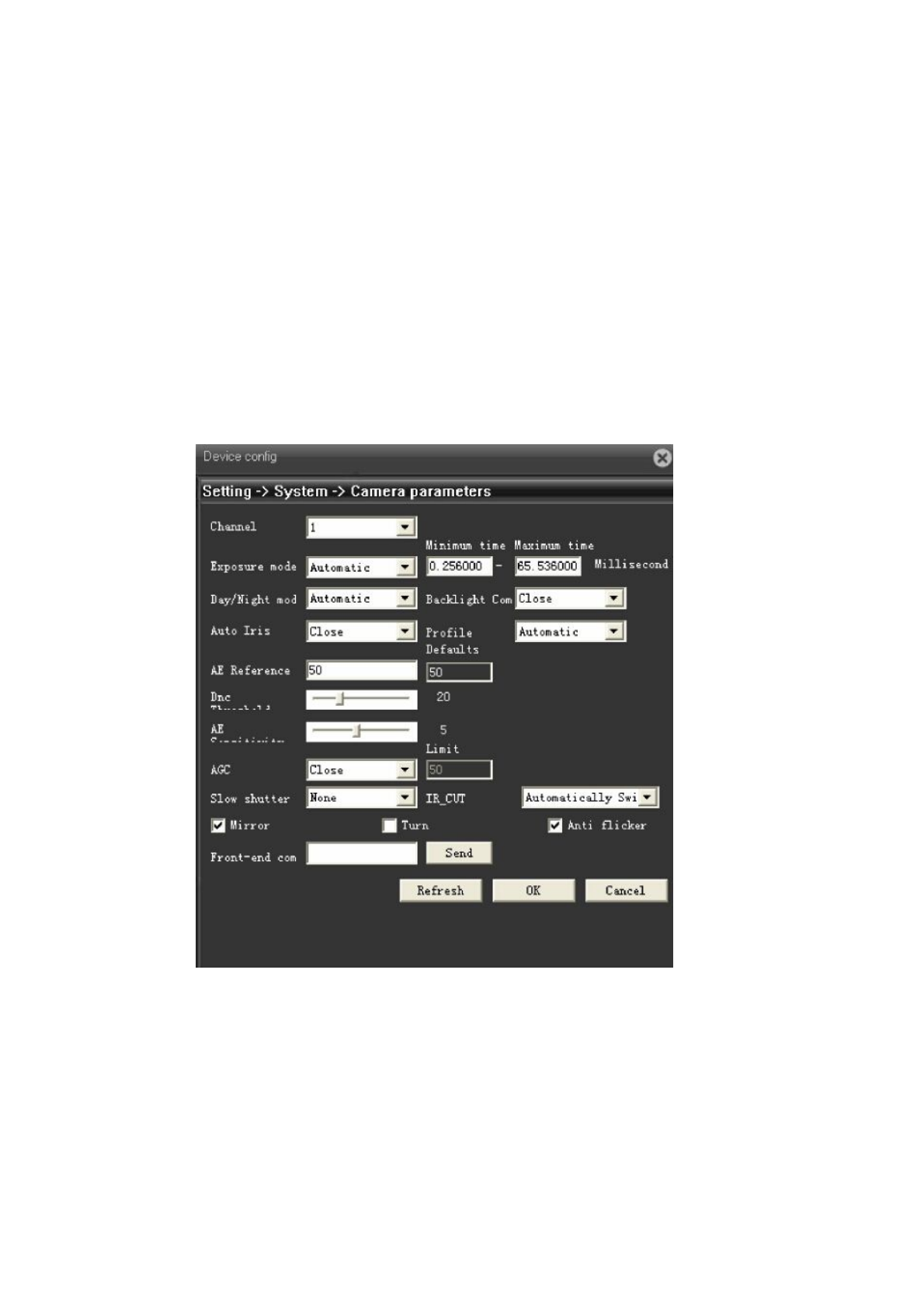
Pic: 4.31 RS232
【Serial Port Function】Common serial port is used to debug and update program or set up specific
serial port.
【Baud rate】Choose the corresponding baud rate length
【Data bits】Include 5-8 options.
【Stop bits】Include 2 options;
【Parity】Include odd, even, mark, space.
4.4.7 Camera parameter
Pic: 4.32 camera parameter
【Expose】can choose automatic(0.1 milisecond-80 milisecond), or manual(1/25,1/50,1/120,
1/250,1/500,1/1000,1/2000,1/4000,1/10000),default is automatic
【Day/night mode】can choose auto/color/ black and white, default is auto;
【Backlight compensation】can choose on or off;
【auto iris】can choose on or off;

【Porfile】can choose indoor or outdoor or auto, default is auto
【AE reference】can choose integers data between 0—100, default is 50;
【AGC】can choose on or off, limitation is between 0—100;
【Slow shutter】can choose none, low, medium, high, default is none.
【IR_CUT】can choose automatically switch or IR synchronous switch, default is automatically
switch
【Mirror image】tick ,means enable the convert of left and right of monitoring page
【Over turn】tick ,means enable the convert of up and down of monitoring page
【Anti-flicker】tick ,enable anti-flicker to the fluorescent light
【Front-end Command】fill in command and send out, front end of IP camera will carry out this
command
4.5 Advanced
Advanced menu including:HDD manage、Account、Auto Maintain、Default、Import & Export、
Upgrade、Reboot
4.5.1 HDD manage
To config TF card that installed in device. Menu shows the information of current TF card, including:
type, status, total capacity. Operation to TF card including: set Read/Write, Read only, Redundant,
Format disk, Recover, Partition, etc. Select the TF card, then click function button on the right side.
Remark:Read/Write:can read data and also can write data into it;
Read only:only can read data from the disk, but can not write data into it.
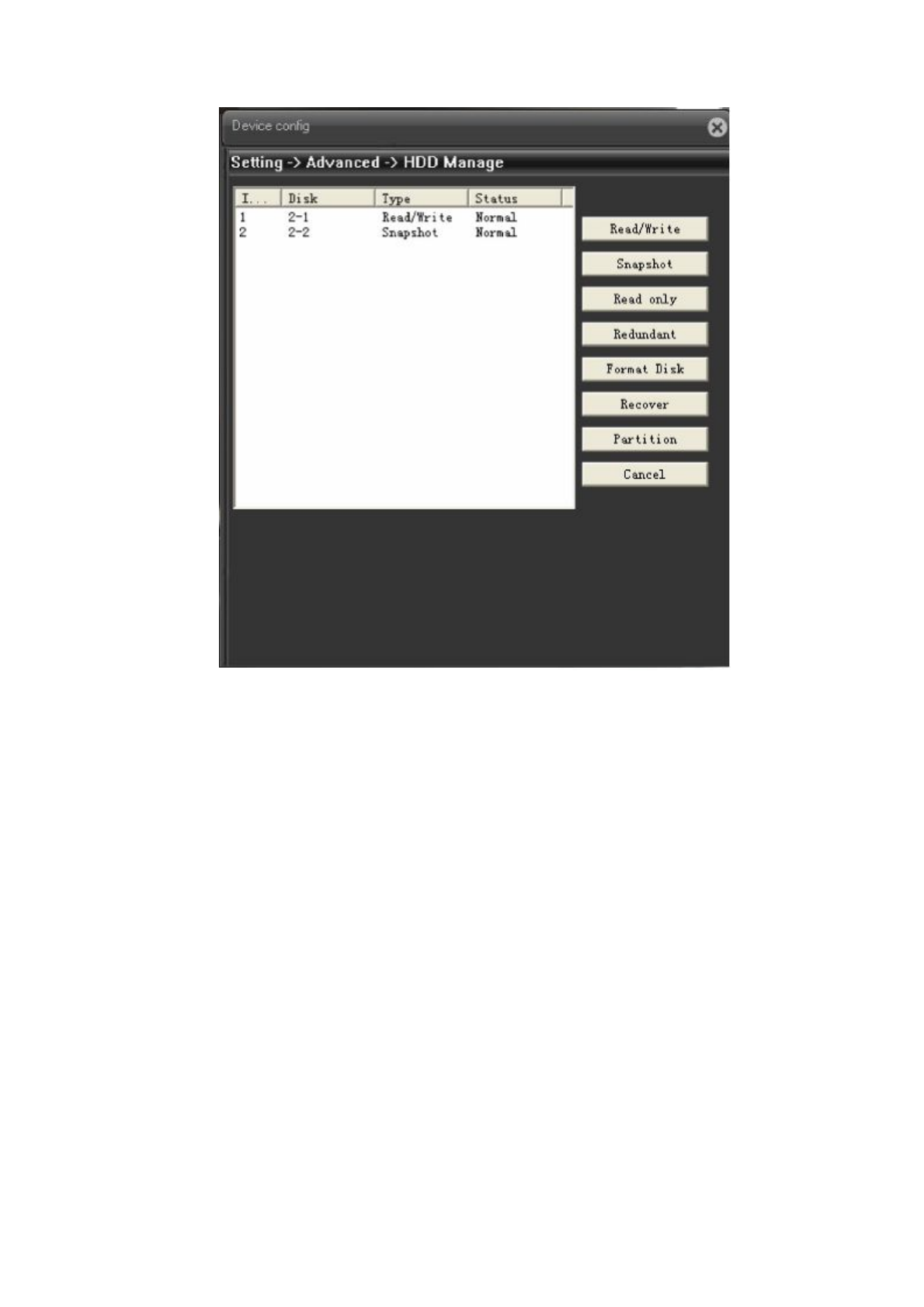
Pic: 4.33 HDD manage
4.5.2 Account
Manage the user authority of this device
Remark:1. The character length is 8 bytes at most for the following user and user team name. The
blank ahead or behind the character string is invalid.The middle blank in the character string is valid.
Legal characters include: letter, number, underline, subtraction sign, dot.
2. There is no limit in the user and user group. You can add or delete the user group according to
user definition. The factory setup include: user\admin. You can set the team as you wish. The user
can appoint the purview in the group.
3. The user management include: group/ user. The group and user name can not be the same. Each
user only belongs to one group.
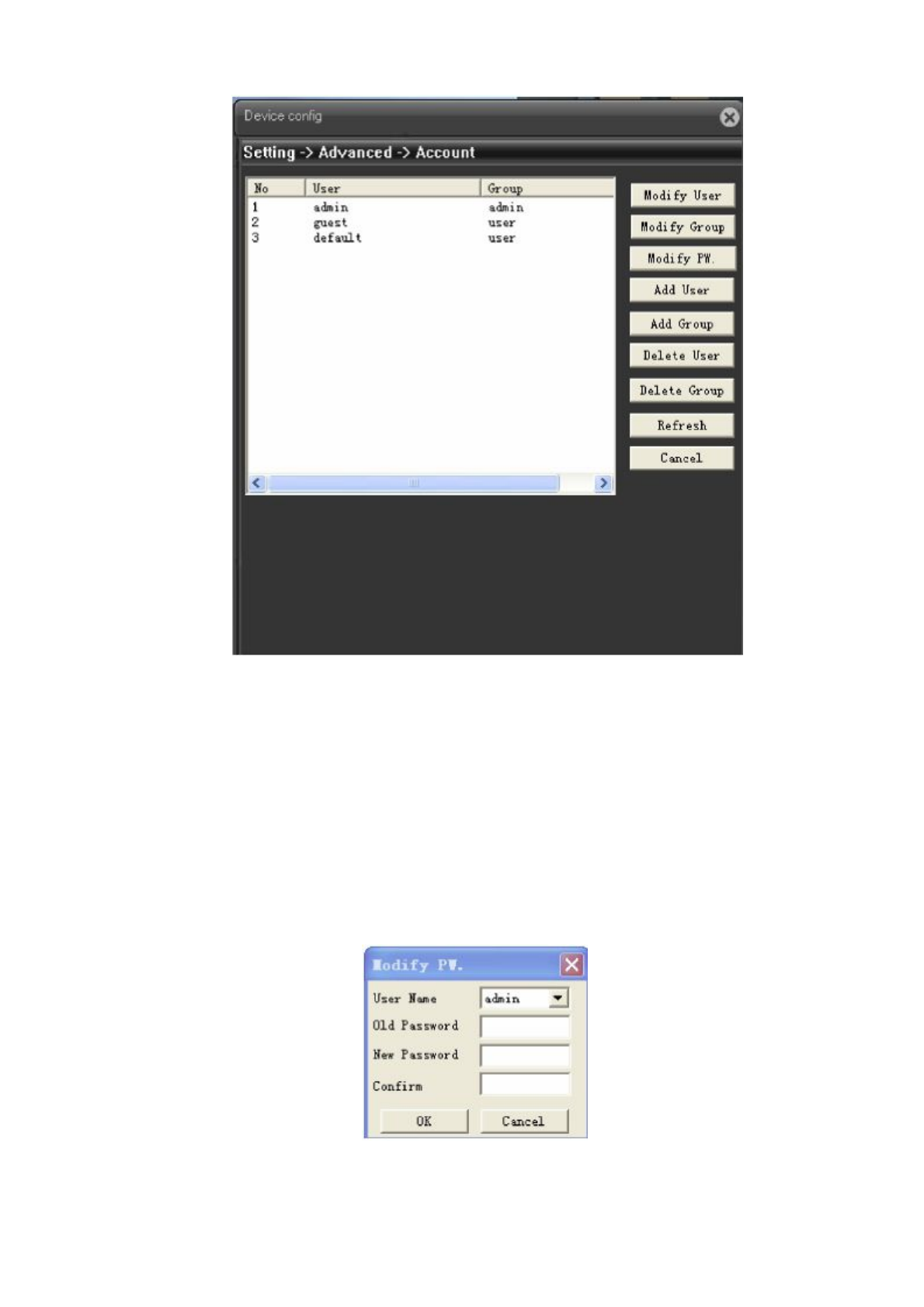
Pic: 4.34 Account
【Modify User】Modify the existed user attribute.
【Modify Group】Modify the existed team attribute.
【Modify Password】Modify the user password. You can set 1-6 bit password. The blank ahead or
behind the char string is invalid. The middle blank in the char string is valid,
Note:The user who possess the user control authority can modify its own or other users
password
Pic: 4.35 Modify password
【Add user】Add a user in the team and set the user purview. Enter the menu interface and input the
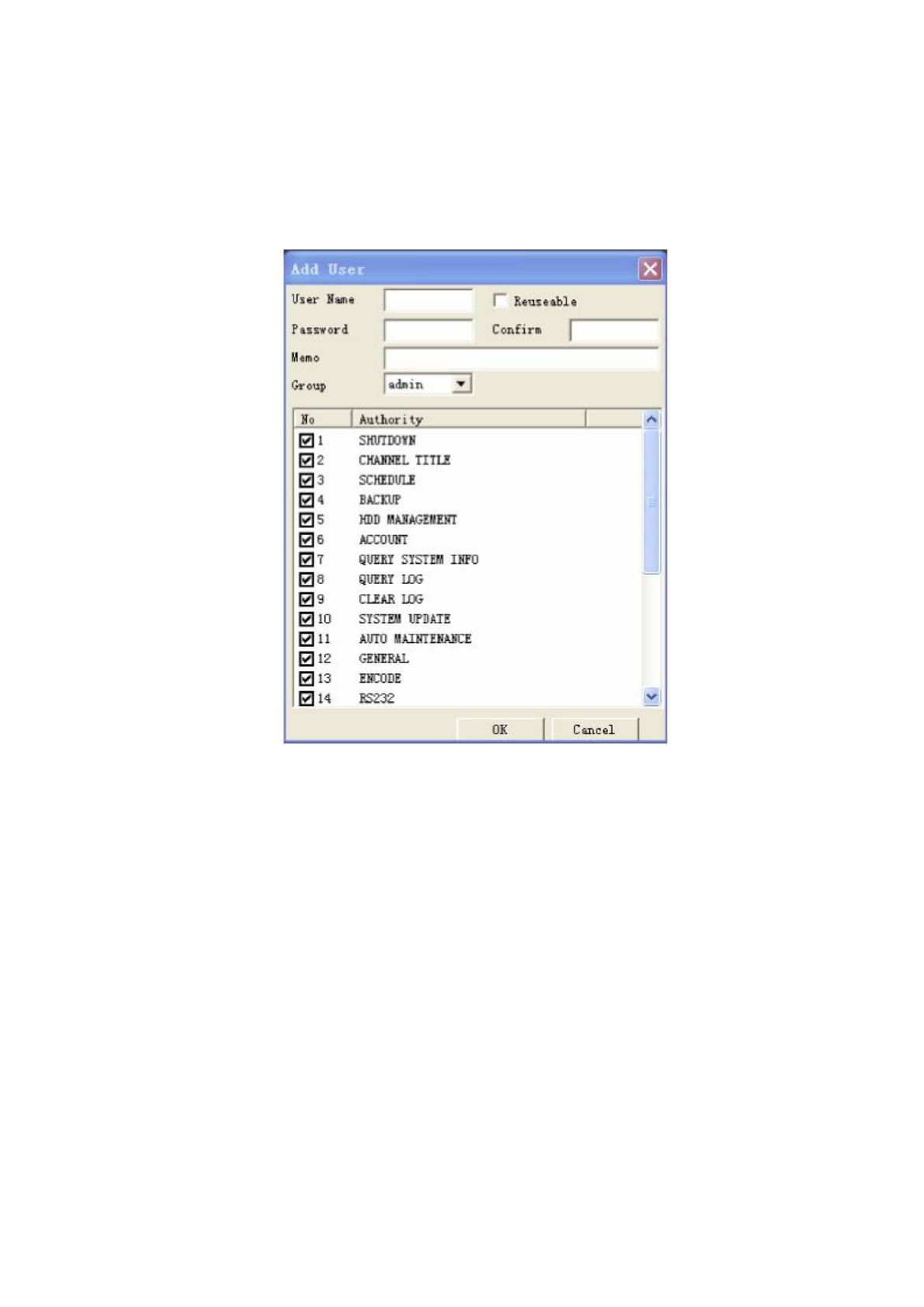
user name and password. Choose the team and choose whether cover using the user. Cover using
means that the account can be used by multiple users at the same time.
Once choose the team the user purview is the subclass of the team.
We recommend that the common user’s purview is lower than the advanced user.
Pic: add user
【Add Group】Add a user team and set the purview. There are 36 different purviews: shut down the
equipment, real time surveillance, playback, recording setup, video file backup and so on.
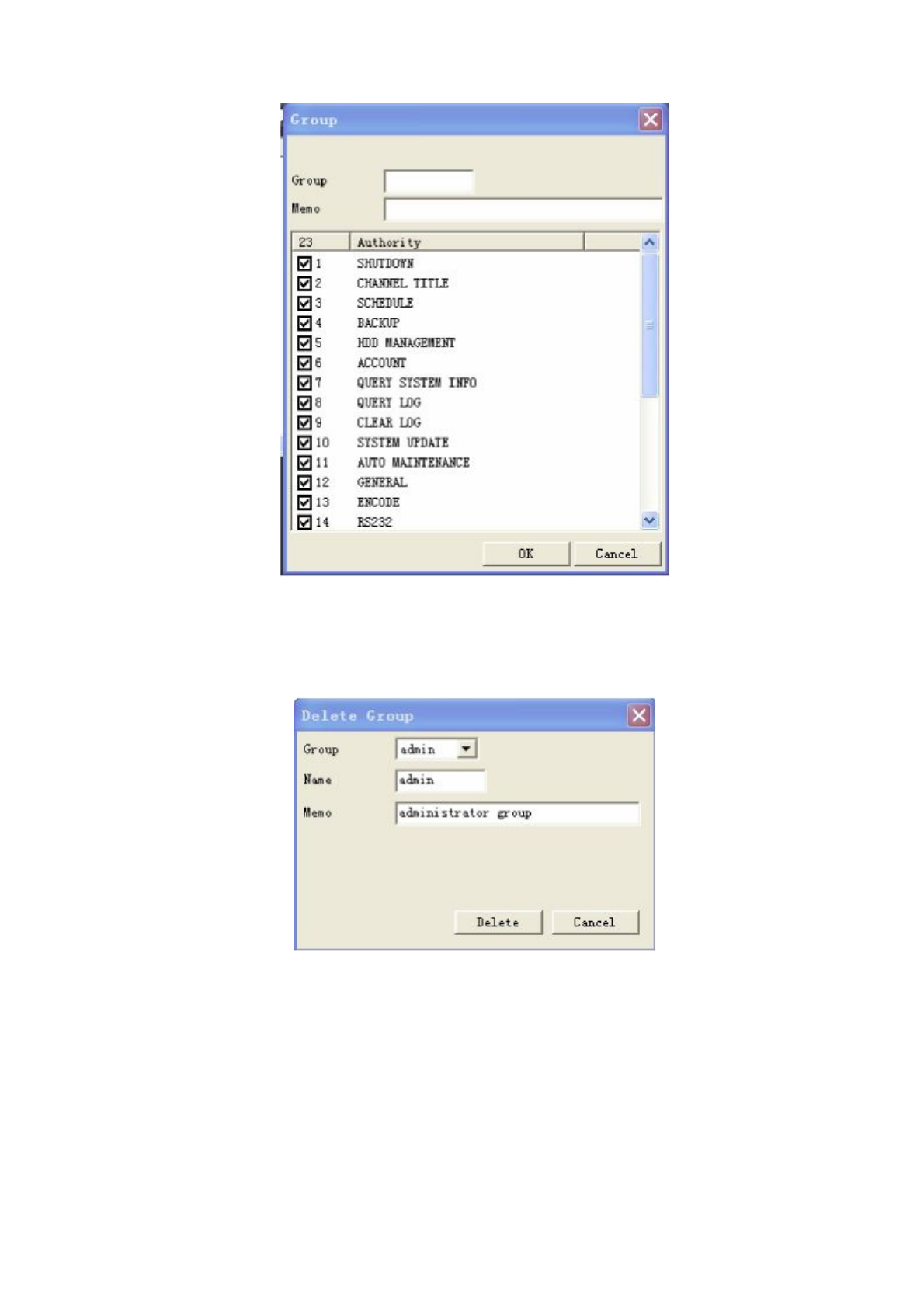
Pic: 4.37 add group
【Delete user】Delete the current user. Choose the user and click delete user button.
【Delete Group】Delete the current group. Choose the group and click delete group button.
Pic: 4.38 delete group
4.5.3 Auto-maintain
The user can set the auto reboot time and auto file deleting time limit.
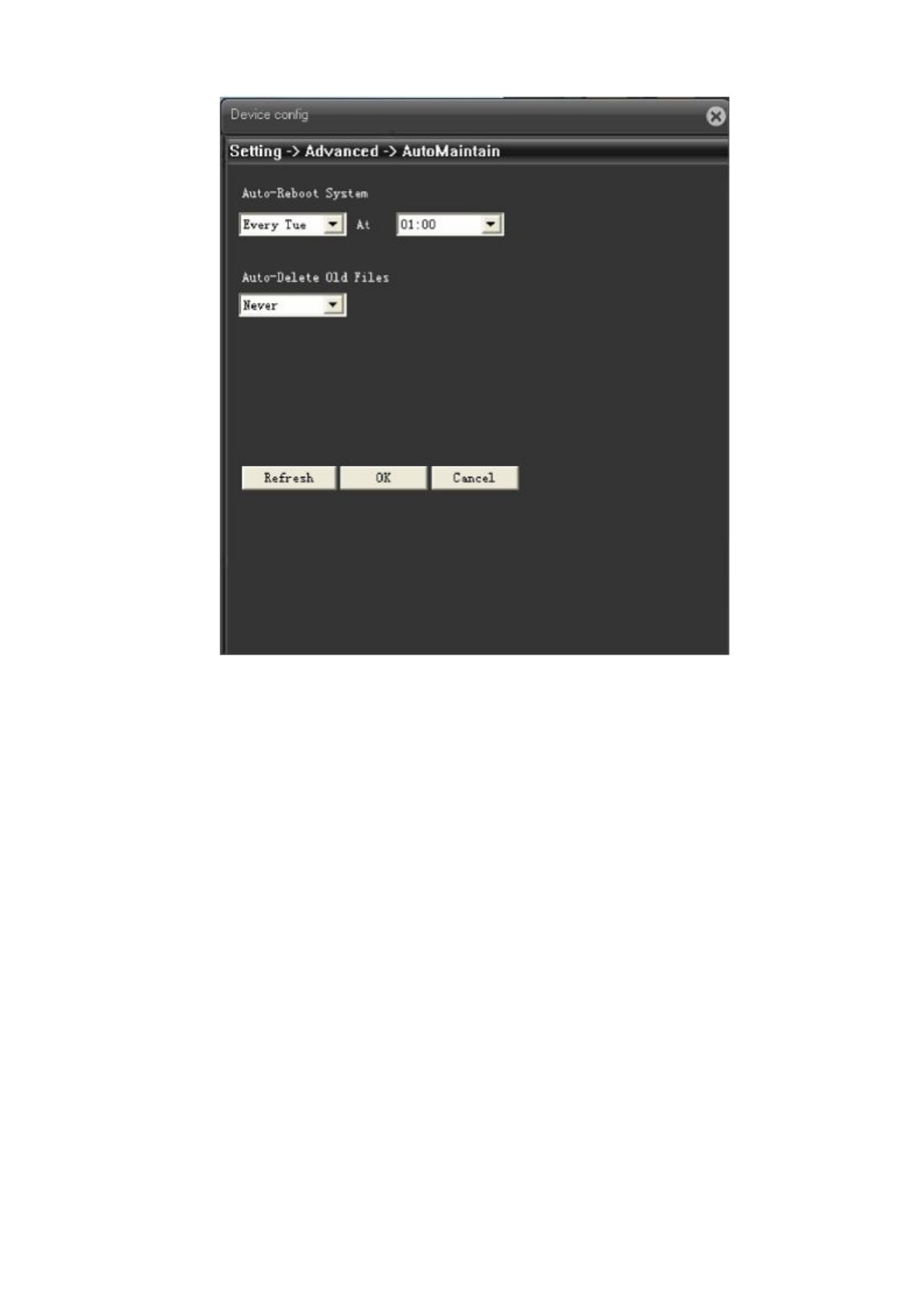
Pic: 4.39 auto maintain
4.5.4 Default
The system restore to the default setup. You can choose the items according to the menu.
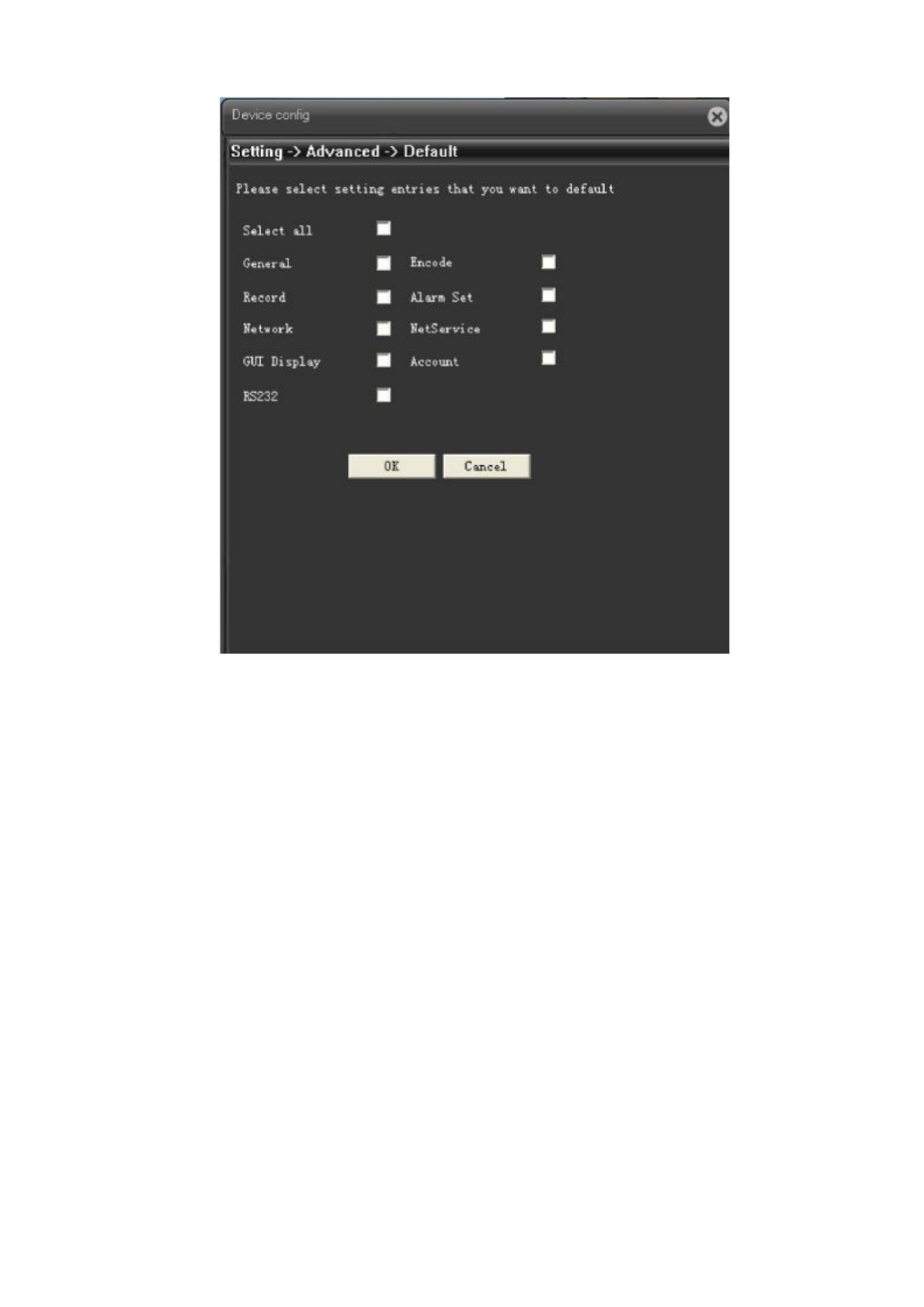
Pic: 4.40 default
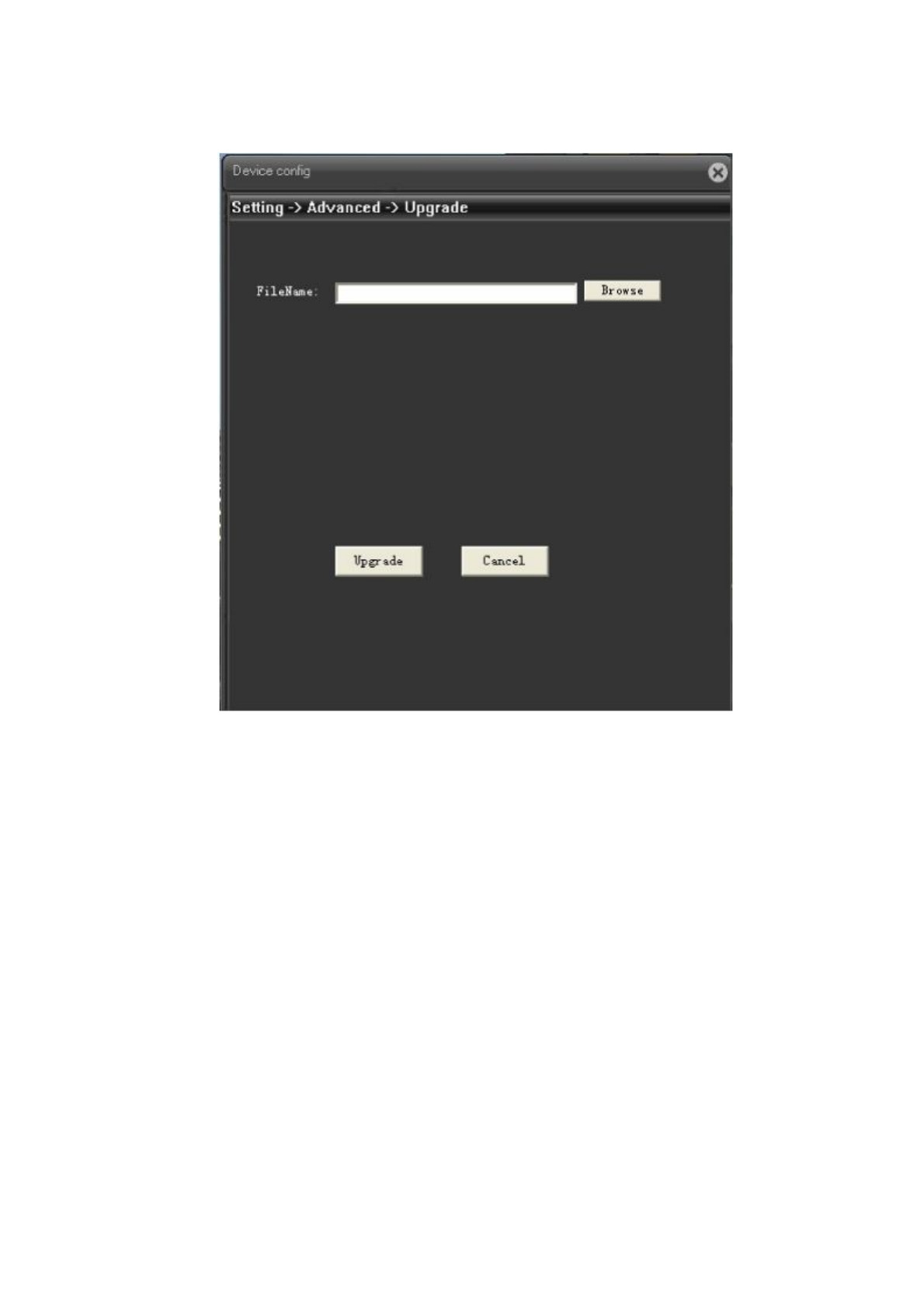
4.5.5 Upgrade
Pic: 4.41 system upgrade
【upgrade file】to select upgrade file via IE or client software to do upgrading.
4.5.6 Reboot
To do soft reboot of IP camera
4.6 Device info
Shows information of device, including:HDD info、Log , Version
4.6.1 HDD Info
Display the hard disk state: type, overall capability, residual capability, the recording time and so on.。
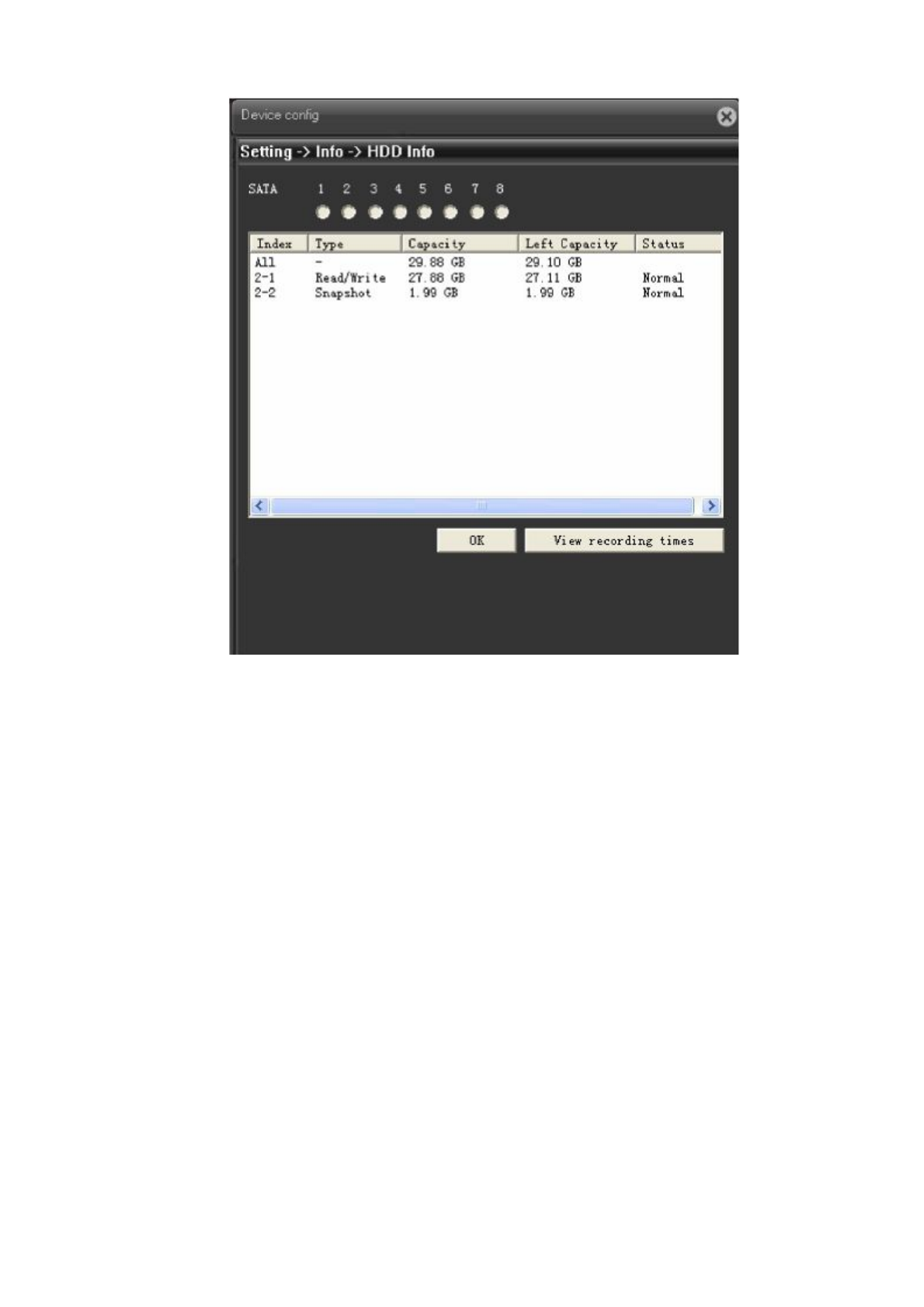
Pic: 4.42 HDD info
Tips :means that the hard disk is normal. X means that the hard disk is broken-down.- means that
there is
no hard disk. If the user need to change the damaged hard disk, you must shut down the DVR
and take up all the damaged hard disks,then install a new one.
* behind serial number means the current working disk such as 1*. If the corresponding disk is
damaged, the information will show “?”.
4.6.2 Log
Base on set searching way to check log information
LOG type can be divided into:system operation, configuration operation, data management, alarm
affair, recording operation, user management, file management and so on. Set the time section to look
up and click the look up button. The log information will display as a list. (one page is 128 items) Press
Page up or Page down button to look up and press delete button to clear all the log information.
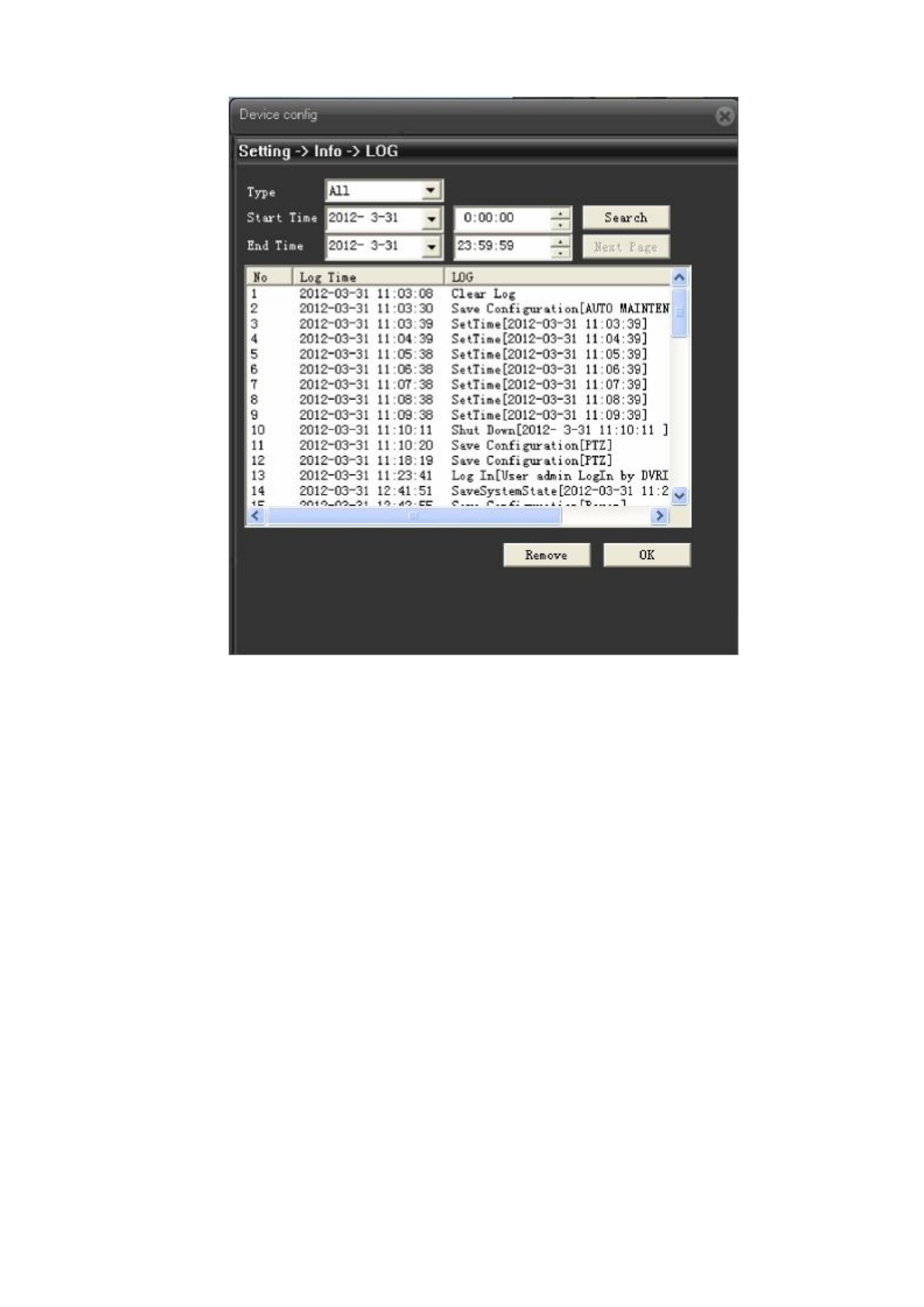
Pic: 4.43 Log info
4.6.3 Version
Display the basic information such as hardware information, firmware version, built date , serial No.
and so on.
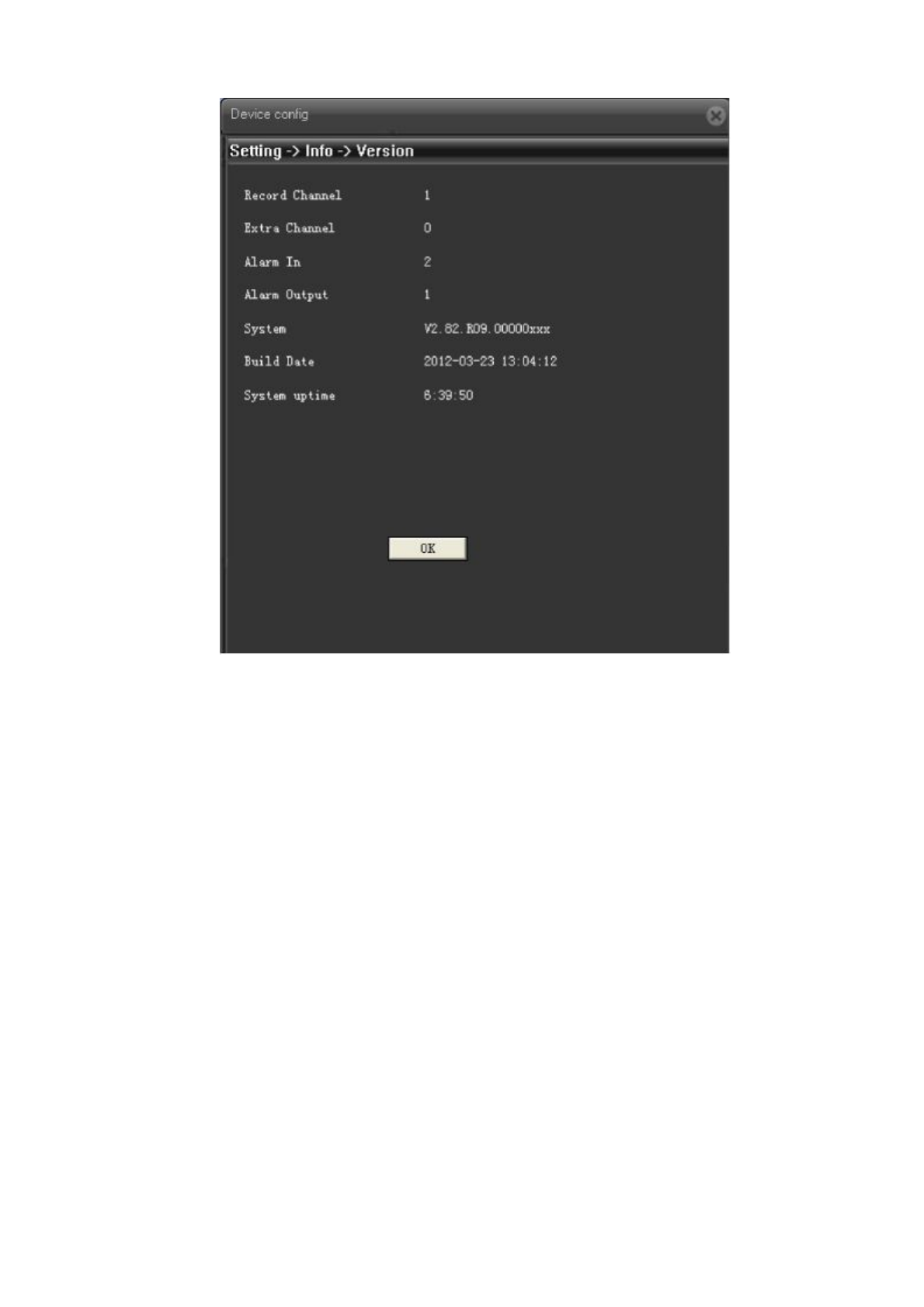
Pic: 4.44 version info
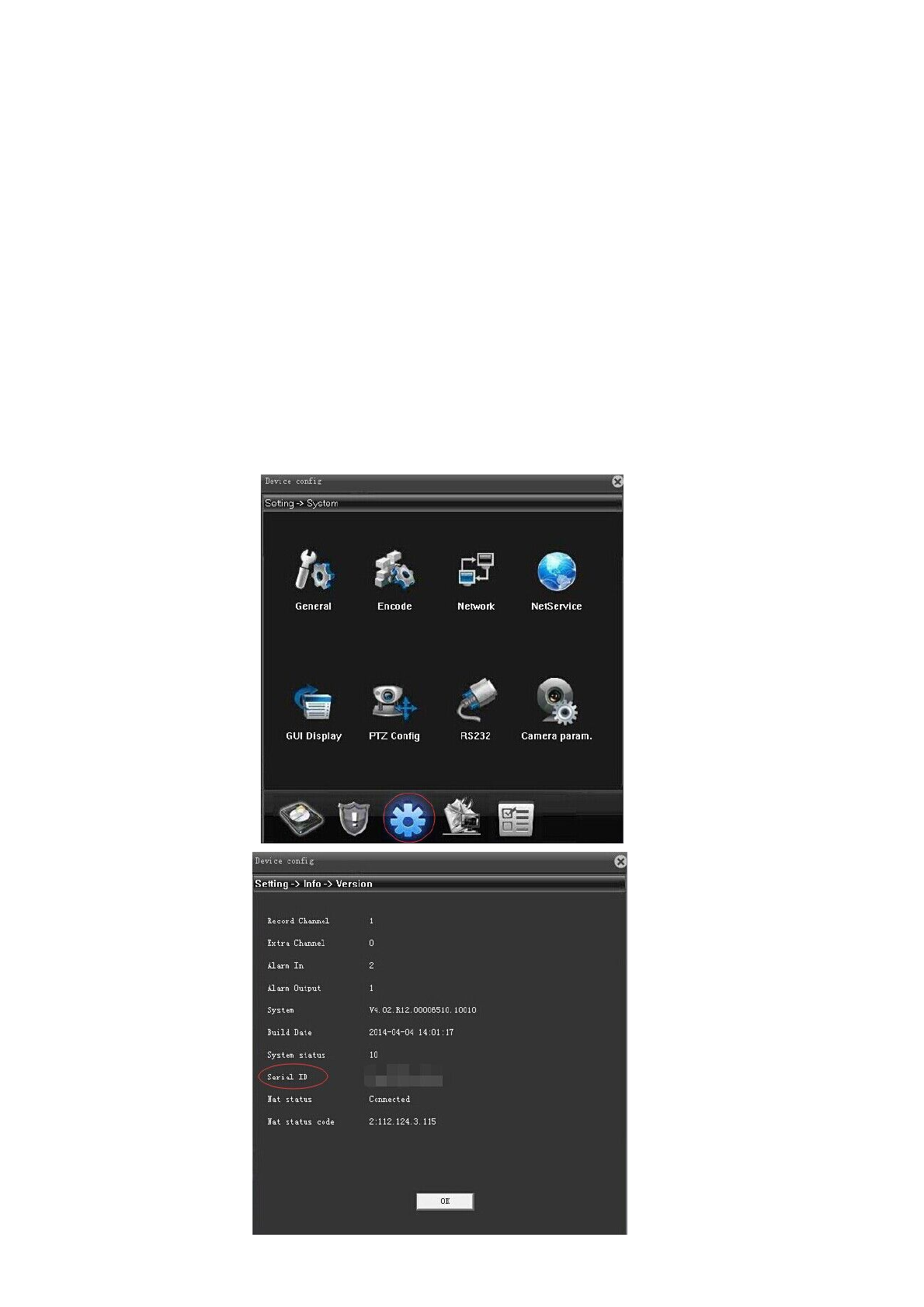
Chapter 5 Basic operations for cloud
5.1 Cloud technology surveillance
Cloud technology, which uses the serial number to get access to the device, not only enables the
device one step on net but also greatly brings convenience for customers to better monitor via wide area
network.
*Note:Device that supports cloud technology should be in the WAN( Wide Area Network )firstly.
Check the connection status of cloud technology
Connect device to WAN first, then input the IP address of the IP camera in browser to view the images ,
enter【Main menu】>【Setting】>【info】>【Version】to find the serial ID of the IP camera.
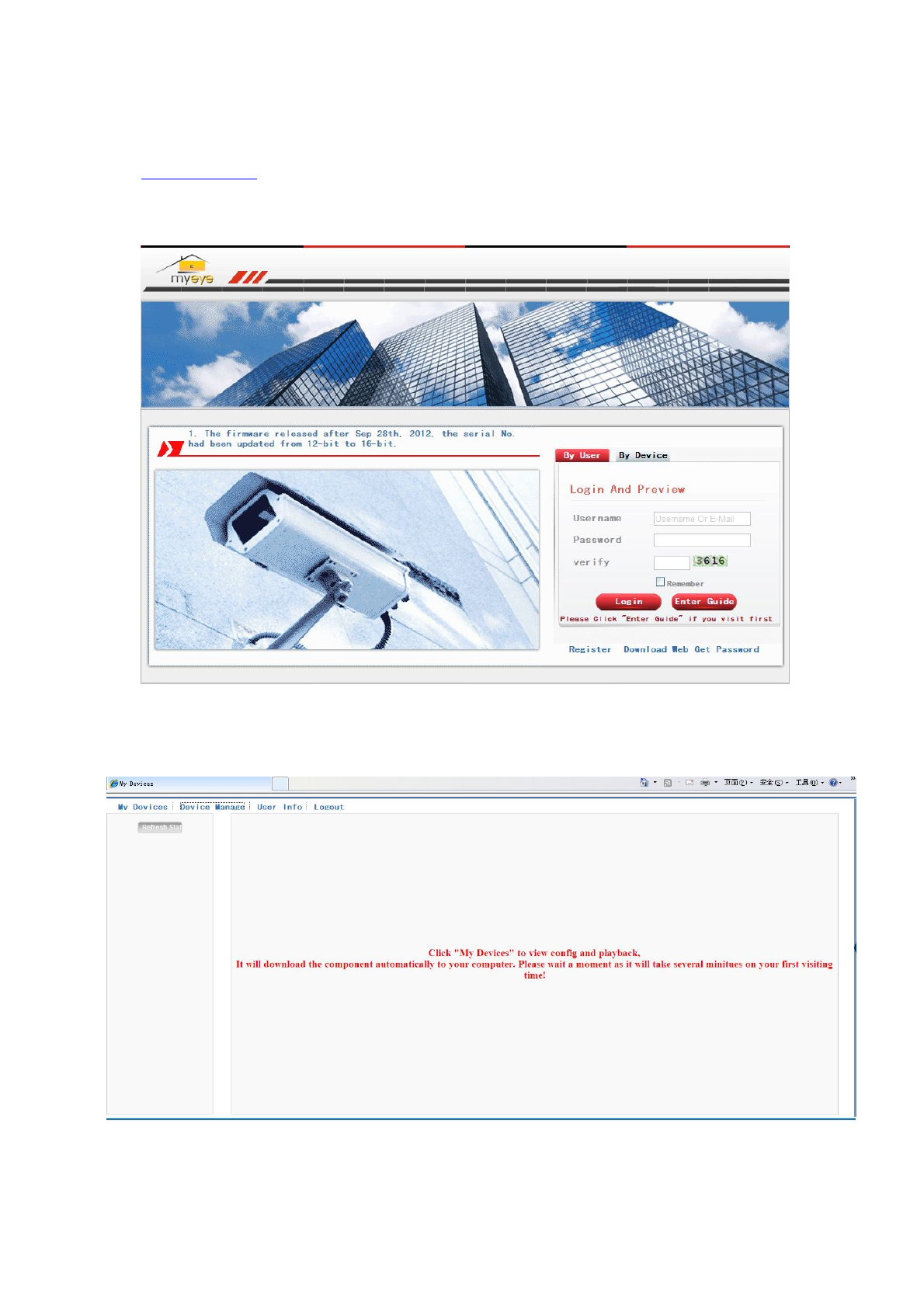
Pic 5.1.1&5.1.2 Cloud ID interface
Log in cloud server
Enter http://xmeye.net to see below log.There are two ways to login: by user and by device, user can log
in freely based on their needs.
*Note: To log in by user, user needs to register at the first time.
Pic 5.2 Cloud login interface
Log in by user
Customer logs in with their own registered user name and password, as below:
Pic 5.3 cloud technology operation interface
Device management:
Mainly used for adding device, click add to add a serial number for the device to be monitored.
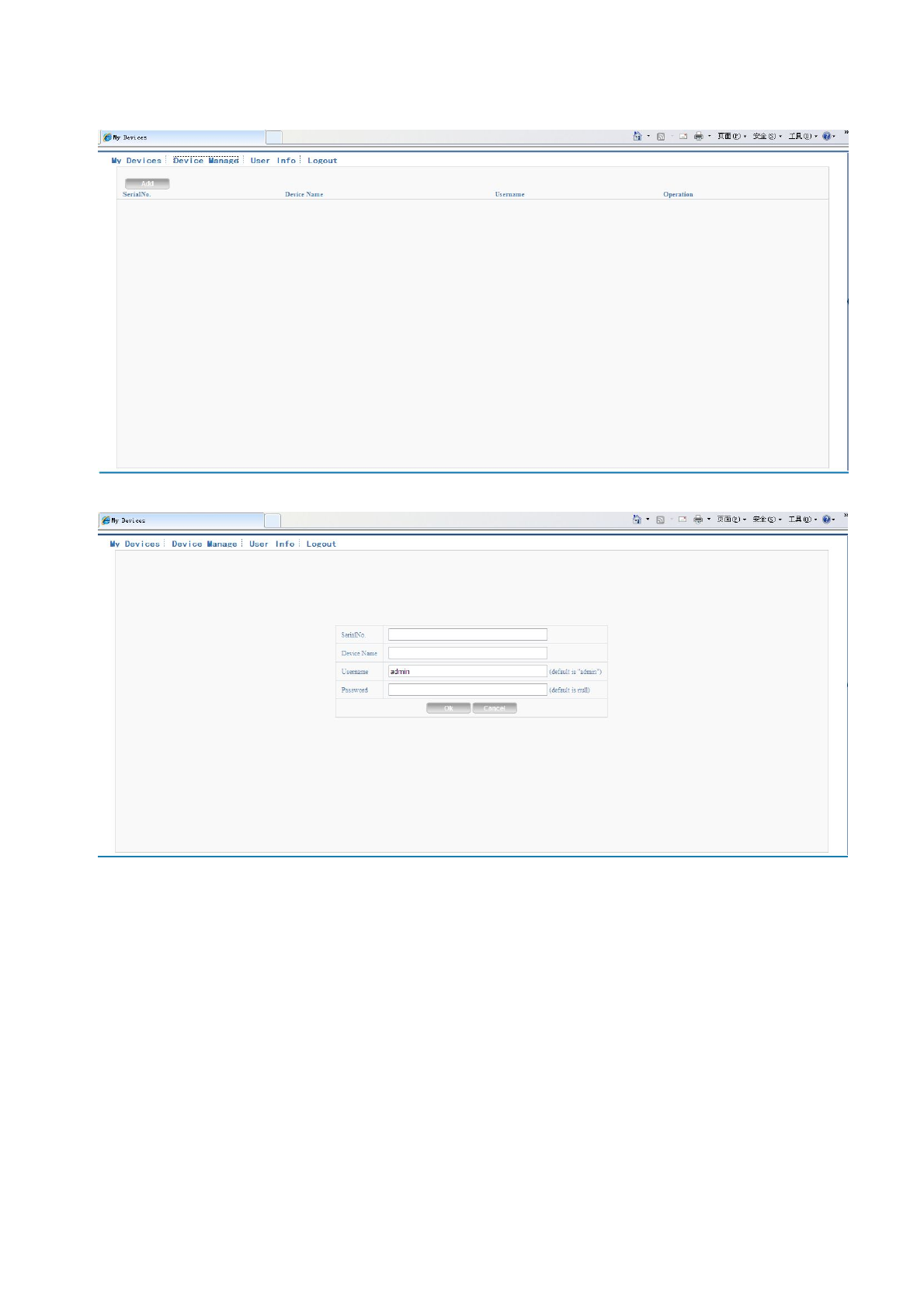
Pic 5.4 device management interface
Pic 5.5 add interface at device manage
Note:in pic 5.5, the user name means the user name of monitored device, password means the
password of corresponding user.
My Device
Mainly show all the added devices, click a device name which is successfully connected to the server can
get access to the monitor.
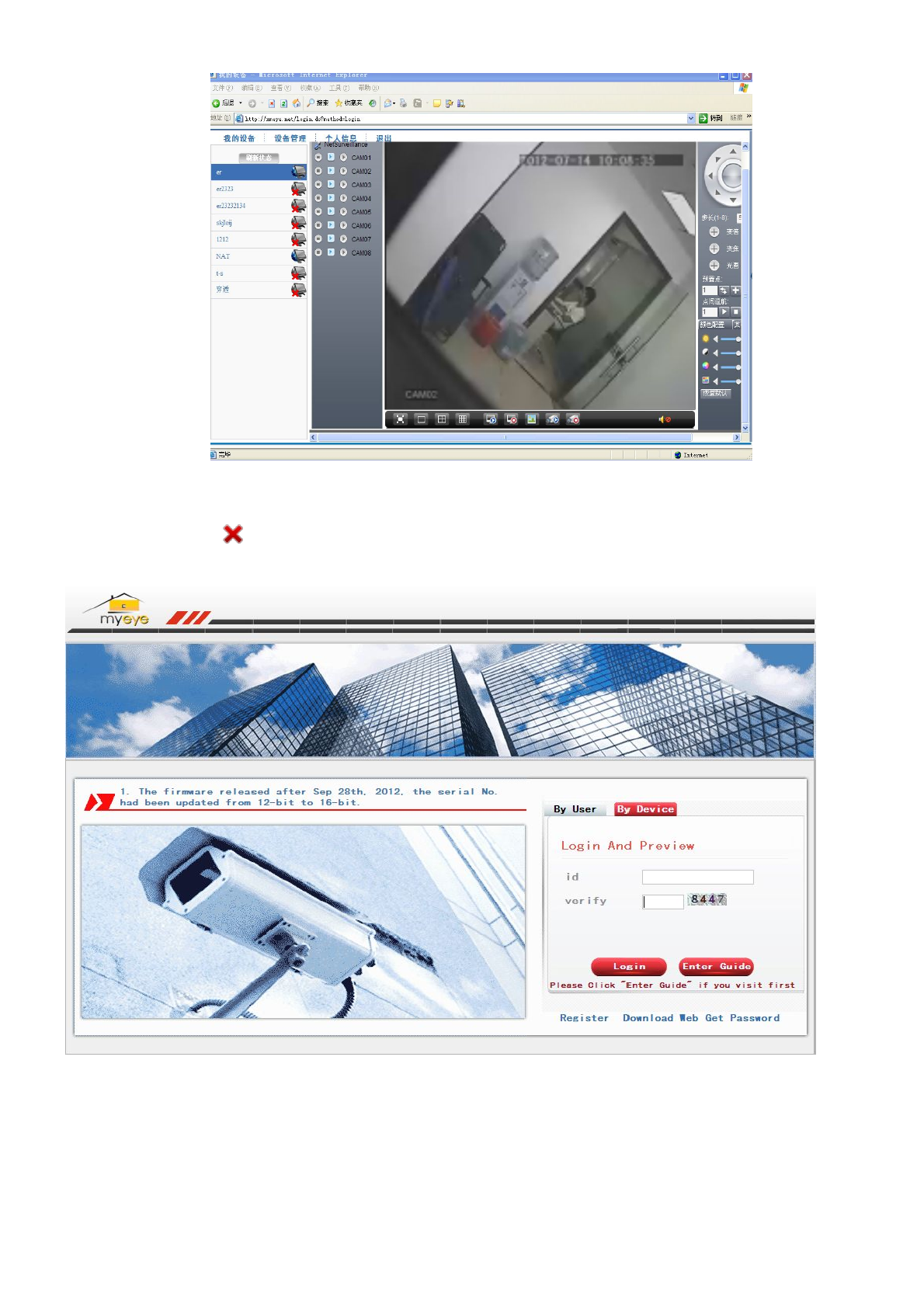
Pic 5.6 monitor page - log in by user
Note:the icon of means offline, the device doesn’t connect to server successfully.
Log in by device
Pic 5.7 log in by device interface
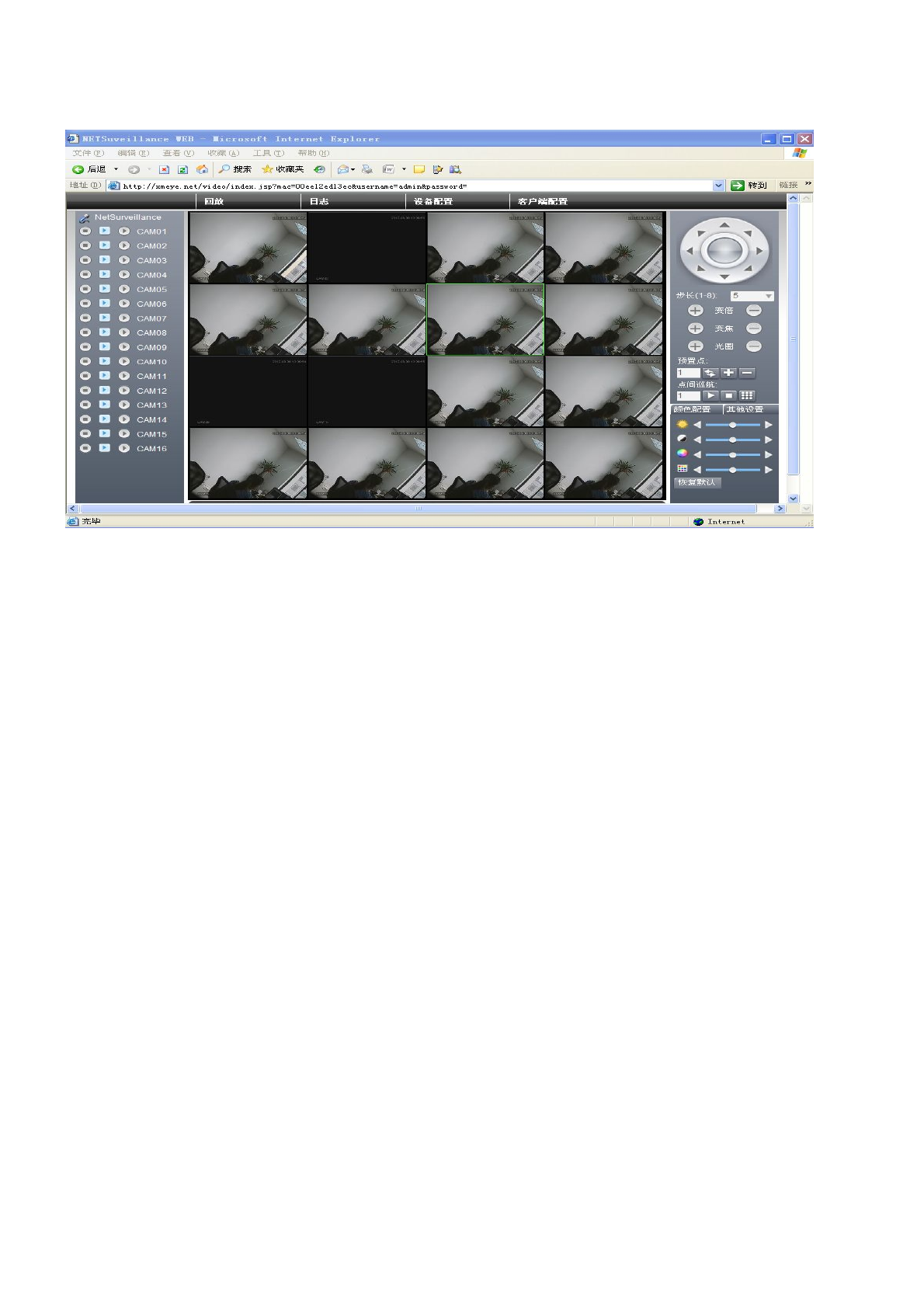
Input the serial number of device and the verify code to monitor and control the device directly.
Pic: 5.8 monitor page - log in by device
Chapter five: FAQ & Maintaince
5.1 FAQ and answer
If the problem u meet is not included in below items, please contact to local technical
support or call customer service of headquarter, we will whole-heartedly serve for you.
2Q:there is dark corner of lens
A:1/3 lens only support CS lens be more than or equal to 6MM, can try to change
with 1/2.5 or 1/2 lens (C mount lens need to add CS adapter ring
2. Q:Image color is bias towards red
A:regularly because the device is in dark position, IR light is auto-on, while the device
is remain in color mode. Compare to CMOS, CCD is less influenced by IR light, under
same condition, CCD is slightly bias towards red.
3.
Q:There is tailing smear of moving object
A:enable the slow shutter makes the frame rate not enough. In order to achieve good
image effect in the dark, we will auto enable the slow shutter, to extend the exposure time,
if exposure time is over 40ms, the frame rate will not enough, that will cause tailing smear,
you can shutdown slow shutter via CMS or WEB.
4. Q:Firmware upgrade fail
A:Few firmware unofficial issued with BUG, can not upgrade via port 34567, but can
upgrade via 34561. this is the reserve port for network upgrading.
5. Q:Can not boot
A:a. Use upgrade tool to see if you can search IP address
b. use monitor to see if there is image come out from analog output, whether IP
1.

address is overlap, etc.
c. got image from analog output but can not search IP address, then to check web
connection interface can not search IP, also analog output do not check power, can
investigate via network indicator.
6.
7.
Q:IPC reboot after power off, using CMS to access, but failed, can not find device.
A:when the device is under rebooting, need use CMS to connect it after a while when
it is finish rebooting.
Q:SD can do partition, after reboot, there is only one partition
A:a. make sure the total capacity of SD card is over 2G, and the space for recording is
over 2G.
b. choose ”always recording” to record a file in SD card, then play it to see if it is
normal.
c. pull out SD c a r d a n d i n s e r t i t i n t o P C , c o p y a c o m p r e s s f i l e t h a t
w ith s am e cap aci ty of your SD car d, if u c an p ut i t i n, if yes, then
cop y it out to see if c an norm al dec om press
8. Q:30W D1 960H 130W 200W how much space will be in each hour.
A:it is related to image quality, different image quality with different bit rate that is showed
out, such as D1, default is 1Mbps 1M(1 second) *60*60/8=450M /hour, regularly, SD card
for recording, suggest to set motion detect and alarm record and front side, other recording
to be save at back side.
9. Q:Monitor image abnormal, such as too bright, image flicker, poor backlight
compensation
A:a. base on the image color from client side and integrate with
local environment to adjust it to be the best
b. adjust camera parameter on client side and integrate with local environment to
adjust it to be the best
10. Q:UPNP function is not working
A:a. target router function is stable, suggest to use TP-LINK router
b. target router have UPNP function and it is enable
c. IP address of camera and router is not in the same network segment.
d. after enable UPNP function of camera and reboot device.
e. reboot target router
11. Q: NTP function in net service is not working
A:enable related function of NTP server.
12. Q:can not search out recent video file, if we set client side recording via CMS
A:If the client side is under recording, you can not search out file, you nee to stop
recording firstly, then you will search out.
13. Q:Client side can not log-in when the IP address was revised, tips with: log-in over
time and can not find device.
A:a. no IP conflict or MAC conflict
b. close client side, log-in again after 10s.
14. Q:WIFI function of IP camera is not working
A:a. WiFi module and device correctly connected.
b. target router support WIFI and it is enable
c. the password of router that device input is correct.
d. the WIFI module is used is 3070 series
e. IP address of device is in the same network segment.
15. Q:Set language in regular via CMS, language of CMS is without change

A:1. Language setting in regular is regarding the web side, not related to CMS
2.CMS client side config – language in regular config is to set language of CMS
16. Q:Camera can not control the connect PTZ
A:Client side PTZ config protocol, address etc should be same as connected PTZ
17. Q:Client side can not search out log info
A:make sure the searching period have log info and not be deleted.
18. Q:Can not upgrade via web side
A:1.firmware before October can not be upgrade via 34567 port, but only 34561 port.
2. if upgrade via 34561 port, need to config encode with resolution lower than
720P,can not set with 1080P.
19. Q:Camera under darker environment, will lose frame.
A:the slow shutter is default enable, it will extend exposure time in darker environment,
then the frame rate will be not enough, you can close it via CMS.
20. Q:Monitor image of camera is not clear and with mosaic.
A:1. manual adjust lens, to make the image clear
2. set resolution to be the best level in encode config
3.set image quality to be the best under CBR, or bit rate value to be the maximum
under CBR
5.2 Maintaince
1、Please brush printed circuit boards, connectors, fans, machine box and so on
regularly.
2、Please keep the grounding well done to prevent the video or audio signal interfered
and the DVR from static or inductive electricity.
3、Do not pull out the video signal line or RS-232 port or RS-485 port with the power on。
4、Please keep the IPC away from heat resource, and regularly investigate system and
maintaince.
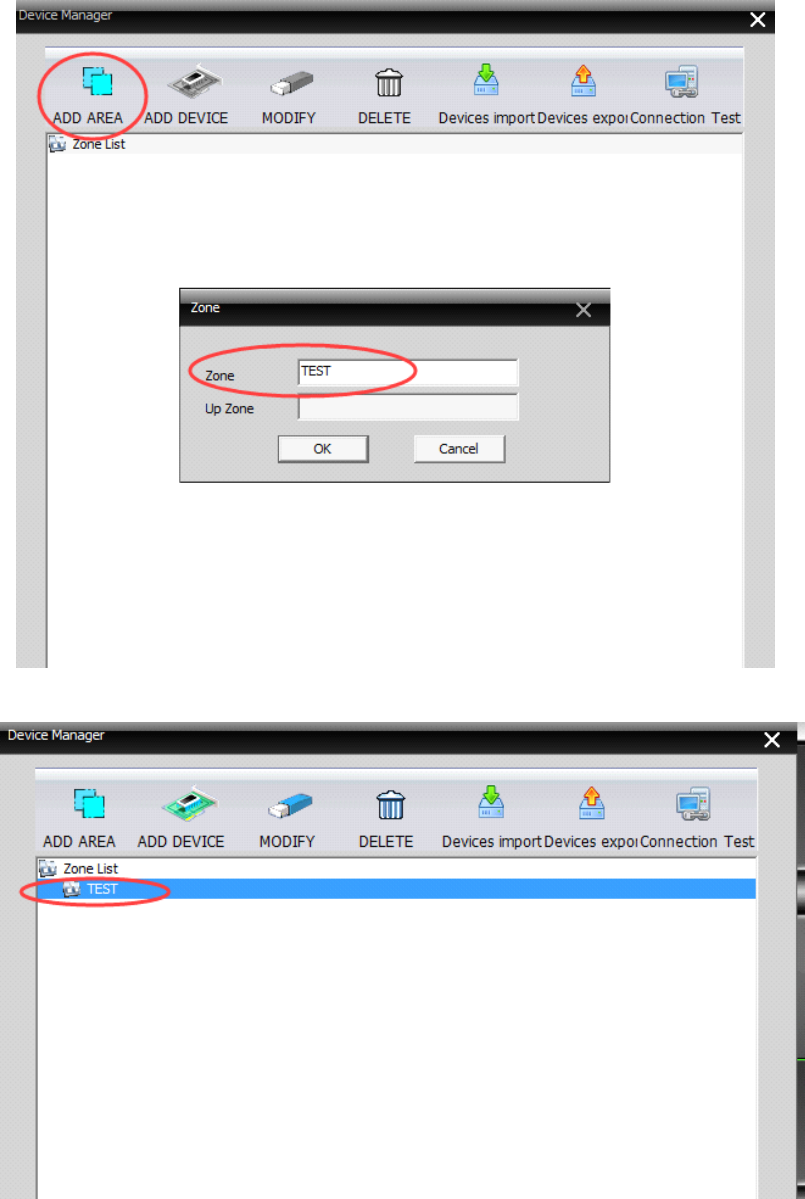
How to add wireless IP camera
1. Find General_CMS software from the CD, and install it on computer
2. C onnect the camera with internet cable and power
3. O pen CMS , click “ system-Device manager “ to add the device . Click “ ADD AREA ” to add
one zone , name the zone yourself .
Choose the added zone with mouse to add device under this zone .
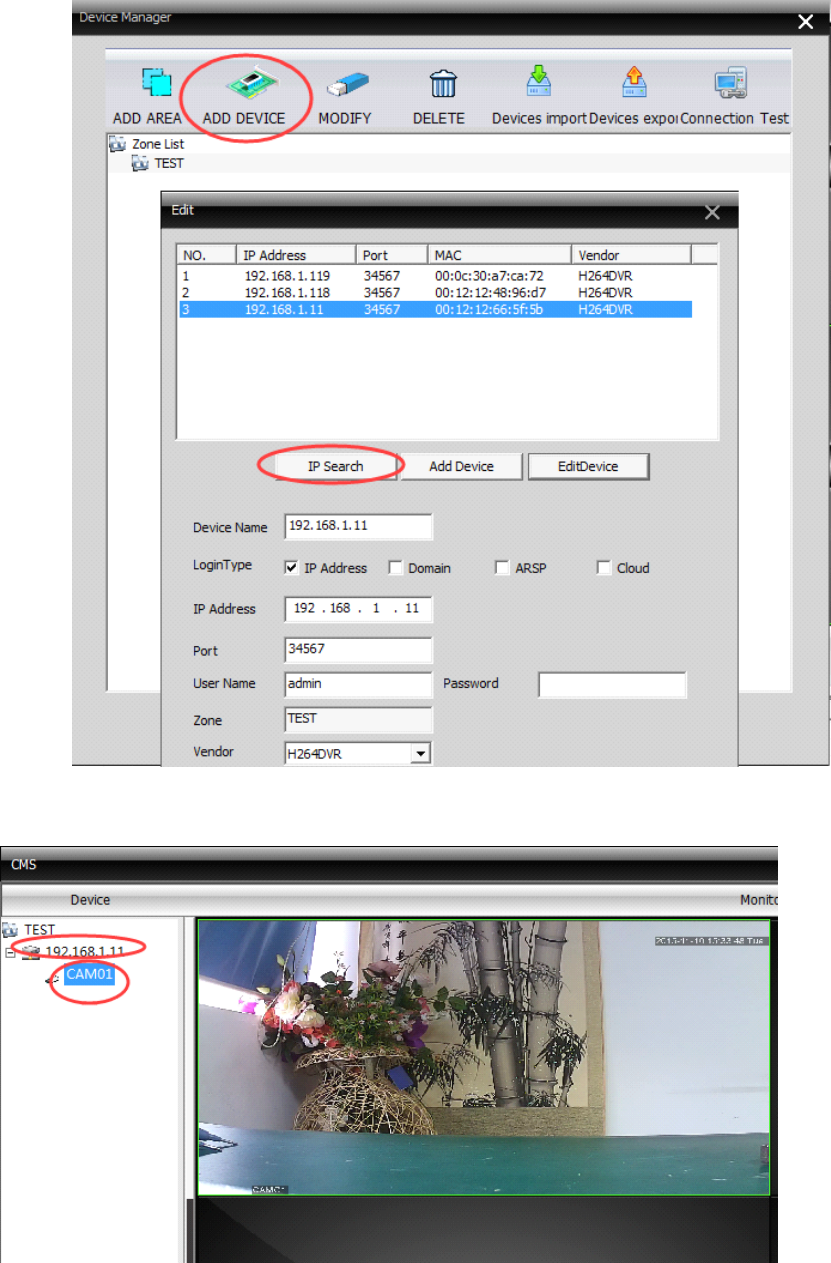
Click “ ADD DEVICE ” - ” IP Search ” , after you search out the IP address , then you click “ OK ” to
save .
Return preview interface, Click the IP address , then you will find channel below the IP address .
Click “ CAM01 ” to connect the camera successfully .
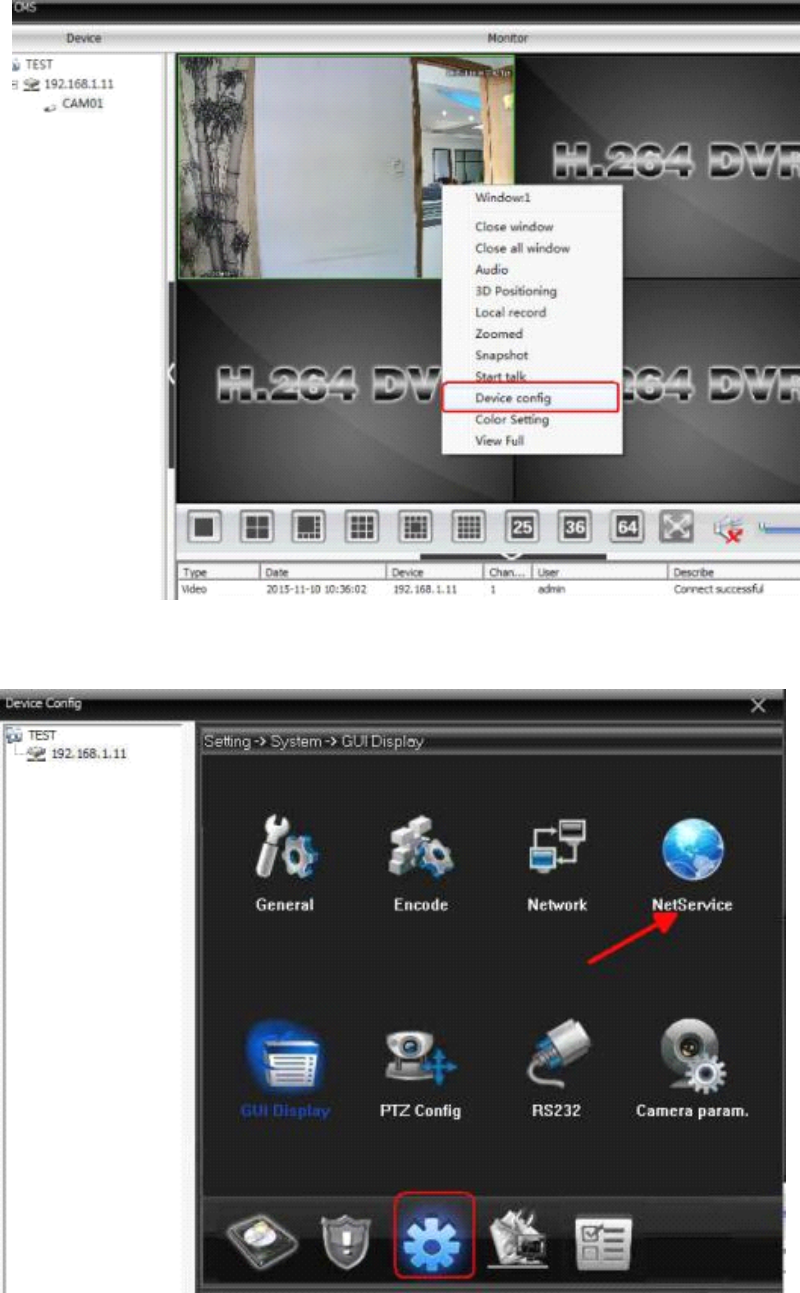
4. After you finish adding , then config the device as below photo, Right click the mouse - Device
config
aaa
Click NetService
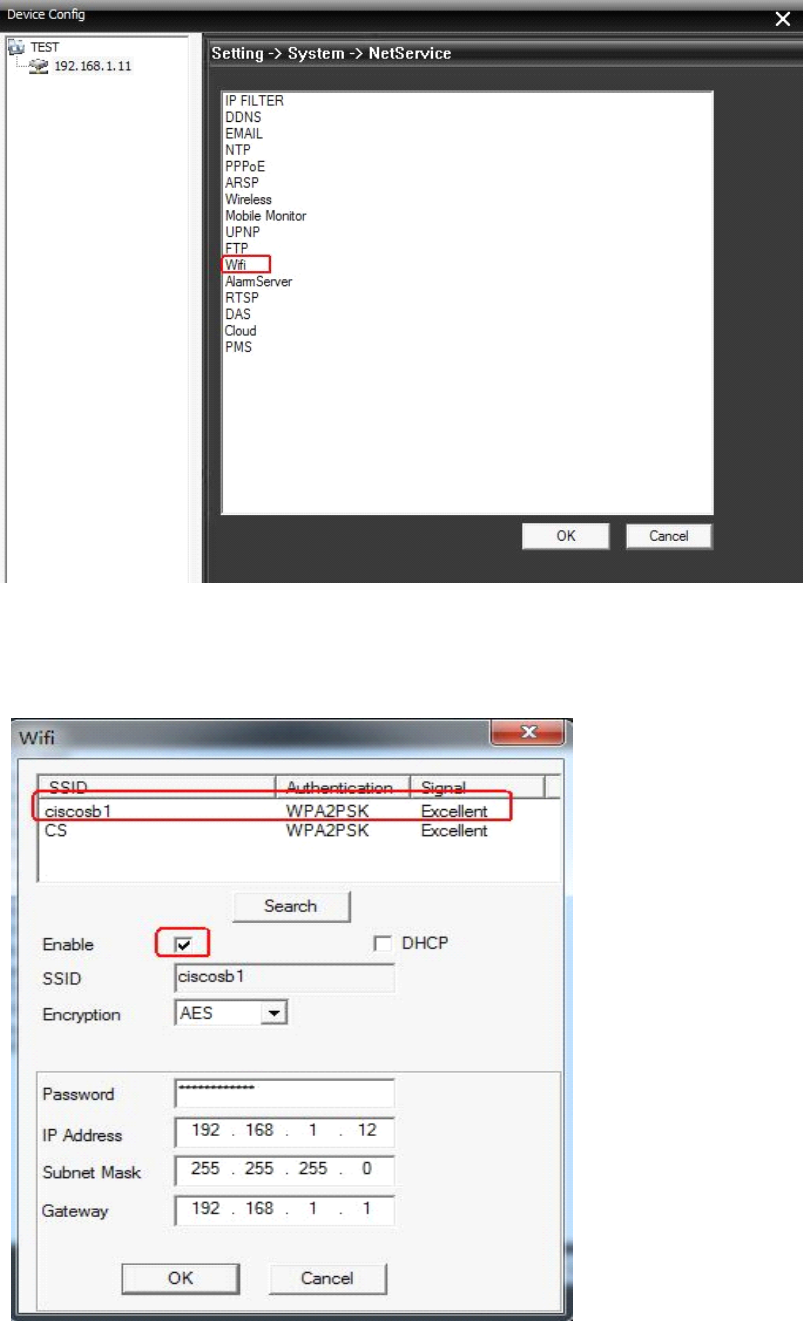
Click wifi to config the wifi
Search out the wifi signal to add it , then click ok to save. Quit the menu setting , move away the
internet cable . Use the CMS to re-search and add the IP address of wireless camera . Finish config.
(Refer Step 3 )
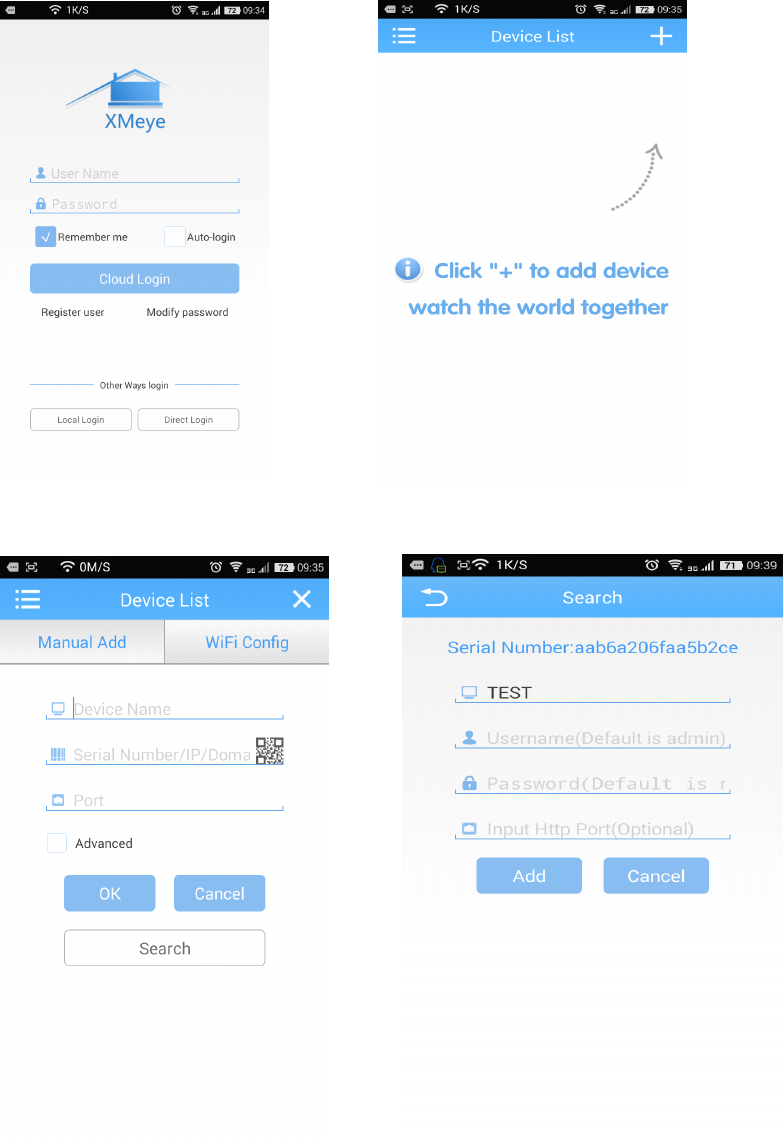
How
How
How
How to
to
to
to add
add
add
add the
the
the
the camera
camera
camera
camera with
with
with
with mobile
mobile
mobile
mobile phone
phone
phone
phone :
:
:
:
1. Download the software “ XMeye ” and install it into mobile phone
2. Open “ XMeye ” , click “ Local Login ” , click “ + ” to add the device
Click Search , then input the device name , user name (Default is admin ), password (Default is
blank ) to add it
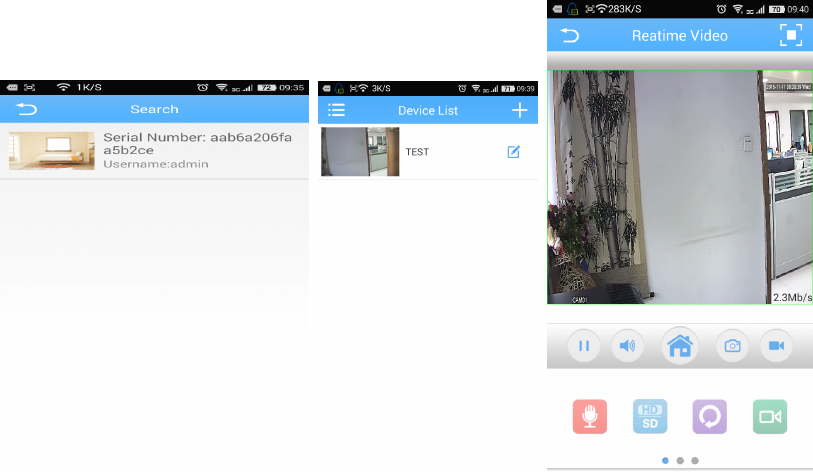
Add the device successfully , then click the device, access the device successfully .

Fcc Statement
This device complies with part 15 of the FCC rules. Operation is subject
to the following two conditions (1)this device may not cause harmful
interference, and (2) this device must accept any interference received,
including interference that may cause undesired operation Changes or
modifications not expressly approved by the party responsible for
compliance could void the user's authority to operate the equipment.
This equipment has been tested and found to comply with the limits for
a Class B digital device, pursuant to Part 15 of the FCC Rules. These limits
are designed to provide reasonable protection against harmful interference
in a residential installation. This equipment generates uses and can radiate
radio frequency energy and, if not installed and used in accordance with
the instructions, may cause harmful interference to radio communications.
However, there is no guarantee that interference will not occur in a particular
installation. If this equipment does cause harmful interference to radio or
television reception, which can be determined by turning the equipment
off and on, the user is encouraged to try to correct the interference by one or
more of the following measures:
-- Reorient or relocate the receiving antenna.
-- Increase the separation between the equipment and receiver.
-- Connect the equipment into an outlet on a circuit different from that to
Which the receiver is connected. - Consult the dealer or an experienced
radio/TV technician for help
The antenna(s) used for this transmitter must be installed to provide a
separation distance of at least 20 cm from all persons and must not be
collocated or operating in conjunction with any other antenna or transmitter,
except in accordance with FCC multi-transmitter product procedures.